One of the first woodlanders to flower here:
Ypsilandra cavaleriei
Comments
Re: Miscellaneous Woodlanders
The name Ypsilandra is unusual, and sort of fun to say. Not very familiar with the genus I looked it up in Flora of China, and I learned a lot about it, the related genera Heloniopsis and our own Eastern US Swamp Pink" Helonias bullata. I share a miscellany of pertinent links.
Ypsilandra is a small genus of 5 species, and only one species each in Heloniopsis and Helonias. At one point, all species were classified as Helonias. The Flora of China separates out Ypsilandra and Heloniopsis by the inflorescence type:
Ypsilandra: Inflorescence racemose or spicate
Heloniopsis: Inflorescence umbellate or umbellate-racemose
Another Ypsilandra species was shown recently on SRGC, Y. thibetica, reminds me of Scilla autumnalis:
http://www.srgc.org.uk/smf/index.php?action=dlattach;topic=6656.0;attach...
From the Flora of China page on Heloniopsis orientalis:
http://www.efloras.org/florataxon.aspx?flora_id=2&taxon_id=114957
...good line drawing:
http://www.efloras.org/object_page.aspx?object_id=60560&flora_id=2
...photo on SRGC
http://www.srgc.org.uk/smf/index.php?action=dlattach;topic=6656.0;attach...
Tanaka (J. Jap. Bot. 73: 102--115. 1998) reduced Heloniopsis and Ypsilandra to synonymy under Helonias. However, a recent molecular phylogenetic study by Fuse and Tamura (Plant Biol. 2: 1--13. 2000) confirmed that Helonias Heloniopsis and Ypsilandra are not mixed with each other, and they each deserve independent generic status.
More discussion on the Helonias, Heloniopsis and Ypsilandra on the Flora of North America site, where the single N.American plant Helonias bullata is covered.
http://www.efloras.org/florataxon.aspx?flora_id=1&taxon_id=114956
Helonias bullata
http://plants.usda.gov/java/profile?symbol=HEBU
Photo taken in Marsha Russell's garden, Littleton, Massachusetts.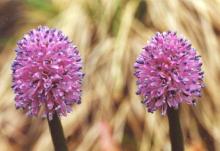
...Helonias bullata image on SRGC:
http://www.srgc.org.uk/smf/index.php?action=dlattach;topic=1722.0;attach...
...New Jersey State publication, scroll halfway down for two photos, one showing habitat:
http://www.state.nj.us/pinelands/science/current/kc/
...US Forest Service page on Helonias bullata:
http://www.fs.fed.us/wildflowers/rareplants/profiles/tep/helonias_bullat...
...photos of Helonias bullata taken at the Garden In The Woods, New England Wild Flower Society, Natick Massachusetts:
http://www.flickr.com/photos/arborboy/386153091/in/faves-7623220@N04/
Re: Miscellaneous Woodlanders
I like Ypsilandra and Heloniopsis a lot too. I'm afraid they wouldn't like your dry summers though :'(. I'm fairly certain Heloniopsis would not survive a year if its roots dry out. I have problems with some of the Heloniopsis, since even though we normally have "Belgian" summers (meaning with a lot of rain and rain and rain...), we sometimes can have very hot and dry summers too. You could try this Ypsilandra since it seems to be a lot stronger, but no guarantees. I didn't sow this plant and it has never set seed for me...I guess the pollinators are absent here (maybe I should start walking around with a paintbrush ;))
Here's another picture of Ypsilandra cavaleriei from today.
Re: Miscellaneous Woodlanders
I've only ever seen Y. cavaleriei and Y. thibetica either. I didn't even know there were three other species. I'll post some pics of Heloniopsis when they are flowering here. As for Helonias: that is a really stunning plant. I've tried it from seed a few times but was never successful. I guess I'll have to buy a plant.
Re: Miscellaneous Woodlanders
Oh my, your Ypsilandra is even more beautiful today... so delicate... gorgeous! :o :o :o
I am planning to make a new garden in a singular low spot (still up on a hill) in my garden, when I envision the ability to grow plants needing more moisture. In spring, I can't mow the grass in this small area until about June because water run-off from the hill passes through and my tractor mower gets stuck in the mud.
Regarding Helonias, this is a true swamp plant, has to be grown with its feet in water, at least that is how I've seen it growing here. North of me, in Southern New Hampshire, Dr. George Newman has a fantastic woodland garden of 4-5 acres, surrounded by wetlands and swamps. He puts "waders" on and plants the swampy areas with Helonias, where they grow to majestic proportions, taller than you might imagine... most impressive. My friend Marsha Russell, grew her plants in large tubs outdoors, the tubs sitting in a 6" deep pool of water in almost full sun; her plants did not grow as tall, but always flowered splendidly.
Re: Miscellaneous Woodlanders
Oh my, your Ypsilandra is even more beautiful today... so delicate... gorgeous! :o :o :o
I thought so too ;)
I am planning to make a new garden in a singular low spot (still up on a hill) in my garden, when I envision the ability to grow plants needing more moisture. In spring, I can't mow the grass in this small area until about June because water run-off from the hill passes through and my tractor mower gets stuck in the mud.
Regarding Helonias, this is a true swamp plant, has to be grown with its feet in water, at least that is how I've seen it growing here. North of me, in Southern New Hampshire, Dr. George Newman has a fantastic woodland garden of 4-5 acres, surrounded by wetlands and swamps. He puts "waders" on and plants the swampy areas with Helonias, where they grow to majestic proportions, taller than you might imagine... most impressive. My friend Marsha Russell, grew her plants in large tubs outdoors, the tubs sitting in a 6" deep pool of water in almost full sun; her plants did not grow as tall, but always flowered splendidly.
With a low spot which stays damp you might be able to grow these plants. I look forward to seeing your project progress.
I've tried sowing Helonias in swamp-like conditions. In the same way I sow Sarracenia, Pinguicula and Drosera. But maybe they need another growing medium than a peat/sand mix?
Re: Miscellaneous Woodlanders
I have been looking for other species of Ypsilandra to grow here. I have had Y thibethica for years and it grows very well in a rather dry position in my woodland.
Picture taken March last spring:
..and a few days later:
It blooms early but not yet this year. I have never seen seed but I think youhave to grow different clones.
Seems that cavaleriei looks abit better but my plant grows in deep shade.
Re: Miscellaneous Woodlanders
Interesting to see these! The Helonias is especially interesting! I wonder how hardy any of these are? None of your areas are cold enough to count...lol
Re: Miscellaneous Woodlanders
Interesting to see these! The Helonias is especially interesting! I wonder how hardy any of these are? None of your areas are cold enough to count...lol
Cohan, my plant has taken severe frost this winter without snow cover - unharmed! (Been down to -16C)
Re: Miscellaneous Woodlanders
Good to know--means it might at least survive part of september here ;)
seriously, of course, you never know--many things survive where you don't expect it--just look at Lori's garden ;D and of course, I don't know how cold it gets where these come from
Re: Miscellaneous Woodlanders
Good to know--means it might at least survive part of september here ;)
seriously, of course, you never know--many things survive where you don't expect it--just look at Lori's garden ;D and of course, I don't know how cold it gets where these come from
Still awake Cohan :o I have just started my new day ;D
What I mean is, if it takes that freezing it surely takes more. The mechanism for tolerating freezing certainly works in that species and the difference - for a plant - between say - 16 and - 30 isn't as big as between 0 and - 16. When the worst of winter strikes your plants are covered in snow I suppose?
Re: Miscellaneous Woodlanders
I was still up--my time is one hour earlier than forum time, so it wasn't even 1 o'clock here :)
Wrightman's has an article on hardiness,
http://www.wrightmanalpines.com/article_6.asp
in which they say:
"Most of the plants we offer are hardy into very cold winter climates (lows of -30°C). Very few plants survive in places where temperatures dip below -40°C as there is an actual physical change in the water molecule below this level and only a few genera have developed the special adaptations needed to survive. Very few customers live in those regions, so it is not a condition we have to consider. "
Statements I find slightly objectionable ;D since, in fact, there are many plants living here, thank-you! and quite a few people too, however, maybe not many folks in Alberta, Saskatchewan, Manitoba etc ordering from Wrightman's....
We don't get many days below -40, it probably has not happened this year, or just barely, we were definitely at -38/-39 at least, a couple of times..however, plants for long term survival here should be able to take it!
Our snow cover is variable, more than Lori, but this is still a relatively dry climate; Usually we have snow before we get -40, but its not at all impossible for some spots (usually under trees, but could happen on a sunny exposed rock garden slope) to be bare in late winter cold spells-bare patches can appear in Feb, even though it wont be all gone for a long time after that, and we just had -38 in March;
Its also highly possible to get -30 any time from late October to December, before the snow cover is established; this year the snow came in mid Nov and has not left, but mid-Dec or later is common for lasting snow.... weeks of nightly frost, many lows to -10 and at least -20 will occur before we have any lasting snow..
Re: Miscellaneous Woodlanders
OK, both dry and cold then!
I recently read that some plants could tolerate -80oC when exposed to low nonfreezing temps in fall! Can't remember which plants but that is much colder than any plants on Earth grow anyway.
I think the coldest temp measured in Norway this winter was almost -50 in December - but that was in the far north! .... and they have lots of nice plants too up there ;D
Re: Miscellaneous Woodlanders
OK, both dry and cold then!
I recently read that some plants could tolerate -80oC when exposed to low nonfreezing temps in fall! Can't remember which plants but that is much colder than any plants on Earth grow anyway.
I think the coldest temp measured in Norway this winter was almost -50 in December - but that was in the far north! .... and they have lots of nice plants too up there ;D
There is a danger for plants which are exposed --sometimes things like native Pyrolas may be exposed in late winter/early spring when the ground is still solidly frozen, and there can be damage to foliage.. of course they recover later, but things like Ledum (wild) don't look as good here as they do in places where snow is reliably deeper (farther west)..
Luckily,most of my yard and gardens present and future is the kind of area that holds snow longer, so most plants wont be exposed too early... fall/early winter is always a question, though....
The comment about the right fall temperatures setting up winter survival are worth noting--2009 we had a very warm fall, then suddenly very cold--it was very hard on plants that normally survive easily here...
Re: Miscellaneous Woodlanders
Hmm, I know that the conventional wisdom says that snow cover is pretty well essential for wintering-over plants and that a lack of snow cover means certain death, but we normally do not have continuous or blanketing snow cover here (the last 3 winters being an exception in the last 14 years)... and on top of that, there are also chinook conditions that can raise the temperature by 30 degrees C in 12 hours. Yet it seems like a really pretty good place to grow perennials nonetheless (admittedly not near so good for woody species).
I dunno... I haven't seen much reason to put a lot of faith in the conventional wisdom in general when it comes to gardening. :)
Re: Miscellaneous Woodlanders
I'm sure it depends a lot on what plant it is, and lots of other hardiness/cultivation factors! Snow cover, like many other things, being a factor some plants appreciate, some don't some couldn't care less :)
I don't know much about garden wisdom, conventional or other wise, but I have clearly seen the impact on some native species, as I mentioned above, of varying snow cover--some of the native evergreen woodland species, such as Pyrolas, are clearly damaged when they are exposed by early melting in Feb, etc, followed, inevitably by deep cold (no doubt wind and sun exposure come into play in this as well, though of course those are components of the bareness to start with!)...their brethren in spots that do not melt early do not suffer the same foliar damage...
I also see a big difference between Ledum here--where it grows commonly in moist woods--versus plants in the foothills and mountains in spots which I presume to have a heavier snowfall (wetter in general, but the places they grow here stay quite moist all year, here, so I don't think its just a moisture issue) plants farther west are much taller, with much healthier looking foliage, our plants often seem to have winter damaged foliage, and don't grow as high, since snow cover is not usually that deep --note 'think' and 'presume' I certainly don't claim to have done scientific study on this subject ;D and there could be some other factor affecting them, unrelated to snow depth!
Both these examples refer to evergreen plants, and woody in the second case, so this doesn't necessarily disagree with Lori's observations...
Also my climate does have some significant if subtle differences from Lori's a little less dry in general, less frequent and less dramatic winter warming episodes, and more/lasting snow.. On my property, these differences are enhanced by forest on two sides, and tree windbreaks on the other two, with a break (driveway!) on one corner--,meaning, this is not a bad place for woodies, in general ;D Other than that, I have no idea yet of the success of alpine and dryland plants in general, here, let alone some of the exotic stuff Lori is growing ;D
Re: Miscellaneous Woodlanders
I just picked up a Ypsilandra thibetica at the WWSW last week. We'll see how it does in Newfoundland where dry summers are not the norm! I have Heloniopsis orientalis in a peaty site. It blooms in late April.
Re: Miscellaneous Woodlanders
Really nice plant, Todd! Good luck with the Ypsilandra--sounds like it should be a good fit for your climate..
Re: Miscellaneous Woodlanders
Todd, Heloniopsis orientalis is a plant I have tried to acquire for years. I have sowed seed several times - no germination :-[ and you never find it in the nurseries here.
Re: Miscellaneous Woodlanders
One of my many treasures from Plant Delights is a Paris polyphylla....I've never grown this before so does anyone have experience with it and can pass along any tips for getting it to thrive? I garden on a lake & streamside under large pines & hemlocks over ledge. I've got Trillium doing quite well and they grow wild all around here. :)
Re: Miscellaneous Woodlanders
I've seen Paris growing under Beech forest, so I expect wherever Trilliums do well, Paris would be equally happy.
Re: Miscellaneous Woodlanders
An obscure genus that I find intriguing is Chloranthus, in its own family Chloranthaceae, a small genus of 18 species, many from tropical to subtropical areas in Asia. Flora of China lists 12 species, and on this years NARGS Surplus Seed List 2 species are available, C. henryi and C. multistachys, although I'm not familiar with them.
The only reason I'm actually aware of the genus, is that I have seen and photographed a Chloranthus sp. in one of Darrell Probst's garden beds full of treasures he collected in China (see image above). Looking through the FOC key, maybe it comes closest to Chloranthus holostegius because of the unbranched stems, and clasping scale-like leaves and terminal whorl of elliptic guard leaves that form a cup holding a small white candle of bloom. Chloranthus holostegius grows up to 2800 m, one of the few species native to such heights, another clue that the hardy plant shown above might be this species.
Such an odd looking plant, but alluring in a strange way.
Re: Miscellaneous Woodlanders
Mark, now I have placed Chloranthus on my wish list! I never really knew how charming it is till I saw your picture! Thanks :D
Re: Miscellaneous Woodlanders
Chloranthus does look pretty cool... the name seems familiar.... a discussion elsewhere recently?
Re: Miscellaneous Woodlanders
That is certainly a charming plant!
Re: Miscellaneous Woodlanders
Interesting... with the flower spike and tripartite leaf, it looks almost like an Asian analogue to vanilla leaf, Achlys triphylla... though it looks like the leaves remain much smaller? (They are not related, however.)
Achlys triphylla, a western North American woodlander: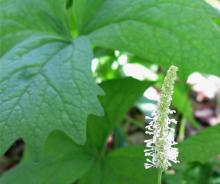
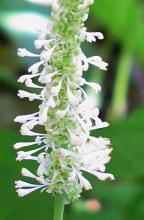
http://plants.usda.gov/java/profile?symbol=ACTR
On the right in this link is Chloranthus japonicus:
http://tolweb.org/Chloranthaceae/20669
Re: Miscellaneous Woodlanders
Interesting... with the flower spike and tripartite leaf, it looks almost like an Asian analogue to vanilla leaf, Achlys triphylla... though it looks like the leaves remain much smaller? (They are not related, however.)
Achlys triphylla, a western North American woodlander:
[attachthumb=1] [attachthumb=2] [attachthumb=3]http://plants.usda.gov/java/profile?symbol=ACTR
On the right in this link is Chloranthus japonicus:
http://tolweb.org/Chloranthaceae/20669
Achlys is nice too! Are you growing this?
Re: Miscellaneous Woodlanders
Yes, another "zone 6" plant... :rolleyes:
I should mention... it spreads around a bit too loosely to be as attractive as Mark's photo of the Chlorathus, but I kind of like it.
Re: Miscellaneous Woodlanders
Some "Woodlanders" which were flowering here in the last week
Heloniopsis orientalis 'Korean form'
Hepatica nobilis 'Rubra Plena'
Corydalis solida 'Elrond'
Corydalis solida 'Loth Lorien'
Two natives of your continent.
Scoliopus bigelovii
and Scoliopus hallii
and Primula maximowiczii in bud.
Re: Miscellaneous Woodlanders
I have to try and track down Scoliopus...what a charming plant.
It seems I need to try a vanilla root...I was dubious if it would survive here but if in Calgary, then no problems!
Re: Miscellaneous Woodlanders
Wim, I can't wait to see the Primula maximowiczii! Not meaning to spoil the coming surprise, but a true red primula - wow! I grew it for a couple (or 3?) years and then, poof, it was gone... and I had not saved seed for myself (donated it all, foolishly :rolleyes:).
Scoliopus is interesting. I wonder how hardy it is? Is it difficult from seed?
Re: Miscellaneous Woodlanders
I wonder how hardy it is? Is it difficult from seed?
Lori, It must be quite hardy...I bought a P. maximowiczii from Cady's Falls Nursery in Morrisville, VT a couple years ago, a zone 4 nursery. But it never made it through the first summer...too hot I think. I've got seed of it from the Primrose society seed-ex and I'm going to try again. I would also like to know of any germinating tips for it.
Re: Miscellaneous Woodlanders
Yes, another "zone 6" plant... :rolleyes:
I should mention... it spreads around a bit too loosely to be as attractive as Mark's photo of the Chloranthus, but I kind of like it.
one to watch for seed of, then :) loose is ok, best intermingled with something else, then, I guess..
Re: Miscellaneous Woodlanders
P. maximowiczii lasted here for 2-3 years, so seemingly pretty hardy, though I cannot claim it was long-lived! Flora of China says it's a perennial.
http://www.efloras.org/florataxon.aspx?flora_id=2&taxon_id=200017319
I bought my plant, as you did, and have not yet tried it from seed.
Re: Miscellaneous Woodlanders
The Scoliopus are very interesting! I've only seen them on SRGC, and somehow didn't have any accurate image in mind....
Re: Miscellaneous Woodlanders
Wim, love seeing the two Scoliopus species; I find it fascinating how such North American treasures are more often grown in Europe than here. And to see S. hallii, that's a double treat as it is much less commonly grown. I first encountered Scoliopus in NARGS member's gardens in the greater Seattle Washington area, and was totally charmed by these little munchkins (with a terrible common name of Fetid Adder's Tongue). Have not tried growing there here in New England, but they are most definitely on my list. Wim, are the flowers bad smelling, to earn their name?
http://plants.usda.gov/java/profile?symbol=SCOLI
Re: Miscellaneous Woodlanders
More than once have I considered Scoliopus but never acquired any. No I have to reconsider that!
Re: Miscellaneous Woodlanders
That Scoliopus is a beaut. Kinda has a funny distribution:
http://www.efloras.org/object_page.aspx?object_id=8123&flora_id=1
Is that because of the mountain rain shadows?
Re: Miscellaneous Woodlanders
That Scoliopus is a beaut. Kinda has a funny distribution:
http://www.efloras.org/object_page.aspx?object_id=8123&flora_id=1
Is that because of the mountain rain shadows?
It doesn't like neither California nor Washington ;)
Re: Miscellaneous Woodlanders
Wim, I can't wait to see the Primula maximowiczii! Not meaning to spoil the coming surprise, but a true red primula - wow! I grew it for a couple (or 3?) years and then, poof, it was gone... and I had not saved seed for myself (donated it all, foolishly :rolleyes:).
Scoliopus is interesting. I wonder how hardy it is? Is it difficult from seed?
Hi Lori,
if I get some seed of P. maximowiczii this year I can send you some.
I have no idea how hardy Scoliopus is. And I have never sown them myself but I heard from some friends they are really easy from seed. For more info about Scoliopus sowing you can have a look here: http://www.srgc.org.uk/bulblog/log2006/080606/log.html, http://www.srgc.org.uk/bulblog/log2007/210607/log.html and http://www.srgc.org.uk/logs/logdir/2009Jun171245243874BULB_LOG__2409.pdf.
Lori, It must be quite hardy...I bought a P. maximowiczii from Cady's Falls Nursery in Morrisville, VT a couple years ago, a zone 4 nursery. But it never made it through the first summer...too hot I think. I've got seed of it from the Primrose society seed-ex and I'm going to try again. I would also like to know of any germinating tips for it.
Amy,
I sowed P. maximowiczii as soon as I received the seeds (I got them in June of 2009). I think the seeds need to be sown as fresh as possible. I surface sowed them on some leafmould and they germinated very quickly. Just make sure they never dry out and they don't like direct sunlight
Re: Miscellaneous Woodlanders
Wim, are the flowers bad smelling, to earn their name?
They have a very typical smell indeed, a bit like a dog which hasn't been washed in ages and just ran trough the rain. I've heard the smell can be very strong if grown in a greenhouse and if you have large groups of them in your garden. Here I have to lean in very close to smell it, which I don't do very often...wet dog is not my favorite smell ;D ;)
That Scoliopus is a beaut. Kinda has a funny distribution:
http://www.efloras.org/object_page.aspx?object_id=8123&flora_id=1
Is that because of the mountain rain shadows?
Rick,
the distribution pattern of Scoliopus hallii is weird indeed (quite border-bound for a plant ???)...I'm curious about that too?
Edit by Wim: It only grows to an elevation of 800 m, so I guess the white spot in the middle of the distribution pattern is where the Cascade Mountains are higher than 800 m?
Re: Miscellaneous Woodlanders
We have lots of this plant around the garden, all raised from seed, and we are rarely without out a flower from late December until early May. Despite what has been written about it not producing seeds in cultivation ( for instance in Alf Evans book, 'the Peat Garden') we have always had good seed set on our plants.
This year the flowers are later and are only just beginning.
We grow Scoliopus bigelovii and S. hallii . We love them both but you could be thought crazy for wanting them as they are curious little flowers, especially hallii, that you could easily walk past and never see.

Scoliopus bigelovii and S. hallii
Both of these are growing in fish box troughs but we also have them growing and self seeding in the open garden. The secret of keeping them growing is never let them dry out or get too hot in the summer, they do not like it.
The bigelovii has lovely spotted leaves while the foliage is young though the spots fade as the foliage matures. S. hallii has plain, brighter green leaves.
The hallii flowers are at most 15mm across... just adorable little things.
The smell is not one you'd want to be cooped up with, but it can be quite pleasant if all you get is a quick whiff in passing! ;D ;D
The veining and marking o nthe slightly larger bigelovii flowers is really gorgeous.
These guys are real favourites of mine!
Here are a couple of other Bulb Log Links about Scoliopus...
http://www.srgc.org.uk/bulblog/190303/log.html
http://www.srgc.org.uk/bulblog/log2005/010205/log.html
Of course, they are named for Mr Bigelow, so the "v" is a twist.
http://www.marin.edu/cnps/Bigelow.html
Maggi
Edit: oops , didn't add the second pic as a thumbnail! Fixed now... click to enlarge!)
Re: Miscellaneous Woodlanders
On close examination, the flowers are quite exquisite!
If the distribution is below 800m, I expect the hardiness rating is not too high, but then Vancouveria is rated zone 6-7 and Lori has it in Calgary (zone 3) so who knows the ultimate hardiness of Scoliopis.
Re: Miscellaneous Woodlanders
We have lots of this plant around the garden, all raised from seed, and we are rarely without out a flower from late December until early May. Despite what has been written about it not producing seeds in cultivation ( for instance in Alf Evans book, 'the Peat Garden') we have always had good seed set on our plants.
This year the flowers are later and are only just beginning.We grow Scoliopus bigelovii and S. hallii . We love them both but you could be thought crazy for wanting them as they are curious little flowers, especially hallii, that you could easily walk past and never see.
Scoliopus bigelovii and S. hallii
Both of these are growing in fish box troughs but we also have them growing and self seeding in the open garden. The secret of keeping them growing is never let them dry out or get too hot in the summer, they do not like it.
The bigelovii has lovely spotted leaves while the foliage is young though the spots fade as the foliage matures. S. hallii has plain, brighter green leaves.
The hallii flowers are at most 15mm across... just adorable little things.
The smell is not one you'd want to be cooped up with, but it can be quite pleasant if all you get is a quick whiff in passing! ;D ;D
The veining and marking o nthe slightly larger bigelovii flowers is really gorgeous.
These guys are real favourites of mine!
Here are a couple of other Bulb Log Links about Scoliopus...
http://www.srgc.org.uk/bulblog/190303/log.html
http://www.srgc.org.uk/bulblog/log2005/010205/log.html
Two pix of S. bigelovii
Of course, they are named for Mr Bigelow, so the "v" is a twist.
http://www.marin.edu/cnps/Bigelow.htmlMaggi
Edit: oops , didn't add the second pic as a thumbnail! Fixed now... click to enlrage!)
Yes, very cool plants for sure!
Re: Miscellaneous Woodlanders
On close examination, the flowers are quite exquisite!
If the distribution is below 800m, I expect the hardiness rating is not too high, but then Vancouveria is rated zone 6-7 and Lori has it in Calgary (zone 3) so who knows the ultimate hardiness of Scoliopis.
The intricate shapes and markings of the flowers repay close attention, that's for sure. There are deep furrows with the markings, very sculptural.
We've had the Scoliopus bigelovii down to minus 19 C for a longish spell some years ago and this year to around minus ten for longer than we liked so it's proving tough enough for N. E. Scotland.
Re: Miscellaneous Woodlanders
I found a good video showing Scoliopus bigelovii being pollinated by fungus gnats. Some excellent close-up views of the flowers too. You might want to turn down the music or mute it on this one, but all in all, a rare treat; would like to see more plant-related videos.
Screen capture of the YouTube video, this user BotanyVideo has a number of good ones to watch.
Scoliopus bigelovii - pollination
(tip: if you have high-speed internet, hit the "full screen" button on the right right, hit ESC to return screen to normal)
Re: Miscellaneous Woodlanders
Some Thalictrum thalictroides in flower here now:
T thalictroides 'Babe'
T thalictroides 'Betty Blake'
T thalictroides 'Big'
T thalictroides 'Diamant'
T thalictroides 'Jade Feather'
T thalictroides 'Pink Diamant'
T thalictroides 'White Singel'
and T thalictroides 'XXL'
and two other shade lovers:
Glaucidium palmatum and Uvularia grandiflora 'Gold Leaf Form'
Re: Miscellaneous Woodlanders
Beautiful, Wim. The native Thalictrum thalictroides (we call them May flowers) are barely detectable at the soil surface here.
And our native Uvularia grandiflora are a half inch high. Does your Gold Leaf Form have leaves that turn yellow later? It looks like normal leaf color in your photo...
Re: Miscellaneous Woodlanders
Beautiful, Wim. The native Thalictrum thalictroides (we call them May flowers) are barely detectable at the soil surface here.
And our native Uvularia grandiflora are a half inch high. Does your Gold Leaf Form have leaves that turn yellow later? It looks like normal leaf color in your photo...
Hi Rick,
The leaves get a bit more yellow but it's not very spectacular...I wouldn't have given it a cultivar name. I've heard there's an orange flowering Uvularia going around. Anyone ever seen it?
Re: Miscellaneous Woodlanders
interesting to see the Thalictrum, our local sp has sprays of tiny flowers, and flowers in summer,,
Rick, on your wild T thalictroides, are the flowers at all large like these cultivars?
Re: Miscellaneous Woodlanders
The plants Wim showed with the beautiful showy flowers were previously distinguished from Thalictrum, and referred to as a different genus (for obvious reasons!)- Anemonella - but have been since been lumped. ??? (I'm sure there is some reason but come on!!) Anemonella/Thalictrum are are hardy here though, and may be worth trying in your area, Cohan?
Re: Miscellaneous Woodlanders
I actually had that in my mind, Lori, (Anemonella) but didn't look it up to check..
I'm always interested in woodlanders ;D that's why I was curious about Rick's native form.... I've looked at-- I think-- some Asian/Russian sp on some seed lists.. among thousands of other things ;D
Re: Miscellaneous Woodlanders
Rick, on your wild T thalictroides, are the flowers at all large like these cultivars?
It's a hard to tell, but judging from leaf and petal size comparison and the angle of Wim's close up photos, my wild ones in the garden seem pretty close to the same size. I think Wim could answer better if he looks at the pics below. In the wild, as you would expect, size is quite variable, but overall a bit smaller. I have one cultivar, Schoaff's Double, and its flower width is definitely smaller, but it sure packs on the "petals".
1-2. Thalictrum thalictroides - indigenous type in the garden
3. Thalictrum thalictroides 'Schoaff's Double'
Re: Miscellaneous Woodlanders
Rick, on your wild T thalictroides, are the flowers at all large like these cultivars?
It's a hard to tell, but judging from leaf and petal size comparison and the angle of Wim's close up photos, my wild ones in the garden seem pretty close to the same size. I think Wim could answer better if he looks at the pics below. In the wild, as you would expect, size is quite variable, but overall a bit smaller. I have one cultivar, Schoaff's Double, and its flower width is definitely smaller, but it sure packs on the "petals".
1-2. Thalictrum thalictroides - indigenous type in the garden
3. Thalictrum thalictroides 'Schoaff's Double'
Thanks for that, Rick--no doubt the cultivars have some bigger flowers--at least the names suggest it ;D but the wild form looks perfectly charming :) I'll have to watch for seed.. I do like colour variants, but tend to be less fond of doubles or other sorts of cultivars-- though I find it endlessly fascinating to see what can be coaxed out of a plant's genome!
Re: Miscellaneous Woodlanders
I have well over a dozen plants, and they seed and volunteer profusely. Those pics are from 2005. I'll try to remember you when seed ripens, Cohan. They bloom for a very long time in the garden, early May through June, and even into July since they don't seem to have such a driving ephemeral instinct like they do in the woods. Feel free to remind me in early June. :)
Re: Miscellaneous Woodlanders
thanks, Rick, that would be great :)
Re: Miscellaneous Woodlanders
interesting to see the Thalictrum, our local sp has sprays of tiny flowers, and flowers in summer,,
Rick, on your wild T thalictroides, are the flowers at all large like these cultivars?
Cohan,
I have some wild-collected (from seed) Th. thalictroides too and they all have smaller flowers but I've heard they can be very variable in the wild and I think European sellers want to make a quick buck by giving different name to barely different clones (like 'Big' and 'XXL' for example, both form the same seller).
Re: Miscellaneous Woodlanders
Wim-- nothing new or surprising there :) I heard of someone who collected cacti in South America for a European nursery, many years ago--they were paid by the number of 'species' they found.. you can imagine there were a lot more species found than reason would dictate ;D
Nowadays there is probably more money in named cultivars..... :rolleyes:
Oh well, as long as you can see the plant you are buying, and you like it, doesn't matter what they call it...lol
Re: Miscellaneous Woodlanders
This is Mertensia virginica. A plant native in the USA. In my part of the world seldom seen in culture. I wonder if you regard this plant as special, or regard it as almost weed. I understand one won't grow a plant in his garden, while it grows in everybody's garden.
Myself I like it very much, because of it's color,a deep, heavenly blue.
Re: Miscellaneous Woodlanders
A lovely plant, Gerrit, not native here, but we have M paniculata, a very common wild plant here, but one which I love--it can form very nice full stands, and there are a number of them on my property, as well as roadsides and open woods throughout the area.. I doubt it is much grown in gardens, but if it wasn't native to my land, I'd surely plant it ! There are nice alpine species as well, for those with less space!
two shots from 'wild' places on the farm,
And a nice clump under a spruce tree (dry place!!) where we store our lawnmower! year before this patch was even more impressive...
Re: Miscellaneous Woodlanders
This is Mertensia virginica. A plant native in the USA. In my part of the world seldom seen in culture. I wonder if you regard this plant as special, or regard it as almost weed. I understand one won't grow a plant in his garden, while it grows in everybody's garden.
Myself I like it very much, because of it's color,a deep, heavenly blue.
Gerrit, I would love to grow M virginica and have tried to establish it several times but the slug think I plant them for their sake and devour the plants almost before I have left the site.
Re: Miscellaneous Woodlanders
not sure if these qualify as woodlanders but here is Meconopsis punicea flowering for me now. In the main picture the one second from the left is clearly a hybrid
Re: Miscellaneous Woodlanders
not sure if these qualify as woodlanders but here is Meconopsis punicea flowering for me now. In the main picture the one second from the left is clearly a hybrid
Pretty plants! I have tried to establish M punicea here for years but without success so far.....
Re: Miscellaneous Woodlanders
Mertensia virginica (Virginia Bluebells) is fairly common among shade gardeners here, although fairly difficult to find in nurseries. It is well loved, and though it is native in Minnesota, it is only abundant in the very southeast portion of the state. Some gardeners find it a bit weedy, but easy to control, while most are delighted with the gentle self seeding. Two State parks are especially famous for their natural ephemeral wildflowers, and each have quarter acre areas of mostly Virginia bluebells, with Erythronium spp., Enemion (Isopyrum) biternatum, Thalictrum spp., Asarum canadense, Uvularia grandiflora, etc. They are truly a sight to see.
Mertensia paniculata grows in the northern half of Minnesota, and I grew a plant at my parents (along with Mertensia virginca) for many years when I was growing up. Some years after I moved out, my brother (the machinist turned self proclaimed naturalist) destroyed it while it was dormant, replacing it with Wild Ginger. :'( Our form has a much more metalic blue color that practically sparkles, rather than your matte baby blue, Cohan. The shape is more rigid and regular, too.
Re: Miscellaneous Woodlanders
not sure if these qualify as woodlanders but here is Meconopsis punicea flowering for me now.
Wow, most enviable, Tony! Meconopsis tend to need special conditions to survive here in "The Big High and Dry" (as I've seen it described by a local gardening writer :)) any more than a season or two... which I'm much too lazy to provide...
This is Mertensia virginica. A plant native in the USA. In my part of the world seldom seen in culture. I wonder if you regard this plant as special, or regard it as almost weed.
Definitely special! (And I rigorously distinguish native plants from weeds, as well. Having said that, it just depends on the native plant's habits, and how well I can grow it, as to whether I keep it in the garden.)
Both the natural areas and your sadly-missed planting sound wonderful, Rick.
I loving seeing our native M. paniculata also. I find it rather spready in the garden... given that I don't have unlimited space, I think I will be pulling a few more offshoots out next year.
I like Mertensia ciliata in the garden, and have lots these days from seeding... and please correct me (always) if I'm misidentifying this!... not native here, but no doubt a locally-native plant for someone on this forum. One strange thing... these used to go dormant for me after the spring bloom, but have ceased doing that in the last 3 years or so ( ???), and in fact, get lax and floppy enough that I cut them back.
The emerging foliage is a gorgeous dusky purple-green, as shown in this older photo (the foliage was barely breaking the ground on the most precocious plant last weekend, before the latest snow). Here are also photos of it in bloom.
Re: Miscellaneous Woodlanders
I've also been growing Mertensia ciliata for a number of years, at least that's what I got it as (I'm adding a few pictures). I have it in a fairly open sunny location and perhaps because of that it looks taller than Lori's plant. I also cut it right back as it falls over. I'm looking forward to comparing with M. paniculata which I planted out last year (from seed that Cohan kindly sent).
Re: Miscellaneous Woodlanders
not sure if these qualify as woodlanders but here is Meconopsis punicea flowering for me now. In the main picture the one second from the left is clearly a hybrid
Wonderful colour! Is this the mature form of the flower? Very interesting... Does the species name refers to pomegranates, presumably for the colour?
Re: Miscellaneous Woodlanders
not sure if these qualify as woodlanders but here is Meconopsis punicea flowering for me now. In the main picture the one second from the left is clearly a hybrid
Wonderful colour! Is this the mature form of the flower? Very interesting... Does the species name refers to pomegranates, presumably for the colour?
My understanding is the word relates to red which is also the colour of pomegranates but there are numerous other plants with it in their name
Re: Miscellaneous Woodlanders
Yes, according to the site below, "puniceus" is purple, red, or reddish:
http://humanum.arts.cuhk.edu.hk/Lexis/Latin/
Re: Miscellaneous Woodlanders
M ciliata seems nice.. there are several species on Alplains' list I am thinking about .. I'd want something quite distinct from paniculata, since there is so much of that here! Lori, I wonder if ciliata has not gone dormant the last two years since we didn't have summer? ;) and the year before that was record rainfall, though warm, here, not sure about Calgary..
BTW, I wonder if paniculata would be considered ephemeral in a longer/hotter summer? By the time they are dying down here, summer is over anyway!
Re: Miscellaneous Woodlanders
BTW, I wonder if paniculata would be considered ephemeral in a longer/hotter summer? By the time they are dying down here, summer is over anyway!
I've never noticed if M. paniculata goes summer dormant in Northern Minnesota. I haven't traversed areas where it is at that time of year. While it did go dormant near St. Paul, MN (southcentral MN), I am not sure if it was because of the heat or the dry. It was planted on an oak forested hillside with a gravel/sand subsoil.
Re: Miscellaneous Woodlanders
I don't find that M. paniculata goes dormant here in the garden, and where it grows in natural spots along the bike path, I think I see it all through the summer too - there, it's on a shaded steep slope that has many springs. I'll have to pay more attention this year to confirm that.
As I think about it, it was probably a lot more than 3 years ago that M. ciliata stopped going dormant in my yard... I can't think of any particular weather pattern that coincided. It's strange, anyway.
Re: Miscellaneous Woodlanders
Mertensia virginica (Virginia Bluebells) is fairly common among shade gardeners here, although fairly difficult to find in nurseries. It is well loved, and though it is native in Minnesota, it is only abundant in the very southeast portion of the state. Some gardeners find it a bit weedy, but easy to control, while most are delighted with the gentle self seeding. Two State parks are especially famous for their natural ephemeral wildflowers, and each have quarter acre areas of mostly Virginia bluebells, with Erythronium spp., Enemion (Isopyrum) biternatum, Thalictrum spp., Asarum canadense, Uvularia grandiflora, etc. They are truly a sight to see.
Mertensia paniculata grows in the northern half of Minnesota, and I grew a plant at my parents (along with Mertensia virginca) for many years when I was growing up. Some years after I moved out, my brother (the machinist turned self proclaimed naturalist) destroyed it while it was dormant, replacing it with Wild Ginger. :'( Our form has a much more metalic blue color that practically sparkles, rather than your matte baby blue, Cohan. The shape is more rigid and regular, too.
This was a very interesting discussing about Mertensia. Thank all authors. By the way: Rick, did you forgive your brother?
Gerrit
Re: Miscellaneous Woodlanders
I don't find that M. paniculata goes dormant here in the garden, and where it grows in natural spots along the bike path, I think I see it all through the summer too - there, it's on a shaded steep slope that has many springs. I'll have to pay more attention this year to confirm that.
M paniculata grows in sunny, shady, wet and dry places here; none of them go dormant before fall frosts, but summer is so short I hardly think it counts...lol.. I can't think offhand of any native plants in my area that go dormant before summer is over.. why would they?..lol
Re: Miscellaneous Woodlanders
By the way: Rick, did you forgive your brother?
Gerrit
I would blow up if I held grudges.
There's the time he fell a large ash tree and destroyed my only two Paw Paw trees; when he decided to clear the part of the woods one fall where I had planted fruiting Viburnum trilobum and Liparis lilifolia, and where Galearis (Orchis) spectabilis grew naturally; when he decided to cut down some ancient and very picturesque native Nanyberry Viburnum understory trees; when he decide it was a good idea to cut all the forest edge small trees and shrubs so he could see into the woods -- it let so much light in that it is now a tangle of invasive buckthorn and the wildflowers that used to thrive there are all but gone....shall I go on? (This would be a whole chapter if I were to write a memoir.)
Oh, and the crème de la crème: we use to have a small hillside where morel mushrooms grew. He decided to build a road for the tractor there.
Re: Miscellaneous Woodlanders
Oh my! one man destroyer of the forest! ;)
Re: Miscellaneous Woodlanders
Well Rick, I'm looking forward to read your memoirs. It's clear you have talent. (and of course a brother)
Thanks for posting this 'funny' story.
Gerrit.
Re: Miscellaneous Woodlanders
Well, Rick, I am glad he isn't my brother - or rather that my sister hasn't done anything like that yet :o
Re: Miscellaneous Woodlanders
Some Calanthes flowering here:
Calanthe tricarinata
and Calanthe hancockii
Re: Miscellaneous Woodlanders
Nice Calanthes, Wim.
I have tried some in my woodland but they are prone to slug damage.
However, this blue corydalis is unaffected by slugs.
Re: Miscellaneous Woodlanders
;)Calanthes are very sweet!
So's blue Cory :)
Re: Miscellaneous Woodlanders
The lateflowering Scilla lilio-hyacinthus has started its show in the woodland. Very shade tolerant (notice the broad leaves) and moderately expanding by bulbs and seed.
Also blooming now is the latest of the Anemone nemorosa types I have, seedlings of some blue popping up many places in the garden and woodland. They are among the biggest of the kind too.
Re: Miscellaneous Woodlanders
Very nice, Trond and Wim!
I think I'd need a constant drip irrigation system to keep the blue corydalis happy here - I've seen them do reasonably well in gardens where they are watered daily (a notion that shocks me!) For me, they come back but dwindle from year to year, and my guess is it's way too dry, though I don't think hardiness seems to be a problem (have only tried the more commonly-available ones).
Re: Miscellaneous Woodlanders
I cannot grow the blue corydalis either...and dryness is not a problem here. Can't figure out what the issue is ???
Pulmonaria montana blooming at the moment, along with Helleborus orientalis and first Corydalis solida.
Re: Miscellaneous Woodlanders
Trond, the wide leaves on the Scilla are very nice, as are the pale Anemones..
Lori, I'm with you on the watering! I think perennial beds should rarely if ever need watering once established! Though it might be easy for me to say, since parts of my property are not very dry generally--really depends on the year, though! Things are pretty soggy currently, with snow still to melt in places..
Todd--the Pulmonaria is a really nice colour, and nice change to typical spring colours..
Re: Miscellaneous Woodlanders
Very nice, Trond and Wim!
I think I'd need a constant drip irrigation system to keep the blue corydalis happy here - I've seen them do reasonably well in gardens where they are watered daily (a notion that shocks me!) For me, they come back but dwindle from year to year, and my guess is it's way too dry, though I don't think hardiness seems to be a problem (have only tried the more commonly-available ones).
The blue corydalis I show here is a species with corms and it is ephemeral, although not as shortflowering as the solida types. It also tolerates relatively dry summers. The other kinds of blue corydalis have rhizomes and need moist soil. They are much later flowering too.
I can't remember the name of it but probably did I buy it from Janis Ruksans.
Re: Miscellaneous Woodlanders
Trond, Corydalis turczaninovii is tuberous, I think. Could that be it?
Very nice, indeed. Wouldn't mind any seed of that, if it makes any...
Re: Miscellaneous Woodlanders
Rick, for some reason my B. ciliata never sets seed ??? I've had many requests over the years. I've never heard of a pulsatilla that won't set seed yet my P. flavescens doesn't...I have a strange garden!
Re: Miscellaneous Woodlanders
Todd and Lori,
did you ever try Corydalis x 'Craigton Blue' from Ian Young? It grows very easily in almost any condition (I grow it in the shade but I've seen it grown in full sun too). Or do you want to grow a pure species blue one?
Todd, love the reddish Pulmonaria. A very nice color.
Re: Miscellaneous Woodlanders
Some other shade-plants...more for the leaves than for the flowers and very prone to slug-damage:
Mini-hosta's:
'Cat's Eye'
'Dew Drop'
'Pandora's Box'
'Sunlight Child'
venusta 'Minuet
Re: Miscellaneous Woodlanders
And some more flowering shade-lovers which I almost forgot:
Meconopsis quintuplinervia x betonicifolia (a perennial form)
Paris bashanensis
Primula japonica 'Miller's Crimson'
Ramberlea
Ramonda myconi 'Alba'
and Ramonda myconi
Re: Miscellaneous Woodlanders
Pulmonaria montana blooming at the moment, along with Helleborus orientalis and first Corydalis solida.
Your lungwort looks like what I have under the name P. rubra, an occasional garden escape around here - it's also in flower here:
Re: Miscellaneous Woodlanders
Rick, for some reason my B. ciliata never sets seed ??? I've had many requests over the years.
Er...um... not that I don't like your Bergenia, Todd, but I was hinting to Trond about seed from for his blue Corydalis. ;D
----------------------------
The corms of Aconitum incisifidum are evident in this photo:
Re: Miscellaneous Woodlanders
Wim, I must be mistaken-- I thought I remembered you said you had a small garden? But the plants keep coming.......
nice blue cory for sure :)
Re: Miscellaneous Woodlanders
Wim, I must be mistaken-- I thought I remembered you said you had a small garden? But the plants keep coming.......
nice blue cory for sure :)
Small garden, packed with plants ;) ;)
Re: Miscellaneous Woodlanders
Just to go back to Ypsilandra from earlier in this thread - they propagate well from leaf cuttings, either cut into short sections or simply looped into the compost, they will root at both ends. This is a great way of propagating quite a range of plants (also good for Eucomis), and always quite a surprise when you prick out the small plantlets. Having said that I struggle with it here through our dry summers but it can make a superb specimen in a pot.
Re: Miscellaneous Woodlanders
Just to go back to Ypsilandra from earlier in this thread - they propagate well from leaf cuttings, either cut into short sections or simply looped into the compost, they will root at both ends. This is a great way of propagating quite a range of plants (also good for Eucomis), and always quite a surprise when you prick out the small plantlets. Having said that I struggle with it here through our dry summers but it can make a superb specimen in a pot.
I did not know that Ypsilandra would come from leaf cuttings.... will be trying it soon, though.... thanks Tim!
MY
Re: Miscellaneous Woodlanders
Trond, Corydalis turczaninovii is tuberous, I think. Could that be it?
Very nice, indeed. Wouldn't mind any seed of that, if it makes any...
OK, I'll be at the lookout! The oldest flowers fade now and I can discern small seedpods. Hope they last!
I think I have planted turczaninovii from Janis once, so maybe . . . .
Re: Miscellaneous Woodlanders
Just to go back to Ypsilandra from earlier in this thread - they propagate well from leaf cuttings, either cut into short sections or simply looped into the compost, they will root at both ends. This is a great way of propagating quite a range of plants (also good for Eucomis), and always quite a surprise when you prick out the small plantlets. Having said that I struggle with it here through our dry summers but it can make a superb specimen in a pot.
I did not know that Ypsilandra would come from leaf cuttings.... will be trying it soon, though.... thanks Tim!
MY
Neither did I. I will try if my plant survive. It is suffering badly from the harsh winter.
Re: Miscellaneous Woodlanders
I did not know that Ypsilandra would come from leaf cuttings.... will be trying it soon, though.... thanks Tim!
It does! - and so does the related Heloniopsis. The easiest way is to just push the end of a growing leaf in the compost. The picture shows a couple of damaged leaves that were removed and put in compost
Re: Miscellaneous Woodlanders
Wim, you have some choice stuff there...months ahead of me...my hosta are not even showing themselves. I have never seen that blue cory for sale in canada. I expect the tuberous types would do better here. C. solida is now seeding into my lawn! That one is almost TOO prolific!
I must try the leaf cutting technique with the Heloniopsis....it would be nice to get more of that one.
Re: Miscellaneous Woodlanders
Lots of good thought-provoking posts here, I'm just catching up. I too had no idea about the possibility of leaf cuttings with Ypsilandra & Heloniopsis, go figure.
Wim, no one has yet commented on your Ramberlea. I assumed this to be an intergeneric hybrid between Ramonda and Haberlea, and googling it, it is certainly the case. What comes up in Google is one called x Ramberlea 'Inchgarth' (Ramonda myconi var. alba x Haberlea rhodoptera 'Virginalis'). All that I see photos of have blue lavender flowers, on your x Ramberlea plant the flowers look near white. Are there additional color forms resulting from that intergeneric cross? I really like your R. myconi var alba, looking happy indeed.
Some links I found:
http://www.kevockgarden.co.uk/plantlist/ramberlea_inchgarth.htm
http://www.gesneriadsociety.org/Membership/ForMembershipBanner/XRamberle...
http://www.srgc.org.uk/discus/messages/283/14204.jpg
Re: Miscellaneous Woodlanders
Last year I was sent some rhizomes of Polygonatum roseum, and as I watched for signs of life this spring, I had all but given up hope, but should have known better... some Polygonatum species are late to emerge. Sure enough it popped up, and at about 4" (10 cm) tall so far, it has a few cute little pink flowers. Researching the species, it does grow up to 1-2' tall, although most sites report about 18" (45 cm).
The species description can be found in Flora of China (height there given as 40-80 cm):
http://www.efloras.org/florataxon.aspx?flora_id=2&taxon_id=200027866
The plant range includes Kazakhstan, Kyrgyzstan, Tajikistan, & Russia, so no doubt the species will be variable across such a huge range.
Re: Miscellaneous Woodlanders
Wim, you asked in the Epimedium 2011 topic (http://nargs.org/smf/index.php?topic=630.msg9009#msg9009), what it was that's growing under Arisaema sikokianum. Here is a closer view, the undergrowth is Oxalis acetosella, which makes a luxuriant soft groundcover. Some people may shudder at the thought, this plant can certainly spread far and wide, but as it's roots are so close to the surface it doesn't really compete that much except with very small plants, so it's a good companion for Arisaema and larger woodland plants.
Just behind the Arisaema is my clump of Cypripedium reginae, or Showy Ladyslipper Orchid, which increased from 8 growth points to 12 this year. I love this species, not only for the beautiful long-lasting flowers, but because it flowers much later than many cyps.
Re: Miscellaneous Woodlanders
I have also grown Polygonatum roseum but it is an excellent slug bait and doesn't last long. My attempt to grow ladyslippers has almost failed too. Only one left and slugs are attacking it now and then :'(
This Arisaema is left unharmed though.
Re: Miscellaneous Woodlanders
I tried to take some leaf-cuttings of Ypsilandra on the 26th of February, here you can see the result: http://www.vrvforum.be/forum/index.php?topic=316.msg11658#msg11658. It's really quite easy.
@ Mark, concerning the Ramberlea: it was this one I got: http://www.kevockgarden.co.uk/plantlist/ramberlea.htm, so it might just be a white Ramonda (it has a soft pink tinge). I had never seen any other cross between Ramonda and Haberlea except for the cultivar named 'Inchgarth' after the garden of the breeders who made this cultivar: Brian and Maureen Wilson. So that was why I bought this particular cross, to see if there are other colors possible from a cross like that.
There's also a cross between Jancaea and Ramonda which is very beautiful, called Jancaemonda, you can see one here: http://www.srgc.org.uk/smf/index.php?topic=509.msg12815#msg12815
I'm one of those people who shudders at the thought of having O. acetosella as a groundcover ;) ;)... I think it's working towards world-domination ;) ;)
Re: Miscellaneous Woodlanders
Wow, absolutely beautiful scenes, Mark! The photo of A. sikokianum is especially ethereal! Can't wait to see the cyp in bloom, too.
Great Arisaema photo, Trond. Eliot and Barbara Coleman used ducks to control slugs and snails... I doubt you'd want to travel to your cabin with a cage of ducks in tow but it would be an interesting thought. ;) (They are American organic gardeners who have published some very sensible books and had an organic gardening show on PBS TV. Anyway, they had an enclosure for their pair of ducks that consisted of a shelter at one end and a hardware cloth "run", and the assembly could be lifted and moved on a daily basis to give them new grazing grounds. They called it "Duckingham Palace"... )
Re: Miscellaneous Woodlanders
Has anyone got any rain for our woodland? Hardly any since February - the garden is parched!
Re: Miscellaneous Woodlanders
We are supposed to get a week of rain, starting today... wish I could send you 3-4 days worth!
It will take many more years for these to fill in and put on a good show, but here's a start ... Isopyrum biternatum* with white flowers, and Anemonella thalictroides 'Rosea' (both planted a few years ago), and Sanguinaria canadensis 'Plena', planted a couple of years ago.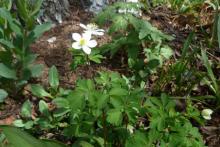


*Name edited for correction!
Re: Miscellaneous Woodlanders
Has anyone got any rain for our woodland? Hardly any since February - the garden is parched!
I cant' send you any either, Tim. We have (had) very dry weather also, maybe I should start thinking about growing more Cacti and Onco's ;) ;)
Re: Miscellaneous Woodlanders
Has anyone got any rain for our woodland? Hardly any since February - the garden is parched!
If you have the pipeline I have the water! We had a very sunny and warm April but May has been rather wet. However the temperature has been higher than normal. More rain expected all the week.
Re: Miscellaneous Woodlanders
Regarding Oxalis as groundcover - I prefere oxalis to any other groundcover plant! Oxalis is easy to grow and easy to remove, does not compete with the other plants and charming! And you can eat it!
I have grown Anemonella for years but they refuse to expand - only a few flowers a year :(
Wow, absolutely beautiful scenes, Mark! The photo of A. sikokianum is especially ethereal! Can't wait to see the cyp in bloom, too.
Great Arisaema photo, Trond. Eliot and Barbara Coleman used ducks to control slugs and snails... I doubt you'd want to travel to your cabin with a cage of ducks in tow but it would be an interesting thought. ;) (They are American organic gardeners who have published some very sensible books and had an organic gardening show on PBS TV. Anyway, they had an enclosure for their pair of ducks that consisted of a shelter at one end and a hardware cloth "run", and the assembly could be lifted and moved on a daily basis to give them new grazing grounds. They called it "Duckingham Palace"... )
I have read about people in Norway using ducks (Peking duck?) to control those molluscs but I have no wish to try! As you imagine: ducks in a cage! When the kids were small they had rabbits (they wanted a dog). We brought them with us every time we travelled except abroad. I am very glad that time came to an end!
Re: Miscellaneous Woodlanders
I so enjoy seeing all these treasures!
Regarding slug control, one of our Chapter members uses chickens.
Lori, only your 'Rosea' is Thalictrum (Anemonella) thalictroides. The white form is another species. Leaves are completely different, and I think you will find that your white one's flowers always have five petals, while Thalictrum thalictroides blooms usually have more. The single flower or umbel of T. thalictroides is always subtended by a single whorl of leaves. Our common name for T. thalictroides is May flower, and they are native in the woods here. I do grow them in my garden, too. They are great fillers, flower much longer in the garden than in the wild, and I always have lots of volunteers to weed out. ;D
Re: Miscellaneous Woodlanders
Oh, yes, that jolted my feeble memory, Rick! Thank you! The white one is Isopyrum biternatum.... right? ;D
Thalictrum thalictroides... they are native in the woods here. I do grow them in my garden, too. They are great fillers, flower much longer in the garden than in the wild, and I always have lots of volunteers to weed out. ;D
Many people will be extremely envious to hear that! ;D
Re: Miscellaneous Woodlanders
Oh, yes, that jolted my feeble memory, Rick! Thank you! The white one is Isopyrum biternatum.... right? ;D
I do believe you are correct on that, but another name change:
Enemion (Isopyrum) biternatum
I have seen this one growing wild in southern Minnesota, building height (to 1+ ft) as it continues to add flowers to the stem. (Flowers are not necessarily terminal.) I have not seen it occur as a single stem, but usually find it as a clump 10-18 inches in diameter.
Re: Miscellaneous Woodlanders
At last! Clintonia andrewsiana has opened its flowers ;D I have planted this elegant plant in my woodland where it now reahes 80cm tall with 3 flowering stems.
Re: Miscellaneous Woodlanders
At last! Clintonia andrewsiana has opened its flowers ;D I have planted this elegant plant in my woodland where it now reahes 80cm tall with 3 flowering stems.
Fantastic Clintonia Trond, the best species for sure. I have always wanted to grow this one; your post reminds me to put this higher up on my list. How did you keep the slugs away ;)
Did you grow it from seed or purchased plants?
Re: Miscellaneous Woodlanders
A really spectacular plant, Trond!
Re: Miscellaneous Woodlanders
At last! Clintonia andrewsiana has opened its flowers ;D I have planted this elegant plant in my woodland where it now reahes 80cm tall with 3 flowering stems.
Very flashy for a woodland plant!
Re: Miscellaneous Woodlanders
Congratulations on the Clintonia, Trond. Never seen that species in Norway before!
Re: Miscellaneous Woodlanders
At last! Clintonia andrewsiana has opened its flowers ;D I have planted this elegant plant in my woodland where it now reahes 80cm tall with 3 flowering stems.
Fantastic Clintonia Trond, the best species for sure. I have always wanted to grow this one; your post reminds me to put this higher up on my list. How did you keep the slugs away ;)
Did you grow it from seed or purchased plants?
Thanks all ;D
Clintonia seems to be immune to slug attack! They are however hard to get hold of (here). I think I bought two small rhizomes from Paul Christian (rare plants) some years ago. When I find seeds offered I buy. They're late to germinate and seedlings grow slowly.
Re: Miscellaneous Woodlanders
Tiarella cordifolia; Viola canadensis; Arisaema triphyllum; Scopiola carniolica; Geranium macrorrhizum 'Spessart' covered by a flurry of chokecherry petals; Phlox stolonifera... and I spy the leaves of another couple of Cypripedium parviflorum seedlings in there!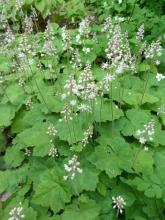
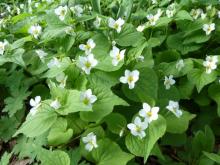
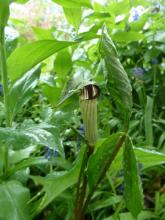
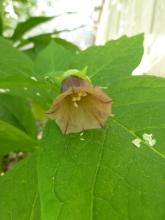
Re: Miscellaneous Woodlanders
Lori, I have some seedlings to plant out sometime soon-- Tiarella-- from Kristl, maybe cordifolia? look similar, but have slight red markings on the leaves (not going out now to check the tags.. the mosquitoes are fierce these days), and A. triphylla... do either of these need anything special in siting? Extra moisture, extra room to spread, part day sun or all shade? (of course I can and will google, but just to get some first hand Alberta input...lol)
Re: Miscellaneous Woodlanders
Cohan, neither gets any special care in my yard, no extra watering, zilch. (Well, nothing else gets special care either.) Full to part shade is fine. The tiarella will eventually spread enough to form a nice bed after a few years - certainly not invasively.
Re. the Arisaema.... well, mine have certainly never needed extra room... ;D. Rather more of a single specimen novelty (starting from 3-4 corms that I was kindly sent - one survived) even after a very, very long time... I've never had fertilized seeds on them. Apparently, the flowers are dioecious and I only ever get one flower on a plant, and I only have one plant of a couple of species! Has anyone else in this area grown them?
Perhaps you have one of the T. wherryi selections?
Re: Miscellaneous Woodlanders
Cohan, neither gets any special care in my yard, no extra watering, zilch. (Well, nothing else gets special care either.) Full to part shade is fine. The tiarella will eventually spread enough to form a nice bed after a few years - certainly not invasively.
Re. the Arisaema.... well, mine have certainly never needed extra room... ;D. Rather more of a single specimen novelty (starting from 3-4 corms that I was kindly sent - one survived) even after a very, very long time... I've never had fertilized seeds on them. Apparently, the flowers are dioecious and I only ever get one flower on a plant, and I only have one plant of a couple of species! Has anyone else in this area grown them?Perhaps you have one of the T. wherryi selections?
Tks, Lori...
I forgot to check that tag on Tiarella again... I think its a species, I had in mind its a wild form, but its (a pot of seedlings) from seed from Gardens North, and she does have both wild and garden seed .. I'll just have to remember to look at the tag..lol
My Arisaema are also seedlings from wild Ontario seed from a trade, not sure how many are in the pot, several at least, maybe fewer now than what germinated last year...
Re: Miscellaneous Woodlanders
I looked today, its Tiarella cordifolia and tag does not give a wild collected location, so it could be seed of garden forms, I'd have to ask Kristl if she remembers what she had that year.. here are the seedlings..
Re: Miscellaneous Woodlanders
Thanks, Lis! These plants are already a fave of mine with those gorgeous leaves-- hopefully some will show even more red over time.. flowers will just be a bonus :)
Some shade is good, since I don't have that much full sun space, anyway--but half day sun I have lots, and dappled to deeper shade... I'll probably separate them and try a few spots..
Re: Miscellaneous Woodlanders
Flowers on Linnaea borealis, which is growing in an acid bed and is draping nicely down the side: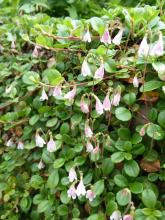
Re: Miscellaneous Woodlanders
The draping displays them nicely... some patches are in flower here, though most seem to be just in bud last I looked.. they rarely get space to themselves though, and have to be viewed through other vegetation.. There are many places where they grow in mowed areas--fine for the plants, but i'm not always successful avoiding the flowers....
Re: Miscellaneous Woodlanders
they [Linnaea borealis] rarely get space to themselves though, and have to be viewed through other vegetation.. There are many places where they grow in mowed areas--fine for the plants, but i'm not always successful avoiding the flowers....
In northern Minnesota where I see Twinflower commonly, I find them most often in pine needle duff where surface vegetation and understory are sparse. They virtually have the whole place to themselves! This is also where Pipsissewa (Chimaphila umbellata) grows.
Re: Miscellaneous Woodlanders
I've been very busy during the last couple of weeks so it seems I have a lot to catch up to on this forum.
Lori, love your shadeplants, especially the Arisaema and the twinflowers.
Cohan, your pot full of Tiarella seedlings look as if they are really enjoying themselves.
Here are some shade lovers which are flowering here now.
The white form of Anemonopsis macrophylla (sometimes sold as cv. 'White Swan')
Arisaema candidissimum
Arisaema fargesii
Arisaema speciosum
Arisaema tortuosa
Deinanthe caerulea
Epipactis gigantea
and Primula florindae
Re: Miscellaneous Woodlanders
they [Linnaea borealis] rarely get space to themselves though, and have to be viewed through other vegetation.. There are many places where they grow in mowed areas--fine for the plants, but i'm not always successful avoiding the flowers....
In northern Minnesota where I see Twinflower commonly, I find them most often in pine needle duff where surface vegetation and understory are sparse. They virtually have the whole place to themselves! This is also where Pipsissewa (Chimaphila umbellata) grows.
If I ever finish posting pics from my one day in the mts, lol, I will show some of the Linnaea here in the yard, and surrounding woods where they grow in any kind of soil and moisture conditions except standing water, nor are they common in the driest under spruce spots (the only places we have with barish ground).. they are common under and among grasses, shrubs, and numerous forbs with mosses, lichens and fungi as well
Re: Miscellaneous Woodlanders
A very nice Arisaema collection, Whim! (Arisaema speciosum gives me the giggles.) :D
A pic from a previous year, my Deinanthe caerulea has a yellow, twisty stigma.
Re: Miscellaneous Woodlanders
A very nice Arisaema collection, Whim! (Arisaema speciosum gives me the giggles.) :D
A pic from a previous year, my Deinanthe caerulea has a yellow, twisty stigma.
A. speciosum is really nice (and a new addition to my garden since this year).
The stigma's of my Deinanthe caerulea and of my Deinanthe bifida are white....
Re: Miscellaneous Woodlanders
I love the pin-striped Arisaema, Wim!
It's nice to see the beautifully-grown Deinanthe in both Rick's and Wim's gardens. (Mine has succumbed to drought and general mistreatment... sigh.)
I suppose this is a woodlander of sorts... I believe it's Symphytum grandiflorum (maybe a cultivar, but if so, I've lost its name), and it's looking very attractive with it's white, blue and red inflorescences. Despite it's common name, creeping comfrey, it has remained in the same spot over a few years now; should I be on the watch for world-domination?
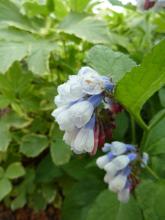
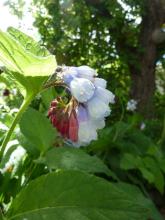
Re: Miscellaneous Woodlanders
Deinanthe caerulea is another one of my acquisitions that was woefully mistreated in its early years due to my ignorance of its needs. For three or four years it was an "ephemeral", emerging in the spring and in just 3-4 weeks going dormant. I guess it was wondrous that it even survived that hot, summer baked, rich clay. When I moved it to a proper site, it really jumped into growth. It produces zillions of viable seeds, although I have not seen any volunteers yet.
Re: Miscellaneous Woodlanders
I still grow comfrey also. I hold over from when I used to dry the leaves to brew a most delicious tea. It is still my favorite, tasting much like orange and black peko. But there are some reports of it being carcinogenic, So I hardly drink it anymore. I received the plant from my neighbor, who drinks it religiously, as did his father in Italy. so I don't know what its real taxonomic designation is, but I guessed it as Symphytum x uplandicum. Yours is much more garden worthy, Lori. I'm not sure if it ever produces viable seed. One year I tried in earnest to collect seed for someone; I think I got two seeds that looked good, but I never found out if they actually grew or not.
Re: Miscellaneous Woodlanders
I haven't grown comfrey, but I have got the impression that once you plant it, its for life... supposed to produce wonderful compost (really deep roots that bring nutrients from deep soils), some sort of fertiliser tea as well..
Re: Miscellaneous Woodlanders
I also grow Comfrey - my introduction to it in the 80s as a tea plant and vegetable coincided with the carcinogen scare, so I left it alone. I grow the selection Symphytum x uplandicum "Bocking 14", a selection made by the Henry Doubleday Research Association in the UK who championed this "wonder plant" until the scare. It is also used to make comfrey fertiliser as Cohan says (just fermented leaves, like nettle water) and that's how I use it today. It behaves very well in a garden, not spreading invasively like some of the species.
Re: Miscellaneous Woodlanders
I love the pin-striped Arisaema, Wim!
Lori,
A. fargesii is one of the easiest Arisaema's to grow...if I get seeds this year, I'll send you some.
It's nice to see the beautifully-grown Dienanthe in both Rick's and Wim's gardens. (Mine has succumbed to drought and general mistreatment... sigh.)
I find it very easy to grow as long as you don't let it get too dry (see pic)
Re: Miscellaneous Woodlanders
Much to look at here!
Deinanthe is a favorite of mine but my plants can't match yours! They're often damaged by slugs.
Comfrey is a weed in my garden, selfsowing all over the place. However it is easy to remove when young.
Twinflower is very common here except the driest places. I love their spicy fragrance.
Arisaemas are always special but the speciosum is not the least!
Re: Miscellaneous Woodlanders
Still going strong, flowering for the last month and a half, is Kirengoshoma palmata. Last year, the plants completely collapsed in the record-breaking drought and looked hideous, this small genus of Japanese woodlanders is the plant equivalent of a canary in a mine, one of the first plants to show water stress and flag with the slightest whiff of dryness. This year we've had ample rainfall, and these large plants (to 5' tall x 5' wide) drip at the tips with waxy yellow flared trumpets. The foliage is unique, bold, and attractive as well.
I'm always interested in what blooms attract hummingbirds; today I heard the close whir of a hummingbird's wings, as it visited each and every flower on my large Kirengoshoma stands, the first time I witnessed this particular hummingbird nectar choice. In the second photo, I marked a red arrow where the hummingbird is, and included an enlarged insert; sorry for the poor photo quality but the entry-level camera I share with my daughter is useless for action photography and macro photography, but you'll get the idea.
Re: Miscellaneous Woodlanders
Well grown, Mark!
My plants do not show any colour to the flowers yet. They are very late flowering here.
Have you considered if your plants belong to the Koreana group/Kirengeshoma koreana? If I remember rightly the Korean form opens the flowers more and has a stiffer stem. My plants are very lax. But this can be temperature related of course.
Re: Miscellaneous Woodlanders
"Have you considered if your plants belong to the Koreana group/Kirengeshoma koreana? If I remember rightly the Korean form opens the flowers more and has a stiffer stem. My plants are very lax. But this can be temperature related of course."
I agree too...the plants we have at work labeled K. palmata are much more cascading and a bit more closed than yours Mark. The K. koreana haven't started blooming yet, but I'll bet they are going to look just like yours.
Re: Miscellaneous Woodlanders
"Have you considered if your plants belong to the Koreana group/Kirengeshoma koreana? If I remember rightly the Korean form opens the flowers more and has a stiffer stem. My plants are very lax. But this can be temperature related of course."
I agree too...the plants we have at work labeled K. palmata are much more cascading and a bit more closed than yours Mark. The K. koreana haven't started blooming yet, but I'll bet they are going to look just like yours.
Very interesting Amy, you've given me something to look at more closely. And when I start looking up Kirengeshoma palmata and koreana, the puzzle deepens and I'm no closer to an answer! What I'd like to find is a definitive publication that delineates the difference between palmata and koreana, and on that front, I haven't yet found anything conclusive. First, there's the reference to the "koreana group" or K. palmata koreana group", suggesting ambiguity on the two "species". There's even uncertainty regarding the family and taxonomic standing, originally placed in Saxifragaceae but some authorities now placing it in Hydrangeaceae, and the genus is listed as "status unresolved" in The Plant List.
http://www.theplantlist.org/tpl/search?q=Kirengeshoma
I also have a plant that came to me as K. koreana, which has leaves that look decidedly different, although my plant languishes in a drier part of the garden... not sure if it's still alive. It has never flowered for me.
So, I very might very have Kirengeshoma (the koreana group), but who really knows.
Re: Miscellaneous Woodlanders
After a long search, I did find this one recent (2010) paper. While very technical, it does have some taxonomic language that is helpful, which makes clear that there are two species, and where each is native to.
http://www.amjbot.org/content/97/6/e48.full
Here's an excerpt:
Kirengeshoma (Hydrangeaceae) comprises two extant species, Kirengeshoma palmata Yatabe and Kirengeshoma koreana Nakai, both of which inhabit warm temperate-deciduous forests in eastern China/southern Japan (K. palmata) and South Korea (K. koreana) (Qiu et al., 2009). Kirengeshoma koreana is restricted to one locality, Mt. Baek-unsan, whereas K. palmata is known from four sites in eastern China (Zhang et al., 2006) and three in southern Japan (Chang et al., 2007). Because of their small range size and small number of populations, both species are treated as “endangered” in China, Japan, and Korea (Qiu et al., 2009) and are considered “critically endangered” by the International Union for the Conservation of Nature (IUCN). Both species are of high ornamental value because of their large attractive flowers and beautiful leaves. Kirengeshoma palmata is also a medicinal plant, containing biologically active flavonoids in roots and rhizomes (Zhang et al., 2006).
Re: Miscellaneous Woodlanders
Here's another taxonomic paper on Kirengeshoma. It is very technical and way over my head, but one can glean a few factual tidbits from the paper. http://onlinelibrary.wiley.com/doi/10.1111/j.1469-8137.2009.02876.x/pdf
1. Kirengeshoma species are from Japan, Korea, AND China, the latter is almost never mentioned.
2. There is a color map showing where the species are found.
3. From the text "While all populations were originally identified as Kirengeshoma palmata (Yatabe 1890) the Korean population was subsequently described as Kirengeshoma koreana (Nakai, 1935), even though this is not always accepted"
Still haven't found a document that lists the taxonomic differences between the two species! Most references to K. palmata describe a plant 1 meter tall (some say 120 cm, so a trifle taller). My plant gets 5-6; tall (almost 2 meters), so perhaps my plants are K. koreana after all, although without a botanical description of K. koreana, it is still hard to know for sure. Also, as Amy suggests, the more flared flowers suggest K. koreana too, as most photos I've seen of K. palmata have more drooping bell-shaped flowers that don't open as much, but that isn't consistent across the photos I've found... maybe the two species are mixed up in cultivation.
Here's a drawing of K. palmata from the Flora of China. Interesting to see the base of the stems are square in cross-section, I have not noticed this before. Also interesting, Flora of China still places the genus in Saxifragaceae.
http://www.efloras.org/object_page.aspx?object_id=12438&flora_id=2
This link describes the Japanese derivation of the name Kirengeshoma:
http://www.rhs.org.uk/Gardens/Rosemoor/About-Rosemoor/Plant-of-the-month...
Re: Miscellaneous Woodlanders
Maybe I have flogged this horse long enough ;), but I wanted to share a recent development.
While perusing a garden center, and checking out the "shade perennials" area, some of the tables were pretty well picked over, but there it was, sitting by itself, a lone Kirengeshoma koreana. So, I had to buy it, and then compare with my garden plants identified as K. palmata.
Placing the plant right up to my 6' tall plants I have under the name of K. palmata (still in nice bloom by the way), the two plants couldn't be more different. The newly purchased K. koreana has thickish, waxy, heavily rugose leaves, whereas my garden plants of K. palmata have smooth matte grayish-green leaves 4-5x the size, looking completely different. In the closeups of "koreana" you'll notice how the upper stem cauline leaves are "alternate" whereas the "palmata" leaves are strictly "opposite". When the buds open on "koreana" I'll take side-by-side photos of both in bloom to compare. I'm still hoping to find an actual botanical description of K. koreana, with which to compare to palmata.
Kirengeshoma "palmata" still in good and ample flowering, the end of August 2011. It helps that we've had ample rain this summer, and the impressive 5' wide x 6' tall clumps have been blooming throughout July and August.
Re: Miscellaneous Woodlanders
Interesting observations, Mark!
I suppose you intend to plant the new plant out some place and compare the specimens next year when the new one has had a better life than restricted in a pot.
Daniel J Hinkley mentions in his book "The explorer's garden. rare and unusual perennials" that "The large, sharply lobed, maplelike leaves (of K.palmata) are borne in opposite pairs . . . . .. Atop stems that rise to 6ft (1.8m) on content individuals, cymes of elegant pendulous, pastel-yellow flowers are produced on lax pedicels in late summer . . . . . .The nodding floral branches are what distinguish this species from K. coreana, the flowers of which are borne on a stiffly upright inflorescence. With a stem reaching nearly 7ft (2.1m) high on robust specimens, K. coreana can be somewhat larger than the Japanese counterpart".
He also mentions that the University of British Columbia Botanical Garden has successfully crossed the two species. Possibly others have done too.
Re: Miscellaneous Woodlanders
Fascinating! Thanks Trond! I think there is so much parroted (mis)information out there on the internet, it's hard to get to the root of these situations. And as well, plants in cultivation, when lacking well known and accessible botanical information, are often mixed up because there is little basis for comparison and any correction. But when I saw this potted plant of K. koreana, I was struck with the obvious differences between it and palmata. The Hinkley description is interesting, and now I'm more anxious than ever to see if the buds on K. koreana remain upright.
It is curious that in the Flora of China entry for K. palmata, reports flowering and fruiting months as: Fl. Apr-Mar, fr. May-Aug, which seems completely wrong, the early dates surely an error, as Kirengheshoma is a late summer blooming. Flora of Japan gives flowering time as August.
By the way, I do have The Explorer's Garden book, but didn't think to check it, thanks for the insight.
About K. palmata, I found one site that states: The flowers of most of the plants seen in gardens are a fairly deep yellow, though the colour of wild specimens ranges from white to apricot.
Re: Miscellaneous Woodlanders
We've had regular rain this summer, but even so, with the extra heavy total rainfall from last week's Hurricane Irene (Tropical Storm Irene) by the time it reached us, Kirengeshoma palmata is more floriferous than ever, certainly enjoying all that rain and repaying in kind with a burst of new flowers and more buds (left photo). And my recently purchased and planted K. koreana shows buds a trifle swollen, still waiting for them to open (photos 2 & 3 on the right):
Another moisture lover (although taking normal moderate dry soils well, but not drought) is Leucoceptrum stillipilum, the Japanese Shrub Mint. This is a small Asian genus, and at least with a couple species I know about, are superb autumn blooming plants that excel in shady woodland conditions. It's been perfectly hardy for a number of years, and unlike what might be implied by the common name, it behaves as a woody-stemmed herbaceous perennial, all growth dying down over winter and resprouting with fresh shoots in the spring. It is worth growing for the board, textured foliage, looking something like a Hydrangea. In mid October the buds expand into stamen-candles of lavender. Here are some photos of foliage and buds taken today, and a freshly expanding flower taken Oct. 15th, 2010.
There's a fine lime-green variegated form sold by Plant Delight's Nursery, and two leaf forms of L. japonicum in these links
http://www.plantdelights.com/Leucosceptrum-stellipilum-October-Moon-Pere...
http://www.plantdelights.com/Leucosceptrum/products/233/
Re: Miscellaneous Woodlanders
My Kirengeshoma has declined the last years and isn't much to beheld :(
I think I have to move it to another site.
Leucoceptrum stillipilum is a rare one! I don't think I've ever seen it for sale anywhere anytime :o Does it produce seed?
Re: Miscellaneous Woodlanders
Leucoceptrum stillipilum is a rare one! I don't think I've ever seen it for sale anywhere anytime :o Does it produce seed?
Nope, never seen seed; this plant flowers mid October through November, and by the end of flowering, the season shuts down and we're into freezing temperatures and often some snow, so seed on such late bloomers never has time to develop.
Re: Miscellaneous Woodlanders
The last blooms on Anemonopsis macrophylla just finished up. The form I have is not the best, and this season I only had 1 bloom stalk versus the 5-6 stalks I usually get, not sure why the deficit. The individual flowers deserve to be uplifted for close inspection, as they are extraordinarily beautiful.
Re: Miscellaneous Woodlanders
Yours are better than mine anyway. I haven't had any blooms at all this summer :(
Re: Miscellaneous Woodlanders
None on my single, poor, sad plant either.
Re: Miscellaneous Woodlanders
I've got 3 A. macrophylla from 2 different growers. the 2 from Ellen Hornig are much more compact than the one from Peter Joppe and they are planted pretty near each other. But they all bloomed and now I'm hoping for a good seed set. :D
Re: Miscellaneous Woodlanders
My A. macrophylla 'White Swan' has bloomed well this year and looks to have set a good crop of seed. I am already wondering what the off spring will look like. A poor picture but the only one I have
Re: Miscellaneous Woodlanders
What a gorgeous flower! I've never seen that one offered.....if you get enough seed to share keep me in mind please ;D
Re: Miscellaneous Woodlanders
Amy
as you are the first to ask I will certainly hope to be able to send you some.
At the moment I do not know what the capsules contain but previous experience shows that if no seed is set the capsules shrivel and this has not happened so far. Fingers crossed!
Re: Miscellaneous Woodlanders
My A. macrophylla 'White Swan' has bloomed well this year and looks to have set a good crop of seed. I am already wondering what the off spring will look like. A poor picture but the only one I have
Very very nice Tony. :-* ;D
The leaves of Wild Ginger (Asarum caudatum) tend to be a bit tatty after winter however its wonderful flowers at this time of the year more than make up for that . :)
I understand the leaves give off a sweet ginger fragrance if bruised--must try that out this weekend.....
Cheers Dave.
Re: Miscellaneous Woodlanders
Dave, just love the flowers on Asarum, they're so shy and whimsical. A. caudatum is one of my favorites here.
Re: Miscellaneous Woodlanders
Continuing on the Kirengeshoma front, buds on K. koreana finally opened, not sure if its flowering so late because its a young nursery-grown potted plant (now planted in the garden) or whether it is naturally so late flowering, waiting until September. With all the rain that we've had this season, K. palmata is flowering more than ever, a full 2 months of flowering! I'm convinced the buds that form at leaf internodes are indeterminate; that is, a seemingly unlimited number of buds can continue forming as long as conditions allow and promote such floriferous behavior.
Here is a recent shot of K. palmata on the left, show more outfacing flared bells; in the background is the foliage of Saruma henryi. The middle and right-hand photo are of K. koreana; the flowers more distinctly nodding, remaining more closed and incurved, lovely when lifted up (as I've done in the photos) to see the overlapping petal twist... the flowers on both are thick and waxy.
Re: Miscellaneous Woodlanders
Great photos, everyone.
Mark and others who have contributed, I am really glad you're keeping up on the K. palmata vs. K. koreana subject. It is very helpful.
Re: Miscellaneous Woodlanders
Thanks Rick.
Unless there's another surprise flush of flowers, Kirengeshoma palmata has put on its final hurrah, just a couple waxy flared flowers left for the season.
Re: Miscellaneous Woodlanders
Saxifraga 'Sugar Plum Fairy' is flowering here now. The correct cultivar name is: 'Cherry Pie'
Re: Miscellaneous Woodlanders
Wim, is that a Saxifraga fortunei hybrid or selection? Beautiful deep color, and most valuable for the late flowering. What can you tell us about 'Sugar Plum Fairy'?
A local NARGS member, Jim Jones, has been selecting pink form of S. fortunei and they are delightful, although mostly his are a softer pink. I moved mine this year as it was swamped by more aggressive neighboring plants, but in its new hasn't done much... will have to go out and look to see if any buds are showing; here it flowers VERY late; usually October. The color on mine however is very pale, looking white in photos, but it is actually a blush pink. Here are two photos from October 2008.
Re: Miscellaneous Woodlanders
Wim, is that a Saxifraga fortunei hybrid or selection? Beautiful deep color, and most valuable for the late flowering. What can you tell us about 'Sugar Plum Fairy'?
Mark,
It's a Japanese S. fortunei cultivar (not a hybrid). The original Japanese name is Saxifraga fortunei 'Toujya' (literally: Plum Happiness), but most of these Japanese cultivars have been given English names when they were exported to the UK or the States. These Saxifrages are very good for bringing color in the shade garden when almost nothing else is flowering... I fell in love with them last year while looking at this site: https://www.alpine-peters.de/shop/saxifraga/cortusifolia.html.
P.S. While looking at Jürgen Peters site again I see he sells 'Sugar Plum Fairy' too but it looks completely different to mine :rolleyes: :rolleyes: I'll have to look into that!
Re: Miscellaneous Woodlanders
OMG Wim, you would have to go show me that site! I want them all!!! Such a diversity of color and flower forms; I'm intrigued by the bilateral form of many of the cultivars, and of typically the species itself. I see what you're saying, the Sugar Plum Fairy on that site is very pale pink... whatever yours is, I love the deep color.
I snapped a photo of my plant before leaving on my a business trip, the stems and buds have appeared, although the whole plant has "downsized" since I moved it; didn't seem to like being moved.
Re: Miscellaneous Woodlanders
OMG Wim, you would have to go show me that site! I want them all!!! Such a diversity of color and flower forms; I'm intrigued by the bilateral form of many of the cultivars, and of typically the species itself.
;D ;D
I see what you're saying, the Sugar Plum Fairy on that site is very pale pink... whatever yours is, I love the deep color.
Just checked 'Sugar Plum Fairy' in the Saxifrage book of Malcolm McGregor and there it's described as having pale pink flowers and toothed petals, so mine certainly isn't 'Suger Plum Fairy'
I snapped a photo of my plant before leaving on my a business trip, the stems and buds have appeared, although the whole plant has "downsized" since I moved it; didn't seem to like being moved.
I love your form of S. fortunei, looks very airy, almost like lace!
Re: Miscellaneous Woodlanders
Confirmation that i grow other genera besides Trilliums ;D ;D
Scoliopus bigelovii
While I have a couple of established clumps in the garden these are now ,ever since i extended some plots ,in awkward positions for photographing so rather than move them i plan to plant a number of pots of unflowered seedlings in troughs to be able to enjoy the plants in more detail.
Cheers Dave.
Re: Miscellaneous Woodlanders
Confirmation that i grow other genera besides Trilliums ;D ;D
Scoliopus bigelovii
While I have a couple of established clumps in the garden these are now ,ever since i extended some plots ,in awkward positions for photographing so rather than move them i plan to plant a number of pots of unflowered seedlings in troughs to be able to enjoy the plants in more detail.
Cheers Dave.
Love that little plant, Dave. Don't love the smell though :-X Do you grow Scoliopus hallii too?
Re: Miscellaneous Woodlanders
Checked the name of my Saxifraga fortunei cultivar: it seems to be 'Cherry Pie' instead of 'Sugar Plum Fairy'.
According to Malcolm McGregor's book 'Cherry Pie' is described as: Deep pink flowers, foliage deep green with dark marks at the base of the leaf lobes (like ‘Blackberry and Apple Pie') whilst 'Sugar Plum Fairy' is decribed as: Pale Cream-pink petals toothed rather like ‘Cheap Confections’ but lower petals clearly longer than upper. Leaves large and pale green. Original Japanese name is ‘Toujya’.
Re: Miscellaneous Woodlanders
Those Scoliopus are so cool! 8)
Re: Miscellaneous Woodlanders
Love that little plant, Dave. Don't love the smell though :-X Do you grow Scoliopus hallii too?
[/quote]
I've never noticed the smell Wim.
I'm after S.hallii --Seen it listed a few occasions on the various seedexs however never been allocated it.
Cheers Dave.
Re: Miscellaneous Woodlanders
Love that little plant, Dave. Don't love the smell though :-X Do you grow Scoliopus hallii too?
I've never noticed the smell Wim.
I'm after S.hallii --Seen it listed a few occasions on the various seedexs however never been allocated it.
Cheers Dave.
Hi Dave,
I might have some seeds of Scoliopus hallii next year. If I get seed, I'll remember to send some to you.
Re: Miscellaneous Woodlanders
Hello Wim
That's very kind of you --maybe we could arrange a swop for a some Trillium seed.
I've noted my diary and will PM closer to the time .
Cheers Dave.
Re: Miscellaneous Woodlanders
Following up on my previous post on Japanese Shrub Mint or Leucosceptrum stellipilum (page 11 of this thread, or use this link: http://nargs.org/smf/index.php?topic=593.msg11128#msg11128), after being gone on a business trip for a week, it is now in flower. Had to take photos in the rain today, makes the leaves look shiny but they are actually have a textured matte consistency. It's looking good this year due to all the rain, much to its liking... not a plant for drought conditions. I like having plants that begin blooming in October, and will grow and flower in the shade! Several selected views, the first one 1 week ago before my trip, with the buds elongating; the remainder from this rainy day a week later on October 1, 2011:
Re: Miscellaneous Woodlanders
I am a little jealous of this one, Mark, as I've said before. Never seen it except here.
Today i have planted some Trilliums in a new bed - or an old one which I cleared of overgrown shrubs. I have to look for Scoliopus too!
Re: Miscellaneous Woodlanders
Hello Wim
That's very kind of you --maybe we could arrange a swop for a some Trillium seed.
I've noted my diary and will PM closer to the time .
Cheers Dave.
That would be very nice, Dave. Thanks
Re: Miscellaneous Woodlanders
Recent view of Japanese Shrub Mint or Leucosceptrum stellipilum, at its peak on these very warm days of October 2011. In the background is Eupatorium rugosum 'Chocolate'.
Eupatorium rugosum 'Chocolate' is one of the finest native species and selections for shady autumn garden. All season long the foliage is a very dark chocolate color, somewhat lightening up by fall, then a long season of fresh white flowers. Grows about 3' tall.
http://www.northcreeknurseries.com/index.cfm/fuseaction/plants.plantDeta...
Of the many Asters in bloom now (Symphyotrichum and other astery-micro-split genera), the most common is Aster cordifolius, the Blue Wood Aster. While having a somewhat uniform and familiar appearance from afar, it is incredibly variable when observed at close hand. It can be weedy, in fact, the edges of woodlands and stone walls that line rural streets here in New England, can become a haze of smokey lavender blue from this species' profusion. In the past I allowed too many seedlings in my garden, so it has to be kept in check, which is easy enough... just allow some to grow in spots here and there for 6 weeks or more of cheerful display.
Re: Miscellaneous Woodlanders
Mark - I learn so much from this Forum! Leucosceptrum is completely new to me, even though I have a Japanese friend who often gives me native floras. I have just looked to see if it is in the Plantfinder and Crug Farm in North Wales list wild collected forms. They grow many amazing plants but do get a little more rain than we do in Kent!
Re: Miscellaneous Woodlanders
I have to pay Crûg Farm Nursery a visit once, they have a lot of interesting plants -and don't dispatch to Norway! A pity.
I have been wanting that Leucosceptrum ever since Mark showed it the first time.
I once had Aster cordifolius too; now I wonder what has happened to it, haven't seen it this fall.
Euptorium certainly is more than the one I know of!
Re: Miscellaneous Woodlanders
I have to pay Crûg Farm Nursery a visit once, they have a lot of interesting plants -and don't dispatch to Norway! A pity.
I have been wanting that Leucosceptrum ever since Mark showed it the first time.
I'll have to pay attention to the spikes of Leucosceptrum, to see if there are late maturing seeds within those scale-like bracts. If we have a long mild autumn/early winter, and a reasonable amount of dryness, there's a possibility for sufficient time for seed to form. For 2 of the last 3 years I got seed on Kirengeshoma palmata, even a few self sown seedlings... the first ever to appear.
Trond, did you notice on that Japanese nursery link you gave on the Allium 2011 topic, that they offer 2 named forms of Leucoceptrum japonicum! They do international shipping, although they don't give much in the way of details about that fact.
http://yuzawa-engei.net/11English/08Leontopodium/Leontopodium_page.html
Re: Miscellaneous Woodlanders
Trond, did you notice on that Japanese nursery link you gave on the Allium 2011 topic, that they offer 2 named forms of Leucoceptrum japonicum! They do international shipping, although they don't give much in the way of details about that fact.
http://yuzawa-engei.net/11English/08Leontopodium/Leontopodium_page.html
Yes Mark, I noticed and have done something too ;)
Re: Miscellaneous Woodlanders
Interesting, Aaron, neither did I know they were that rare. I am looking for koreana!
Re: Miscellaneous Woodlanders
Mark and others,
Kirengeshoma is a superb genus that I do not grow, or I should say, have not been successful in keeping alive. Would love to try it again now that I live in a gardening climate.
The two species, koreana and palmata, really are distinct both in morphology and genetically. From the authors a recent paper on the phylogeography of the genus; "it [koreana] differs, however, by a hexagonal green
(vs quadrangular purplish) stem, denser trichomes, paler and fewer flowers, and elongated stigmas." Qiu et al., New Phytologist (2009) 183: 480–495. Their phylogeny and haplotype data suggests both species should be recognized with P. koreana being the older species and the Chinese and Japanese palmata more recently diverged.Strangely I did not have a single paper on the genus saved to my extensive pdf library! Must be misplaced somewhere in all the files. Also, I did not realize that palmata is only known from 7 populations and koreana from a single mountain which contains a single population!
Aaron
I'd love to find information that clearly delineate these two species; I believe that is the source of the problem, there is precious little accessible information that makes the difference between these two species clear. In my informal google research, there is some belief that there is only one variable species. I have not heard nor realized that the native distribution of the two species is so perilously restricted, I hadn't had that impression when doing casual research. I had done lots of research previously, but in a more brief effort tonight, here are some links to technical papers that include information on native distribution of the 2 species. Some links are "for-purchase" papers, but one can read the "abstract" or summaries of the papers to get an idea of content. I know that I previously saw many other pages that showed plant species distribution, but here are a few:
http://www.springerimages.com/Images/LifeSciences/1-10.1007_s10265-006-0...
"Predicting the Distribution of Three Vulnerable Japanese, Plants: Rosa hirtula, Kirengeshoma palmata, and Salicornia europaea"
http://www.google.com/url?sa=t&rct=j&q=kiengeshoma%20distribution&source=web&cd=5&ved=0CD0QFjAE&url=https%3A%2F%2Fwww.nies.go.jp%2Fs4_impact%2Fpdf%2F20091118_Conlisk.pdf&ei=Uy4WT4yZMIeK2QXW5KCOAg&usg=AFQjCNEWdmqimvpsPPFzQyGWZT0YPuUDuA
"Molecular phylogeography of East Asian Kirengeshoma (Hydrangeaceae) in relation to Quaternary climate change and landbridge configurations"
http://onlinelibrary.wiley.com/doi/10.1111/j.1469-8137.2009.02876.x/pdf
"Genetic diversity of the endangered species Kirengeshoma palmata (Saxifragaceae) in China"
(a for-purchase document)
http://www.sciencedirect.com/science/article/pii/S0305197805001675
Re: Miscellaneous Woodlanders
One of the better short Polygonatums from China (and Russia) is Polygonatum acuminatifolium.
http://www.efloras.org/florataxon.aspx?flora_id=2&taxon_id=200027841
A friend of mine bought this as Blanchette Nursery nearby (Carlisle Massachusetts), I hear that he has an excellent selection of Polygonatum species and cultivars.
This one has the cutest boxy white green-tipped flowers and very neat short growth under a foot (< 30 cm). So far is has spread but moderately. I have earmarked a piece for you Aaron :)
Re: Miscellaneous Woodlanders
Mark, I fully agree! Although I grow several Polygonatums I don't have this one and it is one of the better I've seen!
Neat and rather large flowers. Wonderful ;)
Re: Miscellaneous Woodlanders
Mark, I fully agree! Although I grow several Polygonatums I don't have this one and it is one of the better I've seen!
Neat and rather large flowers. Wonderful ;)
I am in agreement too! Beautiful large flowers on a good sized plant! I'll be sowing seed of Polygonatum biflorum..should I soak these first or sow just sow & stratify?
Re: Miscellaneous Woodlanders
I'll be sowing seed of Polygonatum biflorum..should I soak these first or sow just sow & stratify?
Not sure about sowing Polygonatum seed, I have no experience growing them from seed, but I'm sure someone else here will be able to answer; I'm anxious to learn how to grow these from seed too.
Re: Miscellaneous Woodlanders
I'll be sowing seed of Polygonatum biflorum..should I soak these first or sow just sow & stratify?
Deno says:
P. biflourum seeds collected in October. Washed in water and cleaned with three rinses with water daily for 7 days, and placed outdoors germinated 90% in May-June. None germinated in 70F with light, 70F in dark or 40-70 (3 months at 40F then 3 months at 70F).
Re: Miscellaneous Woodlanders
I'll be sowing seed of Polygonatum biflorum..should I soak these first or sow just sow & stratify?
Deno says:
P. biflourum seeds collected in October. Washed in water and cleaned with three rinses with water daily for 7 days, and placed outdoors germinated 90% in May-June. None germinated in 70F with light, 70F in dark or 40-70 (3 months at 40F then 3 months at 70F).
Thanks Rick! ;D Outdoors they go! I love this forum...I always something new! :)
Re: Miscellaneous Woodlanders
Amy, have you remembered rinsing the seeds several times a day for a week ;)
Re: Miscellaneous Woodlanders
... cleaned seed stored cool for 30-40 days...
To clarify, when you say "stored cool", I take it you mean seed sowed in or on a moist medium (not dry storage)?
Re: Miscellaneous Woodlanders
With Polygonatum there have been a few germination studies to facilitate their production for vegetables in Asia. In all cases (P. cirrhifolium, P. macranthum, and P. odoratum) cleaned seed stored cool for 30-40 days, then warmth for 60-90 and then cool/cold again for the same duration gave a green leaf upon warmth again. This means a whole 2 seasons are gotten through in the first year. I have flowered verticillate species in 3 years this way.
Aaron: Do you have any references to cultivation of Polygonatum as vegetable in Asia. I have various references to their wild collection as vegetables, but can't recall seeing anything about their cultivation for food, although I haven't searched very hard...
Thanks
Re: Miscellaneous Woodlanders
Amy, have you remembered rinsing the seeds several times a day for a week ;)
Trond....these are from the NARGS exchange and so are already cleaned.
Yes, stored moist. Sow them and then give a cool period.
They are sown in 5" plastic deli containers in moist potting mix and in the fridge for the next few weeks. I will follow your directions and see what happens! And thanks.
Re: Miscellaneous Woodlanders
Hylomecon vernalis (syn H japonica) is one of my woodland favorites. Although the flowers don't last long they are very welcome. The plant tolerates deep shade and fits perfect in my woodland. Seems that the former 2-3 species are lumped into one.
Re: Miscellaneous Woodlanders
Nice one- I don't think I've heard of these..
Re: Miscellaneous Woodlanders
I grew a clump of it here for a few years, until it eventually disappeared (have unlabelled photos somewhere on my hard drive). I'm trying to start more from seed this year. It's probably worth a try for you... but then, I think pretty well everything is worth a try. ;D
Re: Miscellaneous Woodlanders
Hylomecon vernalis (syn H japonica) is one of my woodland favorites. Although the flowers don't last long they are very welcome. The plant tolerates deep shade and fits perfect in my woodland. Seems that the former 2-3 species are lumped into one.
I love this one too! It can spread around a bit by seed when it's happy and it's easy to divide. Yes a great plant for deeper shade and it's under huge pines so it like or tolerates dry soils. My kind of plant! ;)
Re: Miscellaneous Woodlanders
Looks very nice. The Hylomecon foliage doesn't look like it would be very durable though, is that true? How does it look by late summer? Or is it ephemeral?
Re: Miscellaneous Woodlanders
I grew a clump of it here for a few years, until it eventually disappeared (have unlabelled photos somewhere on my hard drive). I'm trying to start more from seed this year. It's probably worth a try for you... but then, I think pretty well everything is worth a try. ;D
Good to know! Did you get seed from one of the exes, or find it commercially?
Re: Miscellaneous Woodlanders
I bought it locally, though, unfortunately, I've never seen it again since.
Re: Miscellaneous Woodlanders
I guess it must be rather adaptable, considering the comments on this site, combined with comments earlier in this thread:
Hylomecon vernalis Maxim.
Hylomecon vernalis
Credit: Tatyana Shulkina
Plant with long rhizome, stems 20-30 cm during flowering. Basal leaves shortly petiolate, pinnate, stem leaves shortly petiolate, sessile, 10-15 cm x 10-15 cm. Flowering stem shorter than leaves. Flowers solitary, yellow, very large. V - early spring to early autumn, April-September in St. Petersburg. Fl - May-June for 2-3 weeks. Fr - early summer, June-July in St Petersburg. P - by seed and by division. Prefers a sunny place, does well in a semi-shaded position. Recommended for small group planting. Well suited to the rock garden. Cultivated in St. Petersburg Botanical Garden since 1870. Z 4 (3). New.
Far East (southern regions), northwesern China, northern Korea and Japan. In coniferous forests.
from:
http://www.efloras.org/florataxon.aspx?flora_id=120&taxon_id=220006651
Re: Miscellaneous Woodlanders
Looks very nice. The Hylomecon foliage doesn't look like it would be very durable though, is that true? How does it look by late summer? Or is it ephemeral?
Here it stays green almost all summer depending on how dry it is. It spreads very slowly outwards but that is not a problem!
I have never seen seeds or found seedlings here. Maybe I have only one clone (plants bought on sale in fall). However I bought some new ones last year, hope they are another clone ;)
Re: Miscellaneous Woodlanders
If I recall correctly, they stay green through the summer here as well.
Re: Miscellaneous Woodlanders
Hmmm, Hylomecon vernalis looks like a good one for my woodland gardens, will have to keep an eye out for this "forrest poppy".
Another aspect of plants that doesn't get much coverage photographically, is early spring plant emergence, except perhaps with a few genera known for their whimsical spring growth, such as Syneilesis, the Shredded Umbrella Plant.
http://nargs.org/smf/index.php?topic=252.0
Several years ago I bought a plant of the white-flowered form of Asarum caudatum, but it turned out to be the regular maroon color, but a nice ginger all the same. Its early emergence is awesome to watch; from a network of above-surface blackish rhizomes, the swelling leaf buds appear as silvery blobs of crumpled tissue. At the stage where either true leaves start to emerge, or the brooding flowers are revealed, the growth points remind me of fortune cookies. In the photo below, first row, on the right, ignore the little orangish-color seedlings, it's just those pesky Jeffersonia dubia seedlings that pop up all over the place ;)
Re: Miscellaneous Woodlanders
Mark,
I would suggest keying that in FNA. It looks like lemmonii or maybe even canadense. Caudatum should remain somewhat evergreen or tardily deciduous at least. Also the lobes of it should be far longer. I don't grow caudatum now, but I still have it in my parents yard.
Canadense can vary from short to mid-range, and long calyx-lobe forms. These "forms" all had names and may get them again. I have seen all three in one population with no intermediates, differences in pubescence, and plant size.
Aaron
Knoxville, TN
Aaron thanks for the suggestions, I will need to give it a closer look when in flower this spring, but after looking at the photos of lemmonii, canadense, and the FNA descriptions, I'm inclined to think it is A. canadense. I see that caudatum has those extra long tail-like calyx lobes; and they look much shorter in the picture I show, similar to canadense, wasn't sure if the appendages become longer in more fully developed flowers. It seems A. lemmonii looks a bit different.
I dug through more images, and I post some general garden scenes where the fully expanded foliage of the Asarum can be seen, and here again, I think you're right with the A. canadense suggestion.
General garden view on the left, the red arrow points to the foliage of the subject Asarum. Close-up of the foliage on the right.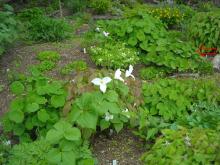
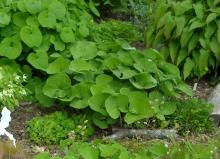
On the left, garden scene with Epimedium, Trilliums, Primula kisoana, Syneilesis, and other woodlanders.
On the right, close-up of Trillium grandiflorum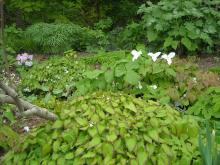
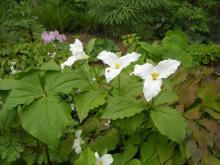
On the left, is Epimedium grandiflorum var. coelestre 'Alpine Beauty', Trillium grandiflorum 'Roseum" behind, foliage of Jeffersonia dubia in upper right, and foliage of the subject Asarum in the lower right.
On the right, Primula kisoana, an Asarum self-sown seedling plant in the center (with shiny foliage), and a small division of Deinanthe bifida in the upper right.
Re: Miscellaneous Woodlanders
Mark, that Deinanthe is super cool! :o
Those deep teeth are just remarkable. Hmm, reMARKable? I suppose you've heard that one before..
And where is the "bifida" in the leaves? Would that make it D. cearulea?
Re: Miscellaneous Woodlanders
Mark, that Deinanthe is super cool! :o
Those deep teeth are just remarkable. Hmm, reMARKable? I suppose you've heard that one before..
And where is the "bifida" in the leaves? Would that make it D. cearulea?
Now I'm more confused than ever, reminds me of the two species of Mukdenia exploration, or the two species of Kirengeshoma, which when researched, seems an overlapping muddle. I've grown my white-flowered D. bifida from seed (most likely NARGS), and it does indeed have white flowers, so never questioned the identity. I wish it were the more desirable blue-flowered D. caerulea. But looking at images of both, I see wildly variable leaves on both species, how many are misidentified, I don't know, and to what degree is the variability reported. Deinanthe caerulea is listed in FOC as having leaves with the apex entire or deeply 2-lobed with lobes 5-6 cm.
It should also be noted, that only some leaves, perhaps the most mature leaves in D. bifida, are in fact bifid, this can be seen in the Plant Delights Nursery photo that shows both types of leaves on D. bifida. The plant in my photo is a small division from my much larger plant, so might only be showing immature leaves.
http://www.plantdelights.com/Deinanthe-bifida-Perennial-Two-lobed-False-...
Re: Miscellaneous Woodlanders
Nice woodland garden views, Mark. I have only tiny seedlings of Trillium, so far, and no Asarum yet.. hope to have more of both eventually!
I pay a lot of attention to emerging foliage in spring/early summer-- especially the earliest things, when we have been without greenery for so many months! I took a lot of photos last year, especially, I'll try to post some here, at a later time..
Re: Miscellaneous Woodlanders
I have been thinking lately that I probably have too many Rhododendrons in my garden! They are all winter green and it isn't much growing underneath their dense foliage. Where there are open patches however a kind of grass soon infest the available space.
I am looking forward to having "those pesky Jeffersonia dubia seedlings that pop up all over the place", Mark!
Re: Miscellaneous Woodlanders
The foliage in your last picture looks like A. canadense to me. The others do not. A. canadense leaves are quite heart-shaped, with a definite point. Also, the points on the flowers you show seem to be a little long for A. canadense, and the rhizomes do not look characteristic. I can't put my finger on it, but I have the feeling that A. canadense rhizomes are a lot smaller and shorter. Could your plants be a cross?
Possibly, but not sure. I purchased the plant as Asarum caudatum 'Album', but it was mislabeled. It's a misnomer that needs an identity. Perhaps as you suggest, it is a hybrid? I'm not very experienced with Asarum, but welcome the suggestions.
Re: Miscellaneous Woodlanders
The primulas are coming now!
This one, a P denticulata lookalike (I think it is from one of Chadwell's allocations) has a lot of farina on the early buds. The flowers open early down between the leaves but the scape elongates soon.
Re: Miscellaneous Woodlanders
The primulas are coming now!
This one, a P denticulata lookalike (I think it is from one of Chadwell's allocations) has a lot of farina on the early buds. The flowers open early down between the leaves but the scape elongates soon.
Super cool Trond! Mine are still a few weeks away from bloom, but with temps going up into the 50'sf all week perhaps I'll see flowers much sooner! :D
Re: Miscellaneous Woodlanders
The primulas are coming now!
This one, a P denticulata lookalike (I think it is from one of Chadwell's allocations) has a lot of farina on the early buds. The flowers open early down between the leaves but the scape elongates soon.Super cool Trond! Mine are still a few weeks away from bloom, but with temps going up into the 50'sf all week perhaps I'll see flowers much sooner! :D
Thanks Amy ;)
Here the temp stays in the lower 40's F so everything develop rather slowly except the slugs. I've already sent quite a few to their eternal greenery.
Re: Miscellaneous Woodlanders
Epigaea repens (mayflower) is already budded, it'll be interesting to see if the flowers will open in March if we continue to get unseasonably warm weather, or hold off until April (which is still early for a mayflower). Photos taken today, March 17, 2012.
This is a colony growing on a wooded roadcut just a couple minute walk from my house. Observing the colony, there are obvious patches of variable forms, in the first photo you can see a lighter green leaved type on the left, and a darker green leaved form on the right. The photo on the right gives a view of the steep roadcut covered in mayflower.
On the left is a strong healthy looking form with large rounded dark green leaves. On the right is a particularly small leaved form, of a lighter green color, and with congested more leafy growth. The flowers are mostly very pale pink in this colony.
Are there any named selections of mayflower? I see photos of some strong pink color forms, but I don't know of any named selections. Has anyone grown this plant from cuttings, if so, any suggestions?
Re: Miscellaneous Woodlanders
Cool to see, Mark, this is one I'd like to establish- I have some unsown seeds.. :-[
Re: Miscellaneous Woodlanders
Epigaea repens (mayflower) is already budded, it'll be interesting to see if the flowers will open in March if we continue to get unseasonably warm weather, or hold off until April (which is still early for a mayflower). Photos taken today, March 17, 2012.
This is a colony growing on a wooded roadcut just a couple minute walk from my house. Observing the colony, there are obvious patches of variable forms, in the first photo you can see a lighter green leaved type on the left, and a darker green leaved form on the right. The photo on the right gives a view of the steep roadcut covered in mayflower.
On the left is a strong healthy looking form with large rounded dark green leaves. On the right is a particularly small leaved form, of a lighter green color, and with congested more leafy growth. The flowers are mostly very pale pink in this colony.
Are there any named selections of mayflower? I see photos of some strong pink color forms, but I don't know of any named selections. Has anyone grown this plant from cuttings, if so, any suggestions?
Very nice to see, Mark. And almost impossible to find over here. I've sown it three times now and killed them two times when transplanting. Now I have a third batch of three year old seedlings. I planted them out this spring without disturbing their roots... I just dug a hole in the shape of the seedbox and put it in like that....
Re: Miscellaneous Woodlanders
Mark, Dean Evans of the Berkshire chapter has successfully propagated this species from cuttings. One plant he gave me years ago still survives in my old Averill Park garden.
Re: Miscellaneous Woodlanders
I've wanted to grow mayflowerfrom the first time I saw a picture of it! As Wim says it is next to impossible to buy here and I have never had any luck with seed :(
Maybe I should try cuttings if anybody have some to spare . . . .
Re: Miscellaneous Woodlanders
It must depend on getting the cuttings at the right time.
Michael Dirr says in his propagation book that August into September (I assume in Georgia) is the best time to take cuttings of Trailing Arbutus. ("Mayflowers" denote Thalictrum thalictroides were I live.) Untreated in sand/peat mix gave 94% rooting in 5 weeks. Cuttings include part of last season's growth. October cutting rooted at 50%.
Re: Miscellaneous Woodlanders
I prefere cuttings to tiny seeds :-\ ;)
Re: Miscellaneous Woodlanders
That primula would make a great time lapse film! I've had thoughts of doing this on beds in the garden but so far haven't built up the resolve - it needs a bit of planning. Fern fronds expanding, Jeffersonia coming in and going out of flower (or Sanguinaria); in both cases it is only a few days. With Giant Fennels you can virtually watch the flower spike growing! I'm convincing myself that this would make a good project.
Re: Miscellaneous Woodlanders
That primula would make a great time lapse film! I've had thoughts of doing this on beds in the garden but so far haven't built up the resolve - it needs a bit of planning. Fern fronds expanding, Jeffersonia coming in and going out of flower (or Sanguinaria); in both cases it is only a few days. With Giant Fennels you can virtually watch the flower spike growing! I'm convincing myself that this would make a good project.
I have always wanted to do a time lapse photography of Arisaema heterophyllum (the form I grow is a giant, reaches 6' (2 m) to the spathe tip), typically it doesn't emerge until late May or early June, then in the span of 3 weeks it reaches 6 feet!
Thinking about time-lapse photography, in notheastern USA we've had a full week of record breaking mid-summer like warmth, each day to 79-80 F, people going around dressed in shorts and tee shirts. As if by magic, everything starting popping open; Magnolia soulangiana trees (widely planted here) are in full bloom, as are M. stellata and salicifolia, Forsythia, Cornus mas, Rhododendron mucronulatum, daffodils, and everything else pushing rapid growth. Suddenly Jeffersonia dubia is in bloom, the plants looking foreshortened and not flowering normally. Predicted to go down to 19 F (-7 C) tomorrow night, below freezing the following night(s) too; I anticipate the level of freeze damage that will occur with so much soft and advanced spring plant growth.
Mayflower or Trainling Arbutus, Epigaea repens is in bloom, now in New England we must call these Marchflower ;) Here are a couple photos taken near dusk on my way home from work a couple days ago. It's a near white form, I did take a photo of a single deeper pink form, but it came out blurry.
Re: Miscellaneous Woodlanders
Mark, white or pink, March or Mayflower; it is a gem!
Thinking about time-lapse photography, in notheastern USA we've had a full week of record breaking mid-summer like warmth, each day to 79-80 F, people going around dressed in shorts and tee shirts. As if by magic, everything starting popping open; Magnolia soulangiana trees (widely planted here) are in full bloom, as are M. stellata and salicifolia, Forsythia, Cornus mas, Rhododendron mucronulatum, daffodils, and everything else pushing rapid growth. Suddenly Jeffersonia dubia is in bloom, the plants looking foreshortened and not flowering normally. Predicted to go down to 19 F (-7 C) tomorrow night, below freezing the following night(s) too; I anticipate the level of freeze damage that will occur with so much soft and advanced spring plant growth.
Although we have had nice sunny weather we haven't reached that warm temperatures! Neither do we get freezing nights either :)
In the eastern part of Norway they have had all time high temperatures in March and my sister in Oslo tells she'll have flowering daffodils in the garden before Easter for the first time ever!
Mark, are you sure it is an Arisaema and not a bamboo you grow?
Re: Miscellaneous Woodlanders
Some plants which are flowering here now in the shade-garden.
Hepatica transsilvanica 'Eisvögel'
Hepatica nobilis (white)
Hepatica nobilis (blue)
Adonis ramosa
Thalictrum thalictroides 'Amelia'
Thalictrum thalictroides 'Big' and Primula 'Cowichan Red'
Forgot a few :rolleyes: :rolleyes:
Hepatica x media 'Blue Jewel'
and Thalictrum thalictroides 'Pink Flash'
Re: Miscellaneous Woodlanders
Nice stuff, Wim!
I'm jealous of your different T thalictroides cultivars. Have tried to establish some here with little success :(
Re: Miscellaneous Woodlanders
Wim- many nice things in flower there, as always!
Re: Miscellaneous Woodlanders
Nice stuff, Wim!
I'm jealous of your different T thalictroides cultivars. Have tried to establish some here with little success :(
Thanks, Trond. Really weird that the T. thalictroides (Anemonella) doesn't grow at your place....maybe to cold in winter?? Would you like to try again?
Wim- many nice things in flower there, as always!
Thanks Cohan!
Re: Miscellaneous Woodlanders
Nice stuff, Wim!
I'm jealous of your different T thalictroides cultivars. Have tried to establish some here with little success :(Thanks, Trond. Really weird that the T. thalictroides (Anemonella) doesn't grow at your place....maybe to cold in winter?? Would you like to try again?
Oh yes!
I don't think it is the climate actually but slugs and snails. I kill several small gastropods every day - but they are out in the night and they seem to prefere soft garden plants to grass and weeds :( :( Although it is mild it isn't very warm so the plants develop slowly and are prone to attack every night for a long time till they get so big and tough that the slugs loose interest.
Re: Miscellaneous Woodlanders
Thanks, Trond. Really weird that the T. thalictroides (Anemonella) doesn't grow at your place....maybe to cold in winter??
It seems to be hardy here, so not surviving in zone 8 can't be due to any lack of hardiness! Maybe it drowned, Trond. ;D
Re: Miscellaneous Woodlanders
Thanks, Trond. Really weird that the T. thalictroides (Anemonella) doesn't grow at your place....maybe to cold in winter??
It seems to be hardy here, so not surviving in zone 8 can't be due to any lack of hardiness! Maybe it drowned, Trond. ;D
I don't know what's the worse - whether it drowned or was munched by slugs :-\
Re: Miscellaneous Woodlanders
The wild Thalictrum thalictroides here survive most of the summer in dry woodland soil as just tuberous roots and no foliage. In the garden with better conditions, they tend to stay green far longer and flower for at least an extra month.
Re: Miscellaneous Woodlanders
Rick, that is exactly how I would like it in my woodland! - together with wood anemones, trilliums etc :)
Re: Miscellaneous Woodlanders
Last season I tried to collect seed for you, Trond. I kept looking at them (the seeds), thinking they are almost ready but not quite, and the next time I went to collect, they would be gone. I had never tried harvesting this seed before, so that was a learning experience, and now I now to take them at the more green stage.
Re: Miscellaneous Woodlanders
Last season I tried to collect seed for you, Trond. I kept looking at them (the seeds), thinking they are almost ready but not quite, and the next time I went to collect, they would be gone. I had never tried harvesting this seed before, so that was a learning experience, and now I now to take them at the more green stage.
Rick, I remember that you tried and appreciate your efforts! Hope you get some nice walks in the woods ;)
Re: Miscellaneous Woodlanders
There are some very nice Anemonella! I like those Wim!
As a noob i want to send a little pictures to you.
I have send them in the Epimedium threat before, but as i can hear, here is the right place.
First i want to show an Aconitum hemsleyanum 'Red Wine' (ready for climbing up to the sky :-) )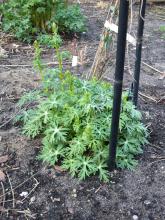
Next picture presents a Brunnera 'Jack Frost' which brings a little light into my shadow areas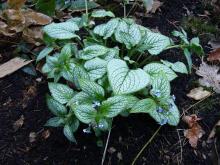
Maybe this plant takes attention to you profis- Caulophyllum thalictroides ( nice leaves ,pretty bloom and a nice built)
I enjoy having this plant!!!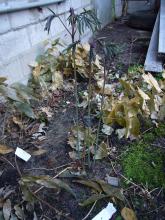
And for an end today , here comes Dicentra cucullaria in bloom 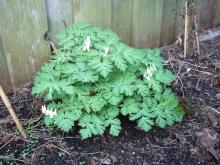
Have a nice eastern (even if you don´t want to have a greedy rabbit in your garden :-) )
Re: Miscellaneous Woodlanders
There are some very nice Antonella! I like those Whim!
As a no ob i want to send a little pictures to you.
I have send them in the Imodium threat before, but as i can hear, here is the right place.
First i want to show an Aconite 'Red Wine' (ready for climbing up to the sky :-) )
Next picture presents a Brynner 'Jack Frost' which brings a little light into my shadow areas
Maybe this plant takes attention to you prof is- Colorfully electrodes ( nice leaves ,pretty bloom and a nice built)
I enjoy having this plant!!!And for an end today , here comes Docents cu cullaria in bloom
Have a nice eastern (even if you don't want to have a greedy rabbit in your garden :-) )
Hello Ernie! Neither of my Red Wines reaches the sky! One gets munched by slugs and the other gets down my throat ;)
Nice selection of plants!
Have a nice Easter :)
Re: Miscellaneous Woodlanders
So here some more plants i like
This is a Cimicifuga ramosa 'Atropurpurea'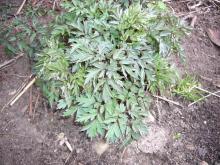
Polygonatum humilis 'Nanum'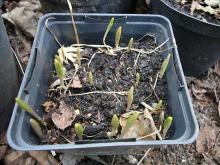
Polygonatum humilis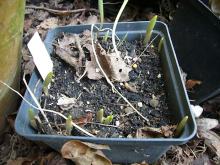
I hope you like some of it ...
Re: Miscellaneous Woodlanders
Isn't it nice how even little bits of growth can bring such joy...
Re: Miscellaneous Woodlanders
I mentioned elsewhere how it seems this season is giving deeper colors, despite the warm weather. I have never seen the Cardamine laciniata with such deep lavender buds. These are in the wild, near my house:
Open woods are not common in Minnesota. Usually there is a lot of native underbrush. The cardamine seems to thrive in these areas that get too dry to support summer growth.
Re: Miscellaneous Woodlanders
Rick, I love that! ;)
Re: Miscellaneous Woodlanders
Dicentra cucullaria, in the wild not far from my house. I have "decided" this is another species that can sit "dormant" for multiple years without showing above ground. I know this area quite well, and this spring I am seeing at least four times as many plants as I have ever seen there before. Plants are larger than ever before, too, with flower scapes up to 6 inches(!)
Possible reasons:
--- the ridiculously warmer than normal winter
--- the exceptionally dry late summer through winter
--- perfectly timed rainfall last spring during the Dutchman's Breeches' growth cycle
It's weird that our dry spring has not seemed to affect the plants...
A pinkish form:
Re: Miscellaneous Woodlanders
I mentioned elsewhere how it seems this season is giving deeper colors, despite the warm weather. I have never seen the Cardamine laciniata with such deep lavender buds. These are in the wild, near my house:
Open woods are not common in Minnesota. Usually there is a lot of native underbrush. The cardamine seems to thrive in these areas that get too dry to support summer growth.
Cool plant! I'm interested in the woodland Cardamines I've seen on the lists, nothing like that here!
Of course the Dicentra is exquisite, high on my endless list ;D
Re: Miscellaneous Woodlanders
Catching up to these topics :)
Ernie, you obviously like Polygonatum; I'm tempted to grow more of them, I only grow 3-4 types, but it is a most interesting genus. I do have P. humile, although have not heard of a 'Nanum' form, is it really smaller than regular P. humile. Must add P. falcatum to my garden too, Plant Delight's Nursery has some wonderful selections.
Rick, the Cardamine laciniata is most pleasing, seems like there are a number of very worthwhile Cardamine/Dentaria species to try in the woodland garden. Have you tried growing this in your garden.
Following up on my imposter Asarum caudatum alba posting (plant was actually A. canadense), I had bought the plant a second time and planted it out a couple years ago, the label got lost, then couldn't remember where I had planted it. :rolleyes: Well, today I found it, here's two photos of Asarum caudatum forma alba; an overall shot of the handsome foliage, and lots of creamy-greenish blooms (instead of maroon). Don't you just love those sorts of garden surprises!
Re: Miscellaneous Woodlanders
The rediscovery of something thought lost or forgotten is definitely uplifting. It happens "often" in my potted menagerie. Most recently for me, Lilium rhodopaeum, that I had started from seed and couldn't find last fall when I had wanted to give it special care for the winter. I found it this spring as it started its second year of leaf growth. 8)
When I first found Cardamine laciniata, perhaps ten years ago, I did pot up a few, thinking perhaps I would plant it in the garden. But change my mind mostly because it flowers very sparsely. The pots were donated to the Chapter's plant sale. More recently, though, I am changing my mind, only because its life above ground seems to be so fleeting, that even its interesting greenery would be welcome at a time when there is plenty of room in the garden. However, it may decide, like Thalictrum thalictroides does, to extend its stay at the surface in garden conditions. I guess I will only know if I try it.
to give an idea of the paucity of bloom: in the largest carpet in the pic below (in the wild), there were 16 blooming spikes.
Re: Miscellaneous Woodlanders
That's something like the flowering density of Pyrola here- or maybe even more flowers than Pyrola has, depending how large the patch is..
might vary depending on conditions though.. I'd still like to try some of those Cardamines... seem interesting, and for places where maybe not so many other things grow..
Re: Miscellaneous Woodlanders
Cardamine is one of my favorite genera - and one that is not damaged by slugs ;)
Re: Miscellaneous Woodlanders
A couple of shade-loving plants in flower here now:
Adonis amurensis 'Flore Pleno'
Dicentra cucullaria 'Pink Punk'
Primula 'Cowichan Red'
Re: Miscellaneous Woodlanders
And I forgot some others:
Thalictrum thalictroides 'Amelia'
Thalictrum thalictroides 'Pink Flash'
Uvularia grandiflora 'Gold Leaf Form' (the leaves turn yellow after flowering)
Hepatica nobilis 'Perrine's Pink' (just for the leaves)
Re: Miscellaneous Woodlanders
You really have some gems, Wim!
Does the flower of the hepatica stand up against the leaves?
Re: Miscellaneous Woodlanders
The cresses are starting now, here are two:
Cardamine pentaphylla and waldsteinii, and a lone Primula of unknown parentage:
Re: Miscellaneous Woodlanders
Wim- that Primula really is red!
Trond- love the Cardamines and nice colour on that Primula;
Earlier I'd reported how happy I was with the two auriculas I planted last summer, one of which flowered in fall, and I could see bright green overwintered foliage as soon as the snow melted.. Well, my report of excellent hardiness here seems premature, since while one came through nicely, the other seems gone, unless it resprouts later... :(
Re: Miscellaneous Woodlanders
The wild Pyrola spp. in Minnesota are very floriferous compared to Cardamine laciniata. If each growing point of cardamine is thought of as a separate plant, pyrolas would be ten time more floriferous. I have never notice that pyrolas are rhizomatous, I don't think they are.
All great pics, Wim. That's really a deep color for D. cucullaria, I think.
I don't think the native Thalictrum thalictroides liked the snowless, warm winter this past season. The Schoaff's Double in my garden seems to be unaffected, but the native ones have taken a big step backwards. Still true to the trend this spring, though, the native ones' flower color seems to be deeper.
Schoaff's Double - 1 April, and 8 April
The gold foliage on that Bellwort must be striking, Wim. Our Minnesota native Uvularia grandiflora has twisted petals - something I always thought set it apart from similar species, but I guess it is not a defining trait after all.
Re: Miscellaneous Woodlanders
I notice much more flowering in the native woodland species here after a snowy winter- that snowmelt is key moisture here, since we often don't get a lot of rain after the snow stops until late May/June..
I'm pretty sure Pyrolas here (mainly asarifolia, though there are others, as well as Orthilia and Monese) are rhizomatous, or stoloniferous, or something (Okay, I checked Moss/Packer and they use the phrase for the genus 'creeping rootstocks) since they all tend to form patches, with, esp for Pyrola, a low rate of flowering.. in the mixed woods right behind my house, they colony or adjoining colonies extend over a large area-- many many square metres (I should attempt some sort of measurement, since these large patches fascinate me) though never exclusive of other plants which grow among, through, above the Pyrolas- a number of patches extending (maybe?)15-20 feet in all directions, with small breaks and other patches next to them.... Flower stalks are certaily not uncommon, and might cluster several near, but then there could be several feet or more to the next (I'll have to try to dig up some photos...).. I think colonies in sunnier spots might have a slightly higher rate of flowering, though I have not encountered such extensive groups in sunnier spots..
Re: Miscellaneous Woodlanders
That's interesting, Cohan. I got that idea from your first posting about pyrola "mats", but I have never seen them do that here. Thanks for the clarification. Perhaps I have just not been to the right places. Of the three Minnesota flora books I have, only one mentions the rhizomatous quality of pyrola (so I am wrong). In A Flora of Northeastern Minnesota, Lakela notes the trait for all six native Pyrola spp. there, and for Moneses uniflora. Indeed, ones that I have seen up there could be so, but nothing really suggested to me that the colonies, usually of 1 to 10 sparsely spaced plants, were connected. :-\ I have noted mats of Moneses uniflora, though.
Re: Miscellaneous Woodlanders
You really have some gems, Wim!
Does the flower of the hepatica stand up against the leaves?
Thanks, Hoy!
I wouldn't know, I just bought it (the leaves were really eye-catching ;D). I guess it doesn't really matter anyhow...it probably flowers before the new leaves start growing.
The flower is described as pink with a white starry middle :-\ I wonder
Wim- that Primula really is red!
Cohan,
it is indeed, a vibrant red and it keeps on flowering for months, it's a superb plant!
All great pics, Wim. That's really a deep color for D. cucullaria, I think.
Thanks Rick,
that D. cucullaria 'Pink Punk' is a selection made by Susan Band of Pitcairn nurseries (http://www.pitcairnalpines.co.uk/)
Re: Miscellaneous Woodlanders
Wim- for months, wow!
Rick, no doubt a matter of the growing conditions- if there are only a few plants, you wouldn't notice 'creeping rootstocks'.. of course not every colony is that extensive here, but I probably couldn't go more than a few metres anywhere on my property (except the sunniest mowed patchs) without seeing some... I still have to dig up some of those pics...lol
Re: Miscellaneous Woodlanders
Some Pyrola species make loose mats of plants by underground runners which can be very long! I know as I once tried to move one clump to my garden. Never more. . . And as Cohan says, it commoner in dark woodland than in open situations.
Othilia makes mats too - I have seen patches about 2 meter across. Moneses also make patches but much smaller.
Re: Miscellaneous Woodlanders
I wondered if I should have added Saruma henryi to the winners and losers thread. But I couldn't tell which it would be! With the unseasonable cold, foliage color was a bit off, with a bit of blackish hue noticeable on the undersides. Stem and leaf growth is a little stunted now, I think, but flowers are the largest I have seen on this nine year old plant. :o
Pulmonaria 'Apple Frost'
Re: Miscellaneous Woodlanders
Pulmonaria 'Apple Frost' is stunning! Where did you obtain this one, I've not heard of it. I was going to post photos of Saruma henryi taken today, but yours are really good, a really good woodland plant. I have some seedlings potted for an upcoming NARGS chapter meeting.
Re: Miscellaneous Woodlanders
Apple Frost didn't do a lot when I had it planted with the hungry roots of the neighbor's sugar maple. Now, this is only the second season for it in its new home. It really has taken off, given some more sun and relatively little root competition. It has doubled in size already! The original plant came from Heronswood when it was still the real thing (2002).
Re: Miscellaneous Woodlanders
I wondered if I should have added Saruma henryi to the winners and losers thread. But I couldn't tell which it would be! With the unseasonable cold, foliage color was a bit off, with a bit of blackish hue noticeable on the undersides. Stem and leaf growth is a little stunted now, I think, but flowers are the largest I have seen on this nine year old plant. :o
Pulmonaria 'Apple Frost'
I have had Saruma thrice but none lived as long as a whole summer - slugs >:(
I am a little reluctant planting Pulmonarias as they selfsow around but I would make an exception for 'Apple Frost' ;)
Re: Miscellaneous Woodlanders
For the first time, one of my own seedlings of Shortia is flowering! Woooohooow!!! ;D ;D
Last year they still looked like this:
I planted them out in fall last year!
Two weeks ago Shortia soldanelloides var. soldanelloides (= Shortia soldanelloides or Schizocodon soldanelloides) looked like this:
And today I had my first flower on Shortia soldanelloides var. magna (= Shortia magnus or Schizocodon magnus)
And next week I'll have my first flower on Shortia soldanelloides var. illicifolia (= Shortia illicifolia or Schizocodon illicifolia)
Re: Miscellaneous Woodlanders
No wonder you're excited, Wim!
Those look to be very special. Interestingly shaped leaves, shiny foliage, changing color, really cool flowers... what more could one want! :o
Re: Miscellaneous Woodlanders
No wonder you're excited, Wim!
Those look to be very special. Interestingly shaped leaves, shiny foliage, changing color, really cool flowers... what more could one want! :o
Yeah, I'm really excited...not only because it's a wonderful plant, but also because people told me it was an impossible genus to grow in Belgium!
I'm aiming for a full collection of this genus there are only 6 species and 17 subspecies...so it should be possible!!
Re: Miscellaneous Woodlanders
Wim - those are absolutely superb plants! Always good to be told something is impossible! David Sampson, a fine nurseryman in the south of Britain where such plants are difficult to grow, used to also grow these well from seed and kept them in raised beds in a shade tunnel. (He also grew really choice primulas). Will be great to see how you get on making the collection.
The pulmonaria is very nice - the best in our garden has been 'Diana Clare' from Bob Brown (Cotswald Garden Flowers).
Re: Miscellaneous Woodlanders
Congrats on those Shortias, Wim! I don't know too much about them, apart from seeing John W in Nova Scotia post some on SRGC.. why should they be unsuitable for your climate?
All the Pulmonarias seem nice, seem like something I should be watching for :)
Re: Miscellaneous Woodlanders
Congrats on those Shortias, Wim! I don't know too much about them, apart from seeing John W in Nova Scotia post some on SRGC.. why should they be unsuitable for your climate?
Thanks Cohan,
I was told my climate was too dry and too hot in summer, even the seedlings would not get past their first year.....but everyone who told me it was impossible had never tried it (because they had been told it was impossible too :rolleyes: :rolleyes:)
Re: Miscellaneous Woodlanders
Well done Wim, have you posted these on the SRGC Forum? I'm sure there would be some envious viewers in Scotland. ;D
Re: Miscellaneous Woodlanders
Well done Wim, have you posted these on the SRGC Forum? I'm sure there would be some envious viewers in Scotland. ;D
Thanks David, haven't posted them on the SRGC forum yet....I'll post them as soon as the attachments are working again!
Re: Miscellaneous Woodlanders
Very nice Wim!
Where did you get seed from? I have looked for seeds of Shortia for a long time! I had some seedlings a few years ago but they died in a dry spell in the summer.
Shortia uniflora from the botanical garden in Oslo in April, one grows in sun (to much maybe) and the other in shade:
Re: Miscellaneous Woodlanders
Very nice Wim!
Where did you get seed from? I have looked for seeds of Shortia for a long time! I had some seedlings a few years ago but they died in a dry spell in the summer.Shortia uniflora from the botanical garden in Oslo in April, one grows in sun (to much maybe) and the other in shade:
Thanks Trond,
I got the seeds from the botanical garden of Göteborg. If you become a member of their "Connoisseur's Club' (for free) http://gotbot.se/kulturvast_templates/Kultur_XForm.aspx?id=51524, you get their seed-catalogue each year!
Re: Miscellaneous Woodlanders
Very nice Wim!
Where did you get seed from? I have looked for seeds of Shortia for a long time! I had some seedlings a few years ago but they died in a dry spell in the summer.Shortia uniflora from the botanical garden in Oslo in April, one grows in sun (to much maybe) and the other in shade:
Thanks Trond,
I got the seeds from the botanical garden of Göteborg. If you become a member of their "Connoisseur's Club' (for free) http://gotbot.se/kulturvast_templates/Kultur_XForm.aspx?id=51524, you get their seed-catalogue each year!
Did someone say seed-catalogue? ;D
Re: Miscellaneous Woodlanders
Thanks Trond,
I got the seeds from the botanical garden of Göteborg. If you become a member of their "Connoisseur's Club' (for free) http://gotbot.se/kulturvast_templates/Kultur_XForm.aspx?id=51524, you get their seed-catalogue each year!
Did someone say seed-catalogue? ;D
;D ;D ;D ;D ;D
Re: Miscellaneous Woodlanders
Seed-hunter have entered the stage :-) Good luck with it!
Here are some impressions of my garden
Clematis recta 'Purpurea' with lovely foliage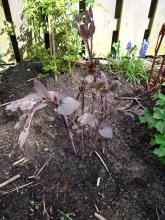
Gillenia stipulata in the third year after sowing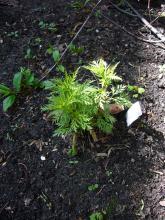
My favorite grass Hakonechloa macra 'Aureola'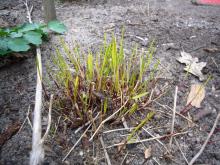
Phlomis tuberosa 'Amazone'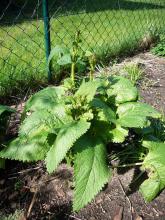
Polygonatum x 'Weihenstephan' ( a real nice and vital one)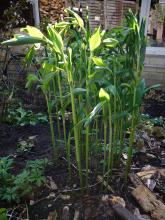
Some other Polygonatum pictures will follow maybe next week! Or should i create a new Polygonatum topic?
Re: Miscellaneous Woodlanders
Thanks Trond,
I got the seeds from the botanical garden of Göteborg. If you become a member of their "Connoisseur's Club' (for free) http://gotbot.se/kulturvast_templates/Kultur_XForm.aspx?id=51524, you get their seed-catalogue each year!
Did someone say seed-catalogue? ;D
;D ;D ;D ;D ;D
Don't laugh :(
I have looked in several catalogues but not found seeds of Shortia, at least not last year - I know some catalogues have from time to time but not every year :-\
Re: Miscellaneous Woodlanders
Thanks Trond,
I got the seeds from the botanical garden of Göteborg. If you become a member of their "Connoisseur's Club' (for free) http://gotbot.se/kulturvast_templates/Kultur_XForm.aspx?id=51524, you get their seed-catalogue each year!
Did someone say seed-catalogue? ;D
;D ;D ;D ;D ;D
Don't laugh :(
I have looked in several catalogues but not found seeds of Shortia, at least not last year - I know some catalogues have from time to time but not every year :-\
Trond, I'm not laughing with you....only with Cohan's comment....just say the word "seeds" and there he is! ;) ;) ;D
You really should try Göteborg....in the five years I receive their catalogue, there's only been one year in which they didn't sell any Shortia seed!
Re: Miscellaneous Woodlanders
Wim, thank you for the information. I have to join that Göteborgian club!
Re: Miscellaneous Woodlanders
Trond, I'm not laughing with you....only with Cohan's comment....just say the word "seeds" and there he is! ;) ;) ;D
Because my chances to buy interesting plants are very few!...lol Besides, going through catalogues- and trying to find out what the uncommon plants are, is a great pleasure :)
Re: Miscellaneous Woodlanders
Trond, I'm not laughing with you....only with Cohan's comment....just say the word "seeds" and there he is! ;) ;) ;D
Because my chances to buy interesting plants are very few!...lol Besides, going through catalogues- and trying to find out what the uncommon plants are, is a great pleasure :)
Just pulling your leg, Cohan ;)
Re: Miscellaneous Woodlanders
Trond, I'm not laughing with you....only with Cohan's comment....just say the word "seeds" and there he is! ;) ;) ;D
Because my chances to buy interesting plants are very few!...lol Besides, going through catalogues- and trying to find out what the uncommon plants are, is a great pleasure :)
Just pulling your leg, Cohan ;)
No, really, your characterisation was very accurate...lol.. have to remember to check that Goteberg site ;)
Re: Miscellaneous Woodlanders
It is Kirengeshoma season again! This year, the spring rainfall was plentiful, and this moisture-loving woodlander grew robust, the clumps taller than me so topping 6' (2 meters) in height, and once laden with waxy yellow bells and the stems declining somewhat under their weight, spreading to 8' across. This is a GIANT PLANT that needs room. And, after many many years, and never a self-sown seedling, in the last couple of exceptionally mild autumns and early winters, seed was plentiful and a handful of self-sown seedlings have appeared... I must get these moved to where they have room to mature.
A number of views of Kirensheshoma palmata in bloom, a show that'll go on for about 2 months, unless drought sets in. The flowers essentially take two day to open, at first the spiral unfolding buds are intriguing, and at full bloom, the open ulily-like shape of the waxy yellow blooms is appreciated so late in the season. The flowers appear in the upper leaf axils, up to 3 levels of bloom.
Part of an enormous Sugar Maple that fell recently and squashed parts of my garden, I worried more about having a tree-cutting crew in, with inevitable damage from human trampling being much worse than the fallen tree damage; part of the tree cut-up work has been done by an arborist that also happens to be a plant person who took care to stay on garden paths and not trample plants to any extent possible, the lone shoot of Kirengeshoma koreana stands proud, among considerable first-hand plant devestation from a 4' wide tree trunk falling on the area. I'm happy with the outcome.
http://nargs.org/smf/index.php?topic=807.msg18351#msg18351
Last, a view of Thalictrum rochebrunianum as a normal 5'-9" tall human might see it; sort of ridiculous, the plant must be 8-9' tall (3 m) this year. It would have to be planted in a low ravine, and observed from a up-slope path 1 meter higher to even begin to appreciate the flowers.
Re: Miscellaneous Woodlanders
Wow, those are some giants! I don't have anything like that here- the tallest thing is the native Heracleum, and its usually not much more than 90cm..
Re: Miscellaneous Woodlanders
Three views of Deinanthe bifida, blooming now in the woodland garden. Not sure why I grow this oddity, not that I mind an oddity, I like such things, but because I can't find a place moist enough for it. This plant is like the proverbial canary in the coal mine, sulking dramatically at the first whiff of dryness. After a month of relentless hot sunny days, finally with some rain relief this past week, the flopping collapsing mass of foliage stood up, the weird waxy white blooms with pinkish pedicel tips, opening from brownish drought-tinged buds. Is it worth growing this leafy thing, dumping what seems like hundreds of gallons of water on it (mild exaggeration) just to keep it alive during a month without rain, ultimately with modest, ephemeral, curious blooms decidely small in proportion to the leafiness; I'm not sure.
Re: Miscellaneous Woodlanders
It does seem pretty, and nice to have later woodlanders.. though whether its worthwhile in your recent dry summers is another question...
Re: Miscellaneous Woodlanders
.......... Is it worth growing this leafy thing, dumping what seems like hundreds of gallons of water on it (mild exaggeration) just to keep it alive during a month without rain, ultimately with modest, ephemeral, curious blooms decidely small in proportion to the leafiness; I'm not sure.
Depends Mark. If you are a man with infinite patience and time, press on. If not the compost heap beckons although it's a pretty little thing.
Re: Miscellaneous Woodlanders
Mark, glad the damage weren't unbearable! Nice to see the Kirengeshoma. My plants have started to dwindle - don't know why :-\
I like Deinanthe and have a couple I think, but they grow in dense shade and are seldom seen :-\ :-\
Re: Miscellaneous Woodlanders
Mark - I can't imagine a Kirengeshoma 8ft across until you showed your pictures. What a special plant! the best I have ever seen was next to a mill stream in a garden in Suffolk. I expect it is the sort of plant they grow superbly at Crug Farm in North Wales, along with giant polygonatums and arisaemas. Summer growing woodlanders in our garden rarely do well, although this year's cool wet summer has helped.
Re: Miscellaneous Woodlanders
You all might be wondering why I'm posting about a Coreopsis species in "Miscellaneous Woodlanders", but in fact, Coreopsis pulchra is a rather rare southeastern USA species, known as "woodland tickseed", from a very small distribution in Alabama and Georgia.
I got my plant from a NARGS Chapter plant auction earlier this year, donated by Darrell Probst, who originally got it from Jim Jones, our own great grower of esoterica. It has very fine foliage and late blooms that are good sized and bright golden yellow with a brown center. Haven't found just the right spot to plant it out yet, but I welcome growing a woodlander that will flower August through September.
Coreopsis pulchra (woodland tickseed)
http://plants.usda.gov/java/profile?symbol=Copu9
Re: Miscellaneous Woodlanders
Mark - I can't imagine a Kirengeshoma 8ft across until you showed your pictures. What a special plant! the best I have ever seen was next to a mill stream in a garden in Suffolk. I expect it is the sort of plant they grow superbly at Crug Farm in North Wales, along with giant polygonatums and arisaemas. Summer growing woodlanders in our garden rarely do well, although this year's cool wet summer has helped.
I wish I had a small stream or bubbling brook to grow Kirengeshoma along the banks, as it is most definitely a water hog. They were looking splendid this year with our moist latter part of spring, until the 6 weeks of drought and very hot daily temperatures, when they started collapsing in spite of my alternate-day watering efforts. Now that we seem to have adopted a monsoon weather pattern like that of Calcutta with thunderstorms dumping 1-3" of rain each day or night, they have perked up, but the drought mostly put an end to the flower buds and scorched the foliage so that it looks bedraggled.
With the heat and now over-abundant rains, some self-sown seedlings are grow lustily, must move them someplace where they have room to bulk up.
After last year's discovery of a single plant of K. koreana in a nursery among the left-over perennials late in summer, the plant overwintered fine, and amazingly, survived intact after the fall of a gargantuan sugar maple tree, and miraculously survived the foot pummeling of two different arborists cutting up and removing the massive branches and trunk. Here it sits quite unaffected, with most plants on either side of it and behind, no longer showing any trace of existance (although I'm hoping the roots of these beheaded plants will resprout next spring). Kirengeshoma koreana is most welcome for the fact it blooms so late, still just in bud.
Re: Miscellaneous Woodlanders
My Kirengeshomas have dwindled the last two years. Think I have to find some other place for them :-\
Mark, that Coreopsis looks good! It should bring light and colour to a dull green wood :) I have to look for that species!
I have gotten this one (see below) in my woodland. It has escaped from somewhere. It is a bit like Senecio cannabifolius (which I have plenty of) but the leaves are entire not digitate.
Re: Miscellaneous Woodlanders
Nice Coreopsis, Mark- yellow would be welcome this time of year- I only have the (I think) native Hieracium umbellatum- a not particularly showy plant, and mostly grows singly or in very small numbers, though in many places, I was thinking today it would be good to make a group of them to complement the numerous lilac/blue asters (ciliolatum, I think, is the most common one wild on my property, flowering virtually anywhere I miss mowing for a while).. the Coreopsis is much fancier though, as is Trond's Senecio! :o though 'escaped from somewhere' sounds a bit ominous...
We have Solidagos, but they are mostly done by the time the asters are going full strength, and don't seem to come into the forest edge as much...
Re: Miscellaneous Woodlanders
Trond, even a tall Senecio blooming yellow in the fall would be welcome in the shade garden, although I'm wondering about your plant, perhaps what you have is Senecio cannabifolius var. integrifolius with undivided leaves.
http://www.efloras.org/florataxon.aspx?flora_id=2&taxon_id=242348219
The type Senecio cannabifolius has very interesting divided leaves as the name suggests, here are some links to this plant. I had not known about this plant until you posted it :)
Senecio cannabifolius
http://hosho.ees.hokudai.ac.jp/~tsuyu/plants/senecio/can.html
foliage close-ups:
http://davesgarden.com/guides/pf/showimage/317610/
http://had0.big.ous.ac.jp/plantsdic/angiospermae/dicotyledoneae/sympetal...
Finally, Kirengeshoma koreana has opened some flowers, this species is very late, flowering after K. palmata has finished. Love the waxy spiralling golden eggs, the stem tips bending over under their weight.
Re: Miscellaneous Woodlanders
That is a nice one, Mark- and that is late to start flowering, thoujgh of course not nearly so late for your garden as it would be here..
Re: Miscellaneous Woodlanders
Hundreds of Cimicifuga simplex are in bloom, perfuming much of the yard and garden. My favorite are those that has dramatic dark pruplish foliage (particularly early in the season), black purple stems, and ruby-purple sepals on the small florets, striking as the flowers first open. Such plants are referred to as "atropurpurea group". Eventually the fluffy flower spires become all white.
Left: Cimicifuga simplex "atropurpurea" in bud early flower.
Right: Cimicifuga simplex "atropurpurea" in full flower.
These seed about rather too easily, the seedlings with foliage from all green (which I discard) to dark blackish-purple. Of hundreds of self-sown plants, all have pure white flowers (although the "atropurpurea" types with striking ruby sepals). Today I noticed one plant flowering that has decidely pink flowers, really lovely. Here are two views showing this light pink-flowered beauty.
Re: Miscellaneous Woodlanders
Trond, even a tall Senecio blooming yellow in the fall would be welcome in the shade garden, although I'm wondering about your plant, perhaps what you have is Senecio cannabifolius var. integrifolius with undivided leaves.
It could be that one, Mark.
It is no problem sending seed of both forms if you are interested although I think they'll be earlier in your climate than in mine. You better have to deadhead the plants too or you'll soon have more than you want - if they don't behave differently over there ;)
Hundreds of Cimicifuga simplex are in bloom, perfuming much of the yard and garden. My favorite are those that has dramatic dark pruplish foliage (particularly early in the season), black purple stems, and ruby-purple sepals on the small florets, striking as the flowers first open. Such plants are referred to as "atropurpurea group". Eventually the fluffy flower spires become all white.
I can't boast of hundreds but two plants and they are in flower now! I like the scent but some friends don't ;D
Re: Miscellaneous Woodlanders
It is no problem sending seed of both forms if you are interested although I think they'll be earlier in your climate than in mine. You better have to deadhead the plants too or you'll soon have more than you want - if they don't behave differently over there ;)
I can't boast of hundreds but two plants and they are in flower now! I like the scent but some friends don't ;D
I'm a bit wary of taking on any more "big woodland plants". I had added some woodland goldenrods (Solidago) and several Aster species, but they quickly started taking over, and I have ripped most of them out now. I'm finally getting self-sown seedlings on BIG plants like Kirengeshoma palmata, but will have to transplant these to places where then can grow large. I'm not writing the Senecio off entirely, I thank you for the kind offer, and I like the look of that Senecio, but I wonder.
On Cimicifuga simplex, they seed around with wild abandon. Each spring I allow the local garden club ladies come in and dig a few dozen big plants to sell at they annual spring plant sale. I relocate many seedlings to woodsy enbankments and rough woodland areas where I don't actually garden, and they survive and with reasonable moisture during the summer, are splendid in late summer/early autumn with great trusses of white flowers. I've been known to snip off the 7-8' stalks in late autumn when the dry seed follicles split to shed seed, and take these great seed wands and do a ritualistic thrashing dance in the woodland, to promote and assist their self-sowing.
Re: Miscellaneous Woodlanders
I've been known to snip off the 7-8' stalks in late autumn when the dry seed follicles split to shed seed, and take these great seed wands and do a ritualistic thrashing dance in the woodland, to promote and assist their self-sowing.
I can imagine that ;D Who is the drummer?
Re: Miscellaneous Woodlanders
We visited a wonderful small specialist nursery on Wednesday - Beeches Nursery near Saffron Waldon, just north of London. They grow an especially fine range of woodland plants - I picked up a nice Trillium simile with two noses, Scopolia carniolica 'Brevifolia', which I know by name but have never grown, and this blue form of Helionopsis orientalis from Korea. There were also some lusty plants of Ypsilandra tibetica. Nice trip on what has been one of the coldest days this spring, with blistering winds. Another plant in one of the tunnels was Eriogonum allenii 'Little Rascal'. Does anyone know this plant? Very good foliage.
Re: Miscellaneous Woodlanders
Looks like some nice choices, Tim! I've only seen Helionopsis and Ypsilandra on these fora, but like them a lot.. I have seed outside currently of Scopolia from Gardens North, don't think its 'Brevifolia' but I found it quite interesting looking..
Re: Miscellaneous Woodlanders
Ah! The blue Heloniopsis orientalis looks awesome! I have some forms of Heloniopsis and Ypsilandra but I am very afraid they are damaged in this cold dry weather we have.
I would love to visit that nursery!
Re: Miscellaneous Woodlanders
I have always had a liking for Heloniopsis and Ypsilandra, and grow and flower them both, but most of my friends can't see the attraction. They do seem to have an inherent scruffyness mostly because of slugs and snails for me. Do they grow better elsewhere? Must try and get the blue form of Heloniopsis.
Kirengeshoma grows well in the RHS garden at Rosemoor, at the top of the gulley to the Lady Anne garden. Not exactly head height but several feet wide from memory.
Re: Miscellaneous Woodlanders
I too would like to get hold of Ypsilandra and Heloniopsis, particularly the blue form of the latter, even with the "inherent scruffyness" of the foliage; I agree the foliage does have a certain unkempt look. Has anyone grown these little known treasures in New England?
Re: Miscellaneous Woodlanders
I too would like to get hold of Ypsilandra and Heloniopsis, particularly the blue form of the latter, even with the "inherent scruffyness" of the foliage; I agree the foliage does have a certain unkempt look. Has anyone grown these little known treasures in New England?
I did pick up a Ypsilandra last spring at the Bloedel Reserve Spring Plant Sale on Bainbridge Island, WA. It has been planted under a Hepticodium facing west in good composty soil. We'll see how tough that little bugger is in a few weeks! ???
Re: Miscellaneous Woodlanders
I did pick up a Ypsilandra last spring at the Bloedel Reserve Spring Plant Sale on Bainbridge Island, WA. It has been planted under a Hepticodium facing west in good composty soil. We'll see how tough that little bugger is in a few weeks! ???
Amy, keep us posted of its progress; if it'll grow for you, it should be doable for me. And I have a Heptacodium tree that need underplanting too :)
Re: Miscellaneous Woodlanders
I'll tell you how my plants have survived the arctic winter we have had - if we ever get a proper spring!
Re: Miscellaneous Woodlanders
I'll tell you how my plants have survived the arctic winter we have had - if we ever get a proper spring!
I know!!! We are expecting a dump of snow tomorrow!! 12-18" is forecast! :o When oh when will I get to see some snowdrops at least?!? :-[
Re: Miscellaneous Woodlanders
The snowdrops and snowflakes are showing but barely and many weeks late.
Galanthus 'Wendy's Gold' and Leucojum vernum
Re: Miscellaneous Woodlanders
Probably the best place for the Helionopsis and Ypsilandra would be in a good shady trough in peaty/sandy soil. In pots they are vulnerable to vine weevil grubs. I think planted under Heptacodium they could get too dry and wouldn't have that loose woodsy soil that things like trilliums and such do so well in.
Re: Miscellaneous Woodlanders
Probably the best place for the Helionopsis and Ypsilandra would be in a good shady trough in peaty/sandy soil. In pots they are vulnerable to vine weevil grubs. I think planted under Heptacodium they could get too dry and wouldn't have that loose woodsy soil that things like trilliums and such do so well in.
Duly noted! I'll put on my spring list of things to move 2 Ypsilandra from the Heptacodium to the streamside garden.
Thanks for the info Dr. Tim!
Re: Miscellaneous Woodlanders
Mark; Far Reaches Farm has Ypsilandra ($10), and Helionopsis (lavender-pink form; $18).
Re: Miscellaneous Woodlanders
Mark; Far Reaches Farm has Ypsilandra ($10), and Helionopsis (lavender-pink form; $18).
Thanks Don, what a super fine nursery listing at Far Reaches Farm, innumerable temptations. Ypsilandra and Heloniopsis are zone rated Z7 and Z6 respectively, both requiring moist soil. Since I'm Z5 and have a dryish garden, I may wait to hear about Amy's results before purchasing. Perhaps I should be like your namesake and tempt zone denial ;) and take a chance on them, but as I already have several plant orders expected this spring, I think I'll wait, at least for this year. Good tip, many excellent plant selections there, certainly one to bookmark under one's favorites.
Re: Miscellaneous Woodlanders
I have Ypsilandra ordered this spring for my 5b garden... or as I sometimes call it, "The Graveyard". ;D
Re: Miscellaneous Woodlanders
At last - the Lysichitons have appeared! It is spring!! The yellow americanus do self seed a lot but I am happy! Among the coming huge plants some bigleaved Chinese Chrysosplenium macrophyllum has flowered for weeks.
In the background you can see the winterburned native blueberry shrubs. No berries this summer!
Re: Miscellaneous Woodlanders
Looking good, Trond! These are both still on my list to try someday :)
Re: Miscellaneous Woodlanders
I'll keep it in mind and try to harvest seeds at the right time!
Re: Miscellaneous Woodlanders
Thanks!
Has your spring weather finally developed more normally? We had a warm March, cold April, and first part of May very warm, now we are closer to normal, maybe some rain coming after a long dry period... If the pattern holds, June will be cold...lol
Re: Miscellaneous Woodlanders
Well, I can't say things are normal yet. We went to spend our long holiday (it's Norway's national day today) at the mountain cabin and when we left home yesterday not a single birch tree had leafed out. It has never happened before in the 30 years I have lived here. Usually the birches are green 1th May. However, the forecast says 24C the next couple of days so I expect the trees are green when we are back home!
Here at our cabin it is still patches of snow which is normal though but it has rained much and lots of roads and homes are damaged due to flooding. Warm rain + a lot of snow in the higher places make a lot of water!
Re: Miscellaneous Woodlanders
Who knows the forms of Chrysogonum virginianum (there are 3), I assume by the shortness of this one, it is either var. australe or var. brevistolon. If "var australe", Flora of North America says the stolons are 12-60 cm long! Yikes, 60 cm, or 2', I might have to move this to a wild part of the garden. It's only two years in my garden, so far spreading mildly. But I wonder, and watch.
Re: Miscellaneous Woodlanders
It certainly looks charming but then I'm a sucker for daisy-like flowers (which I suppose will help explain why I planted some sort of Arnica 15 years ago... which I've been weeding out fitfully ever since. Damned thing never blooms but it sure gets around.)
Re: Miscellaneous Woodlanders
I like that Chrysogonum whatever sort it is! Wouldn't mind it spread in my woodland!
Re: Miscellaneous Woodlanders
Who knows the forms of Chrysogonum virginianum (there are 3),
What a coincidence as just yesterday I picked up 3 Chrysogonum virginianum ("Allen Bush"). I was looking for a shorter flowering shade plant and Chrysogonum virginianum seemed interesting from its description.
For those of you that have it, for how long does it flower in the spring? Does it ever repeat bloom...maybe late in the cooler wetter fall?
Re: Miscellaneous Woodlanders
Aaron, with three Chrysogonum virginicum subspecies, maybe there's a form that will be more amenable to your garden, or a strong selection like 'Allen Bush'.
Copperbeach, I had not heard of the 'Allen Bush' selection before, so looked it up. It's interesting that all sites report this plant flowers in spring but also reflowers in autumn. Here's what three different nurseries say about C. virginicum 'Allen Bush':
North Creek Nursery
http://www.northcreeknurseries.com/index.cfm/fuseaction/plants.plantDeta...
Chrysogonum 'Allen Bush' is typical of the species in most ways with a profusion of dark yellow, star-shaped flowers in spring and a few again in the fall.
New Moon Nursery
http://www.newmoonnursery.com/index.cfm/fuseaction/plants.plantDetail/pl...
‘Allen Bush’ is more compact and floriferous than the straight species. A good ground cover with yellow star-shaped flowers. Needs well-drained, moist soil in full to part shade.
Lazy S's Farm Nursery
http://www.lazyssfarm.com/Plants/Perennials/C_files/Ce-Ci.htm
East Coast Native from PA south. Nice ground cover in rich, well-drained soil but tolerates less than ideal conditions. The cultivar 'Allen Bush' typifies the species but with a profusion of dark yellow, star-shaped blooms in late spring/early summer and some later in the Fall. Takes sun in cooler zones, more shade in warmer zones. Light evergreen, triangular shaped leaves. Great groundcover.
By the way, I ordered Epimediums and a couple other plants from Lazy S'S Farm Nursery this year (along with orders for Epimedium from 3 other mail order nurseries); the plants from Lazy S were top notch, beautful large vigorous plants perfectly packed, highly recommended. Three out of four nurseries shipped excellent plants, Lazy S gets the highest grade. :)
Updated photo of my Chrysogonum virginicum, more flowers coming. I'm closely watching to see how far away new stolons appear, to gauge its spread, may have to move it out of its current location close to other plants. By the way, when I was 8 or 9 years old, this was one of the first plants I grew in a wildflower garden, I started early ;D
Re: Miscellaneous Woodlanders
Mark, I am a bit hesitant to ask - but does it set seed?
Re: Miscellaneous Woodlanders
Mark, I am a bit hesitant to ask - but does it set seed?
Honestly, I don't know if it sets seed, but I suppose it must, I haven't paid attention to that point in the two years I've had it back in my gardens after decades absence.
Re: Miscellaneous Woodlanders
OK, thanks. Being stoloniferous maybe it doesn't bother using energy on seed.
Re: Miscellaneous Woodlanders
A quietly attractive plant for a woodland setting is Tellima grandiflora (Fringecups) from Western North America. Mine came to me misidentified as Boykinia rotundifolia (that species is from California). The flowers start out green but age pink. To 18" tall.
Re: Miscellaneous Woodlanders
In the Pacific NW, you need to be careful with Tellima. If you let it go to seed, you will be sorry. And they are extremely difficult to kill with herbicide.
Re: Miscellaneous Woodlanders
In the Pacific NW, you need to be careful with Tellima. If you let it go to seed, you will be sorry. And they are extremely difficult to kill with herbicide.
The same in NW England it is a complete nuisance but nice
Re: Miscellaneous Woodlanders
In the Pacific NW, you need to be careful with Tellima. If you let it go to seed, you will be sorry. And they are extremely difficult to kill with herbicide.
Although it self seeds here in coastal Norway too it is not a problem (yet) and not difficult to remove like some other weeds.
Re: Miscellaneous Woodlanders
Hmmm, thanks for the head's up warnings everyone, had a similar warning on Facebook. Well, it was supposed to be a Boykinia. Hasn't shown any tendencies of spreading just yet (3 years here), but I'll watch it carefully, and if I spy lots of seedlings, will be sure to eradicate; it's a pleasant enough plant but I don't need yet another thug to invade my garden.
Re: Miscellaneous Woodlanders
I grew Tellima grandiflora from seed one year. They all died the second winter. ???
Nice pink fall foliage, but flowers weren't even as nice as yours, Mark.
I wasn't too heart broken by the loss.
Re: Miscellaneous Woodlanders
When I moved here I found a small clump of lavender coloured Anemone nemorosa, possible 'Robinsoniana'. Now it has spread with seed to a lot of new sites and I have several forms - it has possibly crossed with the wild windflower. They are much later than the common white ones.
Here is at least two clones (not easy to see in the picture though) and the colour is darker in real.
Another plant growing at the property was Polygonatum multiflorum. It has spread by runners to a huge patch in the woodland - making a nice understory among the rhododendrons. Unfortunately the Diphylleia sinesis doesn't spread!
Although these Maianthemums don't have the most colourful flowers they have handsome leaves and the berries are nice in the fall. Sorry, don't remember the names although I have planted them myself (you can spot my foot in the last picture).
Re: Miscellaneous Woodlanders
Very nice, Trond! I wish my Anemone nemorosa would flourish like that. I also wish Diphylleia liked the dry conditions here... oh well.
Very striking foliage on the Maianthemum.
A west-coaster that is hardy here, vanilla-leaf, Achlys triphylla... somewhat spreading, though: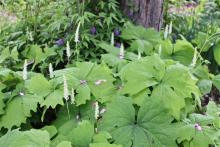
Anemone trifoliata and Viola canadensis: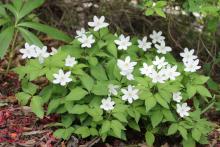
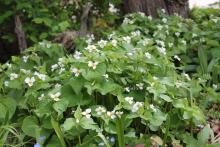
Omphalodes verna: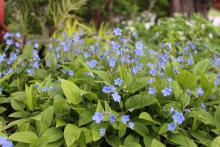
Re: Miscellaneous Woodlanders
Aaron, thanks for adding your notes on Tellima grandiflora, maybe it will be well behaved enough here in the East. Although I have taken into consideration warnings by others, and will remove the plant if it shows any worrisome spreading tendencies.
Lori, really like the appearance of Anemone trifoliata, can you tell me about it's rate of spread (I'm cautious with Anemone). I never think about Achlys triphylla, it is attractive, I should look to introduce that to some wilder parts of my woodland.
Trond, good to see Diphylleia sinensis, I grow the other two species cymosa and have two-year seedlings of D. grayi. My garden tends to be too dry for these plants, but I manage to keep D. cymosa going for a long number of years now, and I hope D. grayi too.
Here's the cutest little thing, dare I say, a Pinellia. This is Pinellia cordata 'Yamazakii', a tiny well-behaved form. It emerges so late (just a few days ago) I always think I've lost it; for me it stays as a small clump, with cute hooded blooms and skywards spadices. The best part, the flowers give off a strong aroma like sweet juicy-fruit bubblegum! I'm not kidding!
Re: Miscellaneous Woodlanders
Lori, really like the appearance of Anemone trifoliata, can you tell me about it's rate of spread (I'm cautious with Anemone). I never think about Achlys triphylla, it is attractive, I should look to introduce that to some wilder parts of my woodland.
I really like Anemone trifoliata too! It seems to be a slow spreader here... at least in the time I've had it. I think I planted it in 2009.
Trond, I think you have Anemone trifoliata too? How is the rate of spread for you?
Also, I can't remember if it goes dormant after blooming or not... must pay closer attention this year.
Pinellia cordata 'Yamazakii' is incredibly cute! I wonder how hardy it is?
Re: Miscellaneous Woodlanders
Pinellia cordata 'Yamazakii' is incredibly cute! I wonder how hardy it is?
This plant has been perfectly hardy here for the 5 years of so that I've had it (USDA Zone 5), but that's not enough information for your colder climate. It doesn't set seed (not that I've seen yet), so I'm not sure about its propagation options. Today I asked my daughter to smell the flowers; she thought it smelled very "fruity". Must work on getting this increased, too cute to lose.
Re: Miscellaneous Woodlanders
Lori, really like the appearance of Anemone trifoliata, can you tell me about it's rate of spread (I'm cautious with Anemone). I never think about Achlys triphylla, it is attractive, I should look to introduce that to some wilder parts of my woodland.
I really like Anemone trifoliata too! It seems to be a slow spreader here... at least in the time I've had it. I think I planted it in 2009.
Trond, I think you have Anemone trifoliata too? How is the rate of spread for you?
Also, I can't remember if it goes dormant after blooming or not... must pay closer attention this year.Pinellia cordata 'Yamazakii' is incredibly cute! I wonder how hardy it is?
Anemone trifoliata behaves itself very well in my garden. It is slow to increase making a rather dense rhizome. I have not seen seedlings either but I have only one clone. Anemone trifoliata does go dormant during the summer like the other similar wood anemones.
I have not tried Pinellia yet but certainly have to!
Re: Miscellaneous Woodlanders
Here's a view into the area under the 'Royalty' crabapple and also shaded by a large sweetberry honeysuckle (Lonicera caerulea) and by roses...
Geranium himalayense starting to bloom (sorry if this makes you shudder, Cohan ;D); a rapidly-spreading Arnica of some sort - at least this one blooms so I'm not complaining!; Anemone trifoliata in the distance: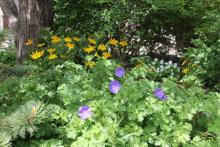
Re: Miscellaneous Woodlanders
An interesting plant I obtained as Streptopus obtusatus flowering for the first time. I think it is wrongly named and a friend has suggested it is Disporum cantoniense which seems a better identification.
Re: Miscellaneous Woodlanders
The speckling/mottling in the flowers is a nice touch.
Would the square shoulders help in identification?
Re: Miscellaneous Woodlanders
Boy, even this 'minor' thread ( a personal fave) I'm way behind on- I've been spending all my time digging- a bunch of new veg beds, and still lots planned for ornamental beds...
L:ove the Chrysogonum! I'll have to watch for seeds of that available somewhere..
I also really like the Anemone trifoliata. I have A. nemorosa from roots planted in fall 2011, only a couple of flowers last year, a bit more this year, seems like it might make some nice clumps in a few years. A ranunculoides planted at the same time seems just a touch faster. They are near one another, so I'll be curious to see if I get any of the nice hybrid...
I also finally have some success with A nemorosa seeds after a number of failures, so I hope to get some other shades :)
Achlys is very nice, too...
Tony, love that Streptopus or
Tony, love that Streptopus or Disporum you show. I purchased and planted a number of Disporum this summer, but I'm sure none as lovely as that plant.
As to Chrysogonum virginicum, I came to the decision to extract it from where it was planted, after it invaded other small plants, and replant them in a spot where it will be allowed to spread. The species has several subspecies, with varying degree of spread, see my previous two posts on this, links below. Cohan, not sure if it made any seed, I wasn't watching, of course for me, no need at it spreads quickly, but I'll try and watch next year.
https://www.nargs.org/comment/11840#comment-11840
https://www.nargs.org/comment/11845#comment-11845
I was surprised just how robust the roots were, and with seemingly modest growth above, the roots were tenacious and made for difficult uprooting. I was also surprised at how thick the stolons are. The rate of spread is about 6" per (in all directions) per season. Here's a photo showing an uprooted piece.
I am working on a new shady area that quite large, the result of "limbing up" a row of fir and spruce trees that borders my side property line. It was a tremendous effort to "get inside" the trees with incredibly dense branching to the ground, and also much effort to spade some soil pockets removing stones and roots. There's the chosen relocation, at the base of Uvularia grandiflora, before and after planting.
Looks like a nice new area. I
Looks like a nice new area. I haven't done any limbing, but plenty of digging amongst roots!
Re: Disporum, I can't remember if I've told this tale before here, but I thought I'd collected berries of Disporum trachycarpum in the woods on the farm, a few years back. The berries have a distinctive look, so I was pretty confident in my id, and happy since this was the first time I'd come across this species. Well, it was also the last- despite revisiting the site repeatedly over several years, I have never found any further trace of the plant in leaf, flower or fruit. I'd pretty much convinced myself that I was just confused about Maianthemum stellatum which also grows there. Seemed an unlikely confusion, since I am so familiar with the Maianthemum, and again, those Disporum berries are distinctive, and not remotely like Maianthemum berries.
If there was Disporum there, I suppose something could have eaten it, or it could have been covered by a fallen tree, of which there have been a number- but I really would have thought it could easily send shoots a foot or so over to get around any logs...
Anyway, I did get germination after a year or two, and I'd been watching the seedlings- not conclusive, since I'd never seen Maianthemum seedlings. I had a batch of something come up in a nearby pot, which was supposed to have Elaeagnus seed in it, and those are pretty clearly M stellatum (how does that happen? I can see getting a few seeds of natives in seed pots outdoors, but an entire pot of evenly distributed seedlings??? no elaeagnus...same thing happened in a pot with Lindera seed- a full crop of Cornus canadensis- no Lindera :( ).. So now i am thinking maybe those really are Disporum seedlings... I planted them out in a new bed a while back, so we'll see.. doubt they'll flower yet next year.. Planted out the Maianthemum seedlings too..
Mark, those Chrysogonum roots
Mark, those Chrysogonum roots look pretty scary, like they are going to take over the world! I think the hard life under an evergreen might be just the right place for them. I know exactly what you mean about the amazing amount of brush removed when limbing those evergreens, even from just for one tree. By the way, if the fir limbs were down to the ground previously, that initial limbing up will be very stressful on the tree. Think about the conditions before (deeply shaded, relatively moist with little air movement) compared to now. I limbed mine up over a 2 year period. This year, I planted some excess Orangekönigin epimedium under a white spruce, a white pine and and arborvitae... watered them once and left them to there own devices. We did have all that extra rain this spring and summer, but none for an entire month now, and they still look treat.
Cohan, let us know what your
Cohan, let us know what your seedlings end up being ![]()
Rick, never thought of the possibility limbing a tree up would be stressful on the tree. The bulk of the limb material is dead, and I imagined "lightening the load" on the tree would actually be beneficial. The first tree in this row of trees, I did 2 years ago, to have some shade to plant out Epimedium seedlings; all went well. So this year I finished the row of trees (6 in all), must have been 50 heaping wheelbarrow loads of chopped up limbs. One of the six is a Blue Spruce, and it is not as aggressive on roots, nice planting pockets beneath, the others are firs (I remember the label on one of them when they were small, as white fir), and digging planting pockets around them is tough, definitely some root cutting. When we first moved in 26 years ago, the evergreen trees in this long row were small, I used a number of them as Christmas trees until they go too big.
I've taken some photos of the project, and hope to post here on NARGS, as a way to show recuperating valuable space, and to gain some shade gardening opportunities in a yard that is essentially sun, sun, sun, or so it was when we first moved in.
A high mountain fir like
A high mountain fir like Abies concolor (White fir) will have deeper root systems than others, and this would also include a Colorado spruce, too. They would be less affected by limbing up than any lowland species in general. As far as lightening the load, don't know about that, but I know they both are breathing a sigh of fresh air relief. Being mountain species they are adapted to constant winds and need good air circulation for long term health. The Colorado spruce, especially, suffers in the high humidity and stagnant air that the eastern half of the US experiences.This is why lower branches of trees 30ft and taller have lower branches that die, even though they receive ample sun; they are susceptible to a cytospera canker in our climates due to the excess moisture that lingers in the lower parts of the tree the longest.
I've grow Pachysandra
I've grow Pachysandra procumbens in different locations in the yard for seven years now. They don't seem to multiply this far north, or at least in my yard, but they are remarkably tenacious in warm and very dry shade. They are here as a curiosity, 'cause they sure aren't a groundcover for me! My pines are getting bigger now, and perhaps they will do better with the slightly more acidic conditions under them. (Note to self: transplant Pachysandra).
The 2-2.5 inch flower stalks are always fun, especially since they open so early, and even though plants don't look that great, they reliably bloom every year.
20 April 2014
30 April 2014
Rick, I´ve grown P.
Rick, I´ve grown P. terminalis but procumbens looks more exotic!
Yes, it is lovely! P.
Yes, it is lovely! P. terminalis barely survives here (the neighbour grows it), not sure it's ever managed to flower. I assume P. procumbens is less hardy?
A few plants from my woodland
A few plants from my woodland today:
Anemone prattii with huge flowers. This one has 4 petals, but 5 is common.
Ariaema elephas coming strong Convallaria majalis var rosea, the fragrance is beautiful but the colour is not. Melittis melissophyllum
Primula alpicola? and Primula heucherifolia?, both from seeds last year.
Lovely woodland pictures
Lovely woodland pictures Trond.
Thanks, David, one day I'll
Thanks, David, one day I'll show you the weeds!
A few more from the woodland
A few more from the woodland as it isn't much flowering in my new rock garden. The sunny and dry weather we have now is not easy for the new plants in the sandy soil there! I've already lost some although I water as often as I can.
The plants growing in the shade of the trees and shrubs do better although it is starting to be very dry there too!
Allium triquetrum Anemone narcissiflora(?) pink form from seed several years ago - first flowers. Polygonatum prattii(?)
Arisaema candidissumum Arisaema elephas(?) has made a nice group An unknown Arisaema
Meconopsis sp from Chadwell seeds, a prickly biennial species. And finally the unknown Roscoe species.
I would suggest that it's
I would suggest that it's Roscoea humeana Trond, ![]()
Longma wrote:
[quote=Longma]
I would suggest that it's Roscoea humeana Trond, ![]()
[/quote]
Thanks, Ron. That make sense.


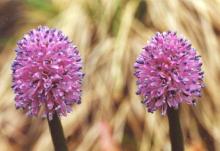
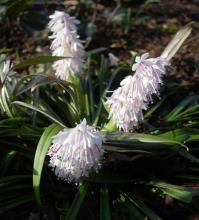
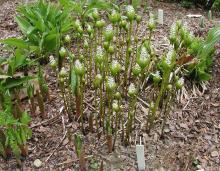
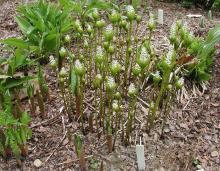
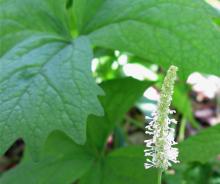
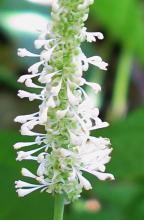
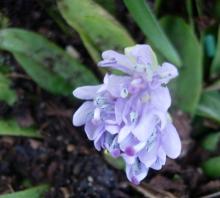
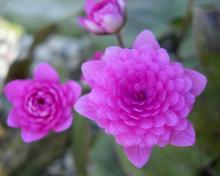
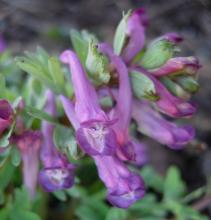
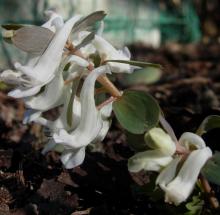
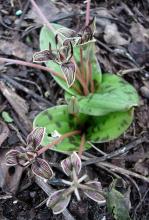
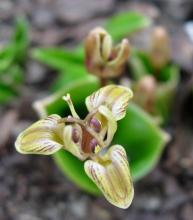
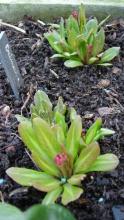
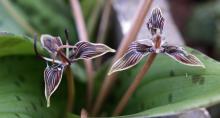
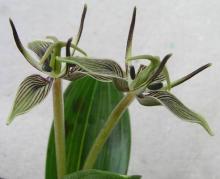

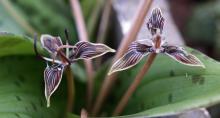
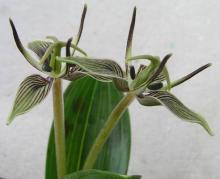
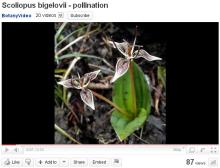
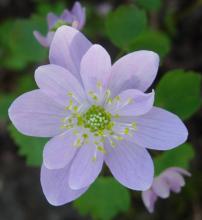
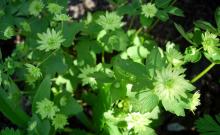

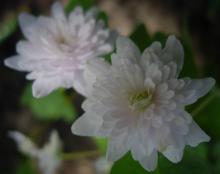
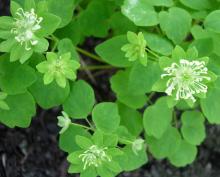
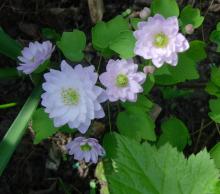
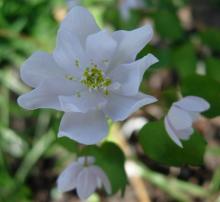
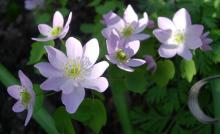
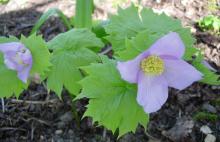
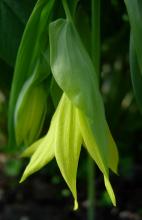
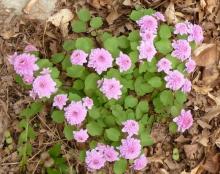

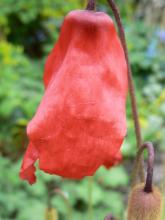
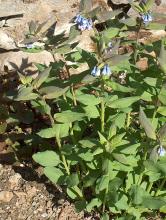
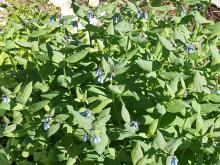
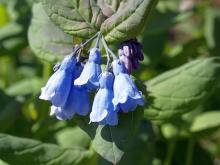
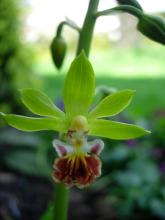
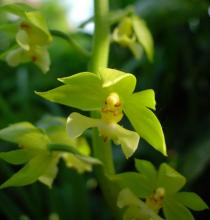
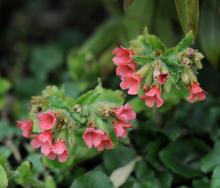
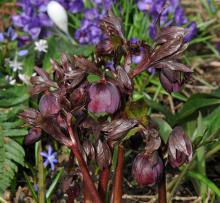
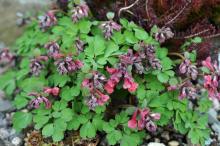
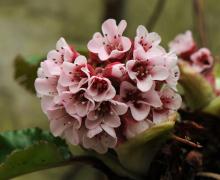
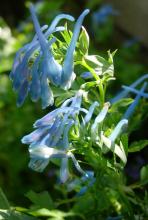
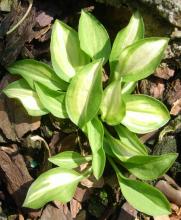
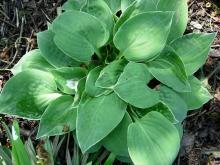
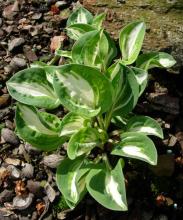
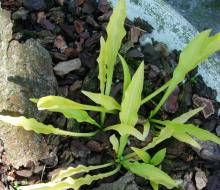
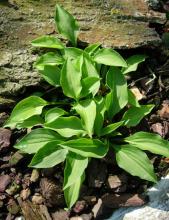
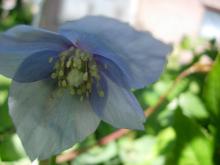
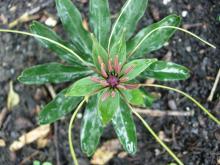
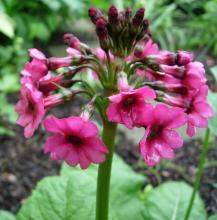
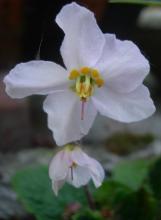
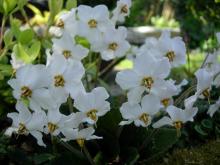
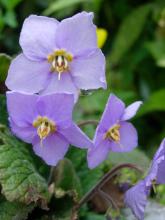
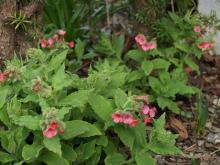
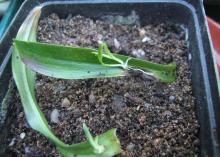
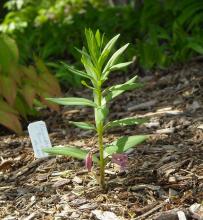
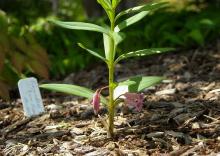
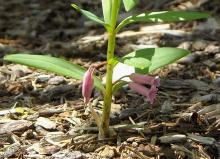
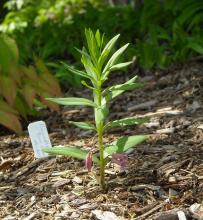
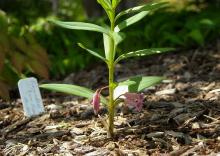
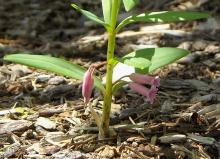
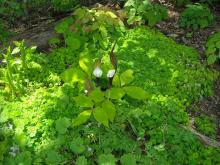
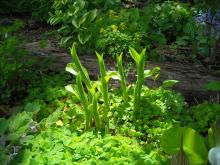
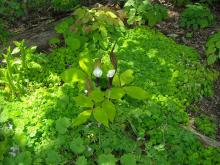
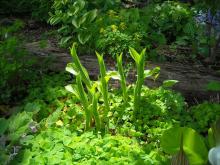
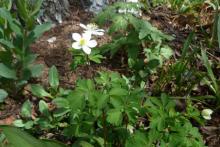
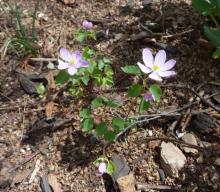
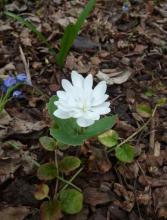
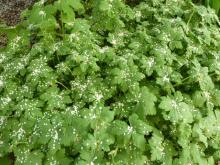
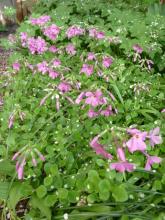
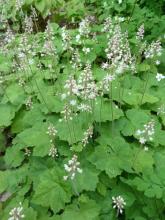
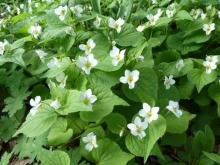
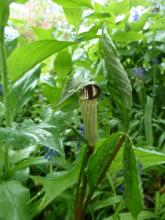
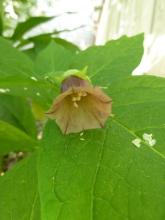
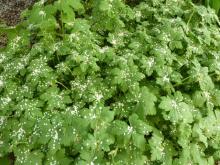
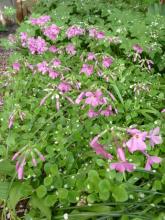
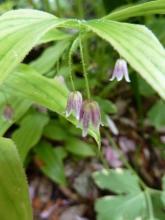
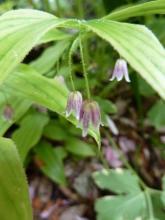
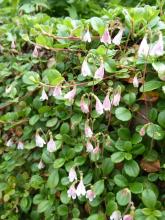
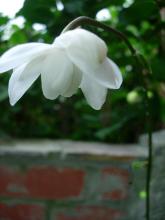
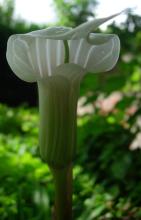
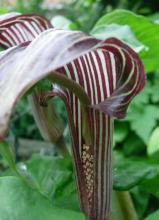


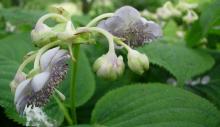
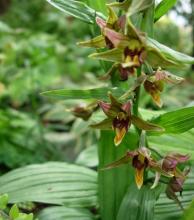
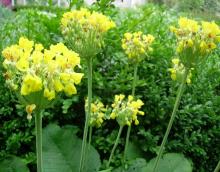
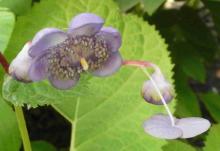
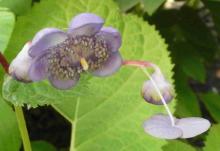
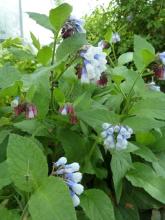
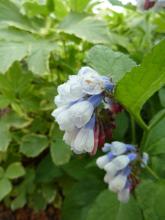
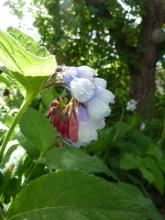
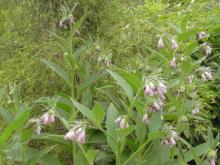
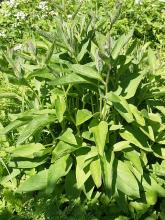
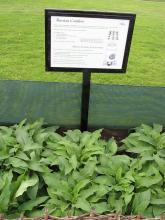

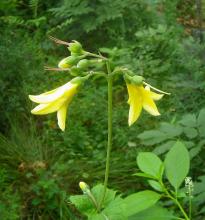
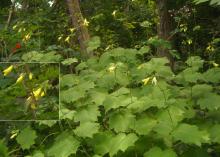
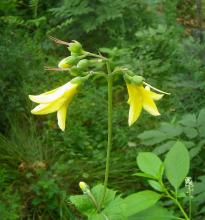
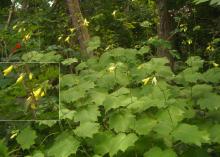
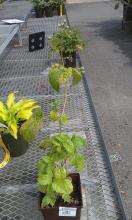
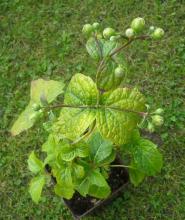
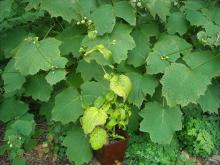
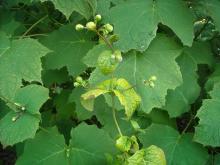

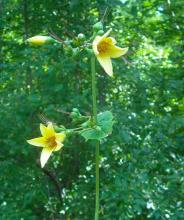

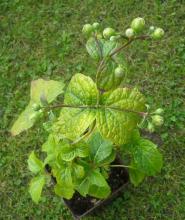
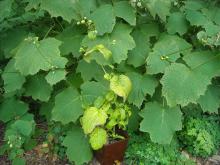
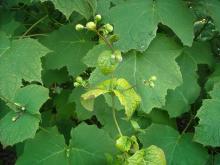
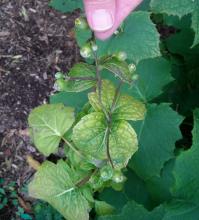
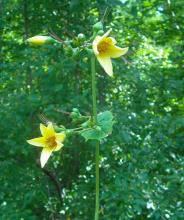
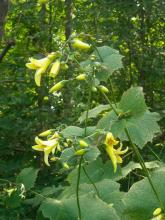
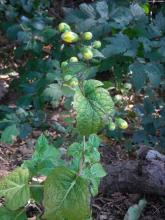
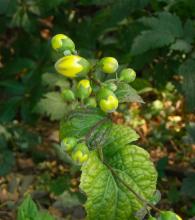
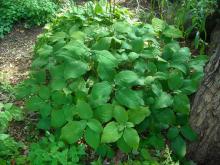
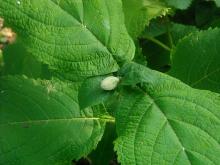
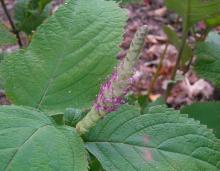
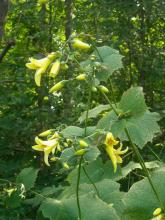
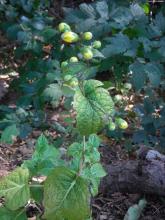
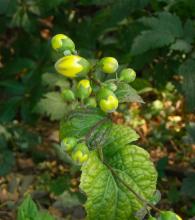
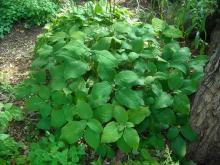
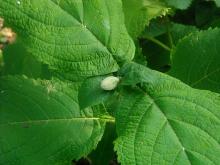
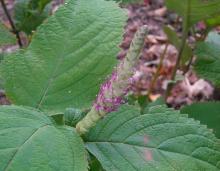
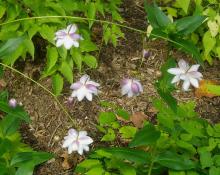
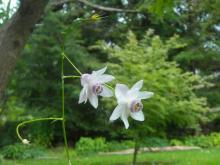
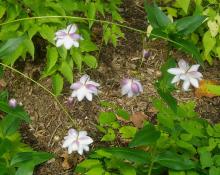
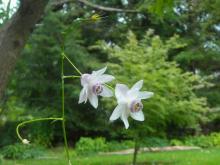
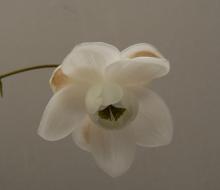

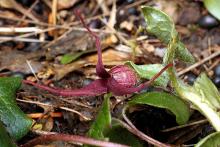
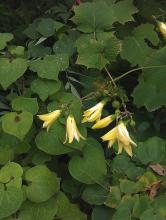
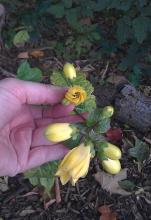
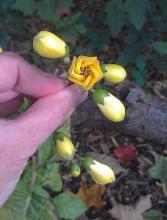
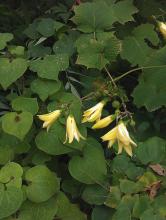
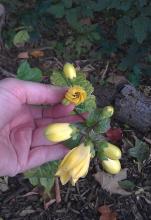

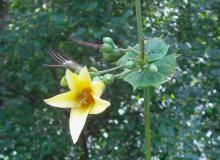
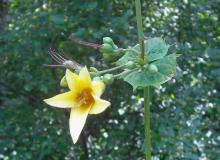
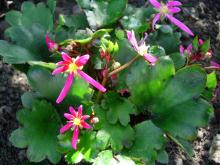
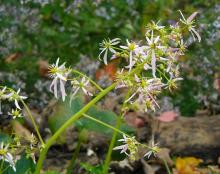
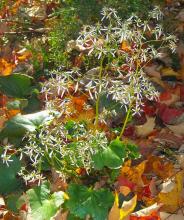
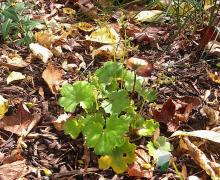
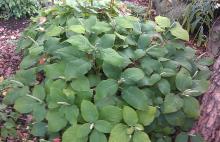
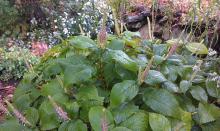
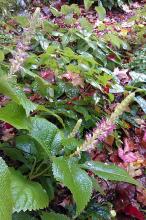
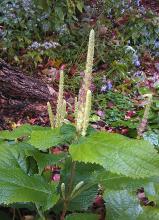
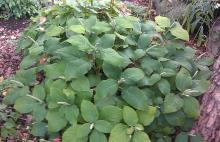
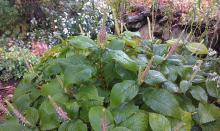
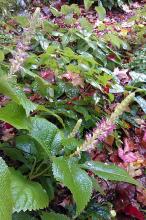
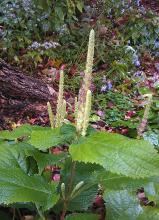
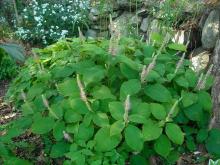
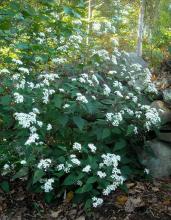
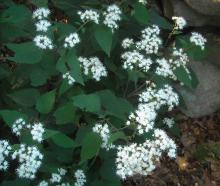
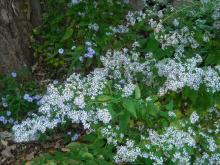
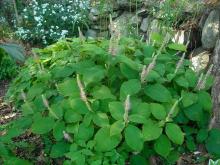
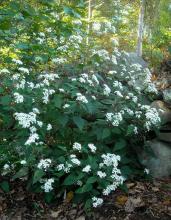
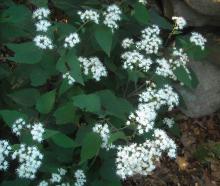
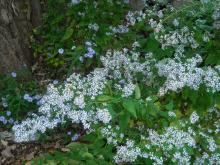
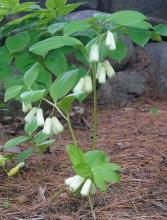
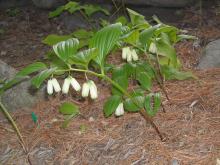
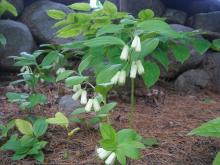
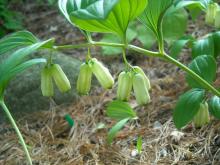
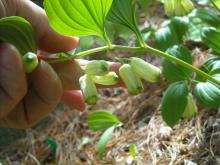
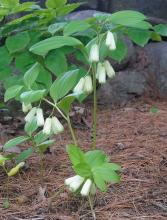
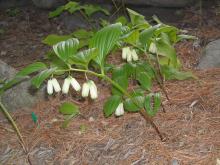
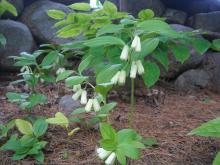
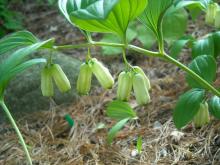
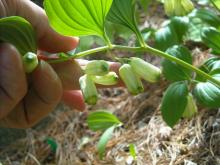
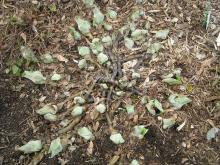
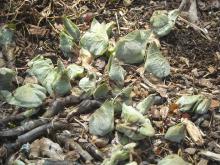
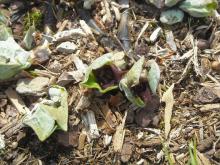
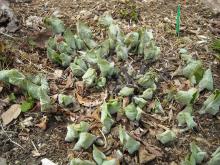
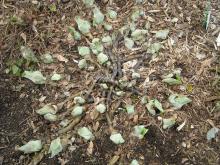
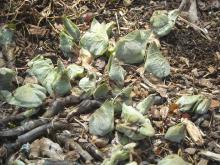
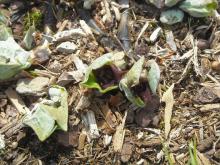
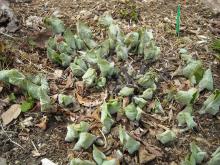
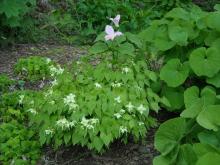

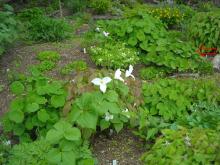
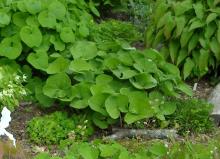
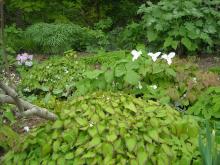
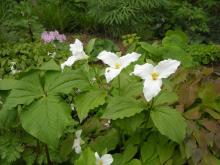
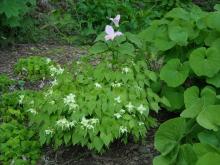
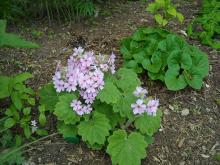
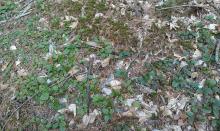
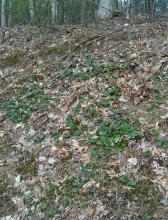
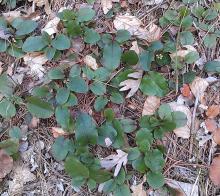
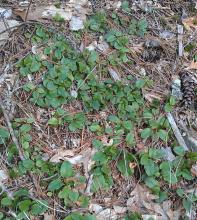
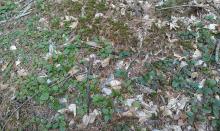
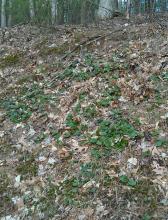
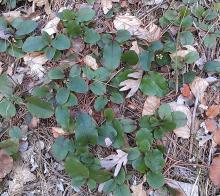
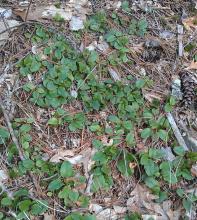
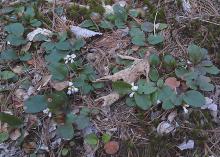
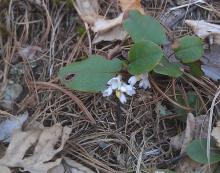
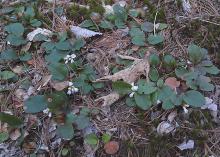
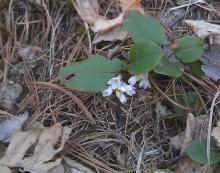
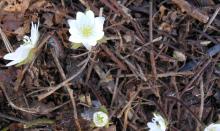
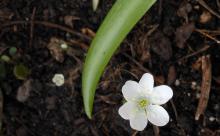
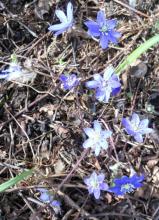
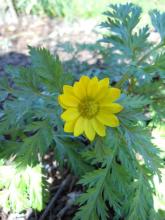
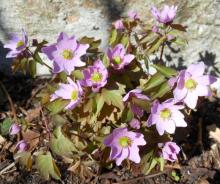
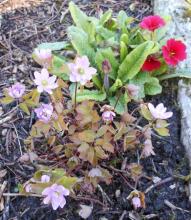
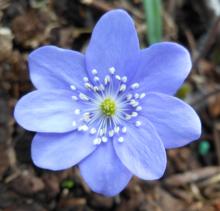
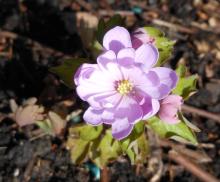
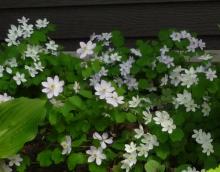
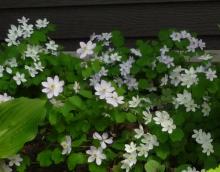
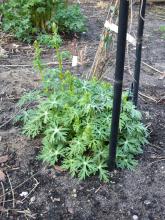
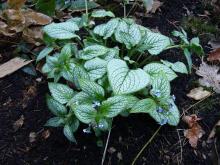
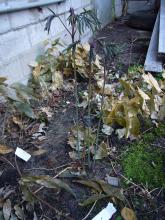
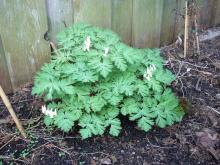
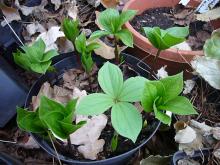
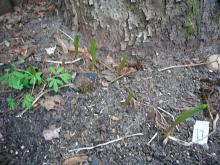
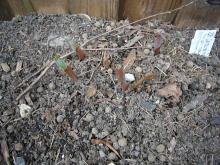
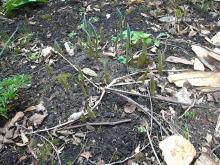
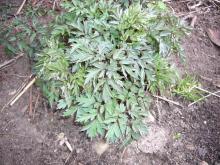
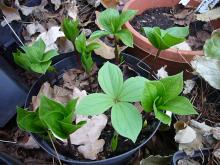
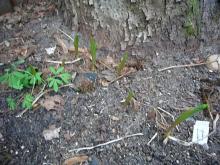

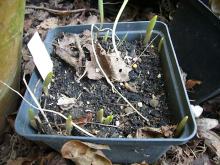

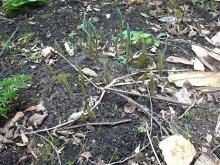
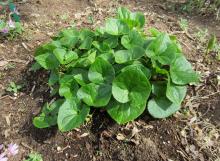
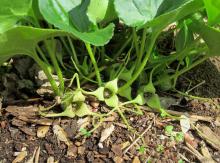
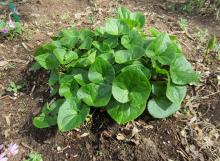
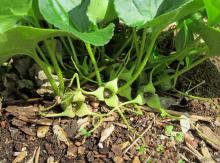
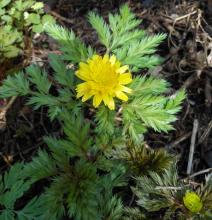
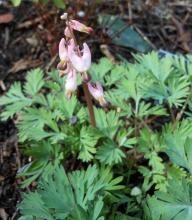
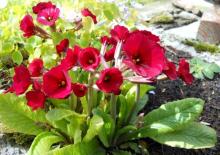
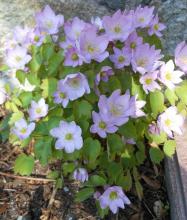
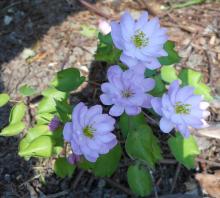
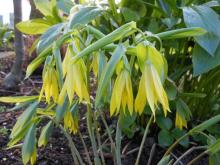
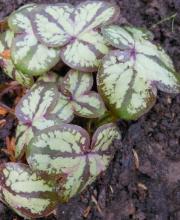
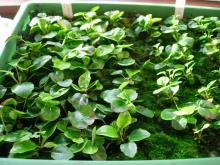
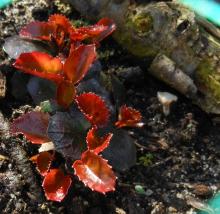
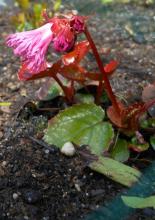
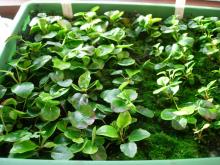
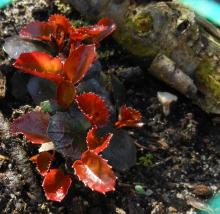
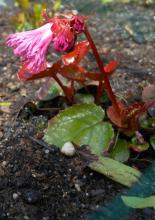
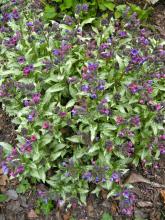
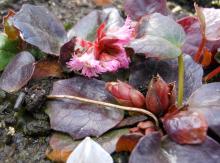
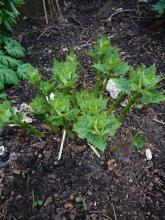
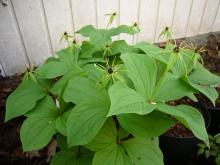
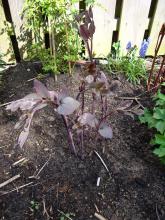
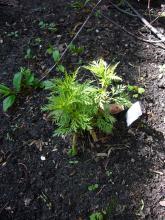
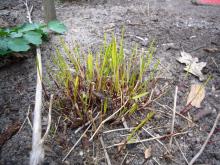
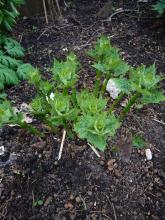
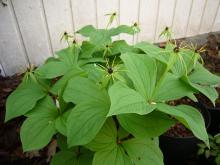
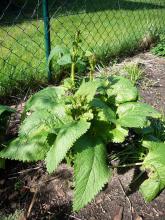
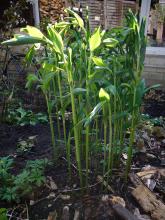
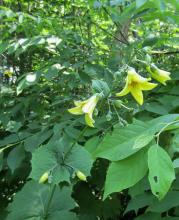
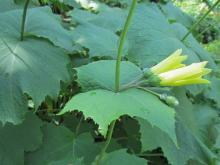
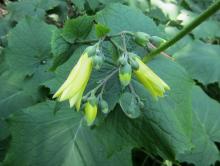
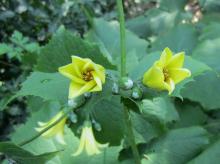
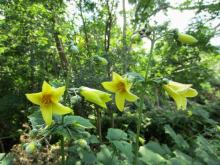
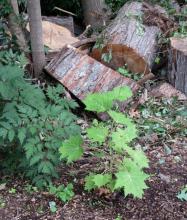
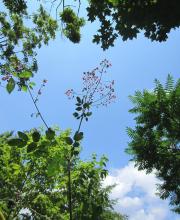
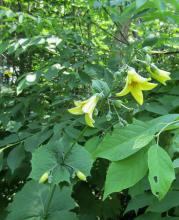
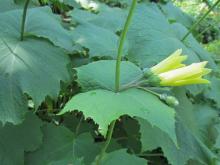
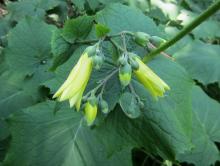
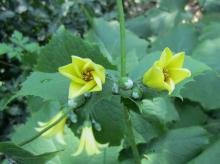

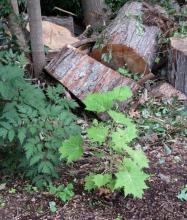
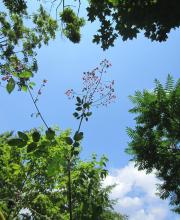
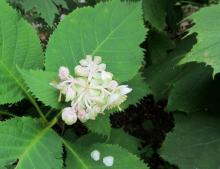

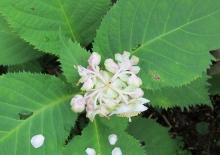
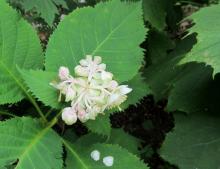
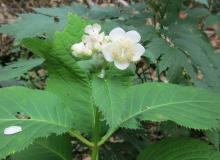

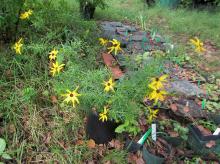
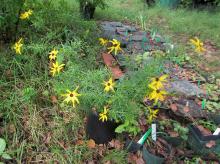
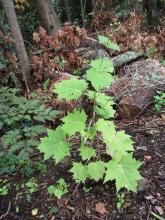
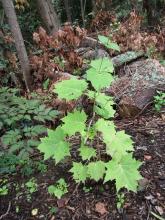
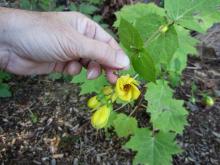
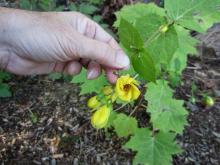
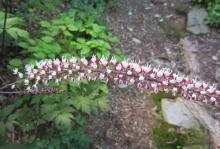
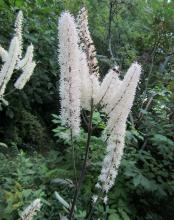
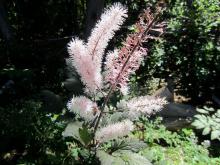
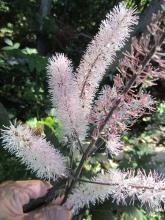
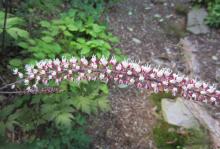
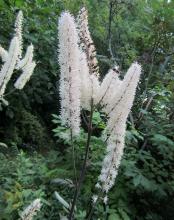
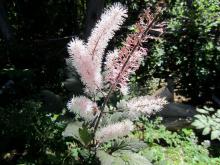
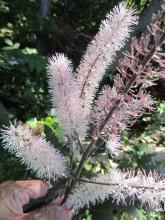
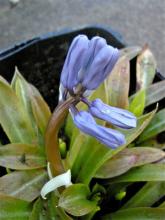
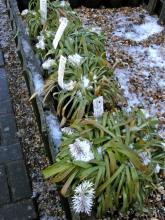
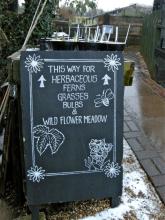
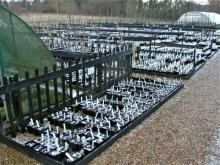
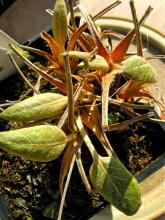
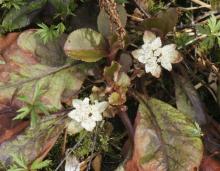
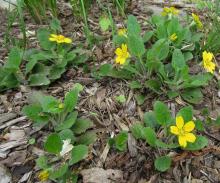
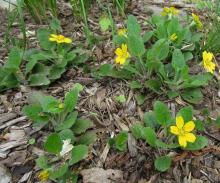
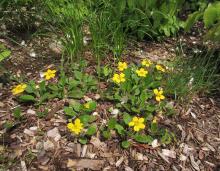
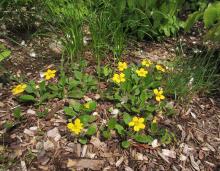
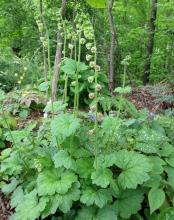
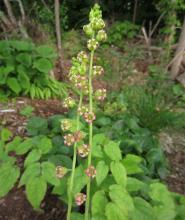
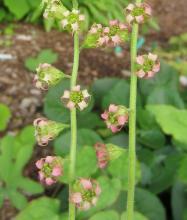
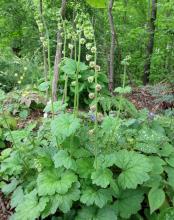
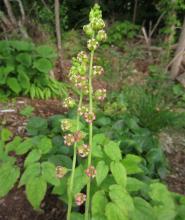
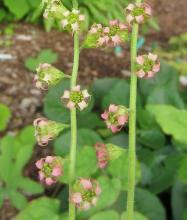
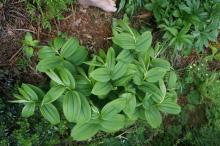
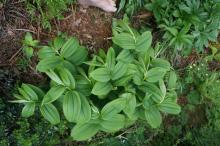




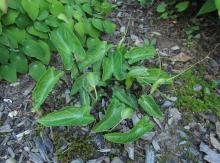
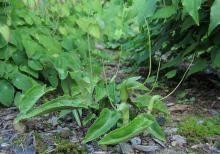
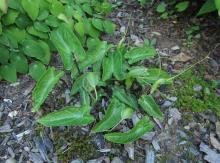
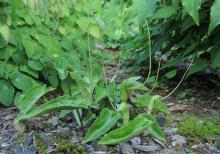

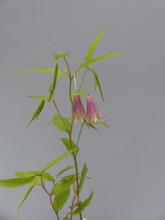
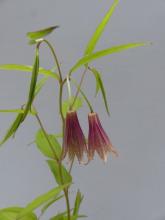
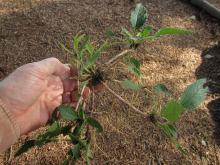
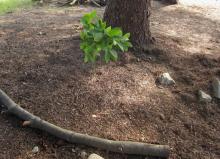
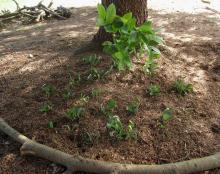
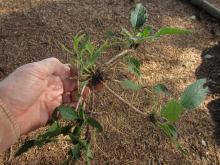
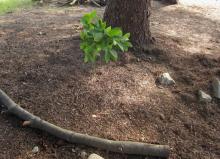
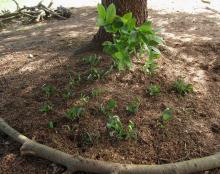
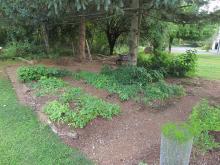
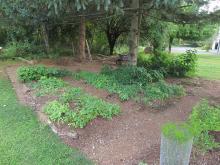
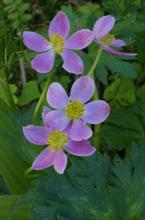
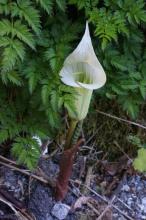
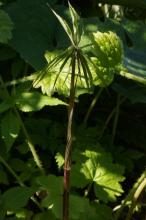
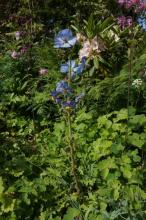
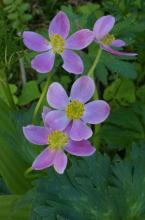
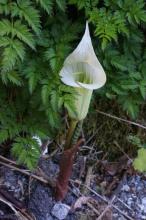
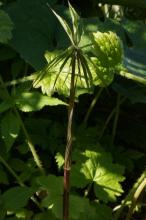
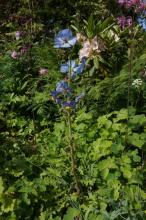
Wim, I've been admiring photos of this unusual genus over on SRGC, seems to be a popular genus in Europe, I have never met seen this plant in North American gardeners, although I don't "get out that much". This is a genus I must look into, as I like small (and early blooming) Liliaceae for the woodland; thanks for showing this one. Did you grow yours from seed, if so, how long to get a plant to flower? What are the plant's moisture requirements, wondering how it would do in my dry woodland conditions.